Today these films are considered tame as compared with the slasher and horror films my 13 year old granddaughter watches. This article is a look at the first 67 years of WEREWOLF motion pictures, before that genre changed direction after Joe Dante's excellent "The Howling", on April 10, 1981, with more realistic transformations. While I enjoy those special effects and CGI transformations. I admittedly long for the more make-up applied of the following features.
In some of these years I will mention. There were several werewolf features and in others not a one, or with a decade between the second and third pictures.
WHERE DID THE WEREWOLF COME FROM?
He, or she are not just people in need of a haircut and shave. They suffer from what is known as LYCANTHROPY . The Oxford Dictionary defines the term as:
The Supernatural Transformation of a person into a wolf, as recounted in Folk Tales.So were did the word originate? The first known story of a Werewolf goes back to ancient Greece and a myth about their God Zeus. The other person involved was Lycaon of Arcadia the son of Pelasgus and Meliboea. He was a prankster and made the mistake of playing one on the King of the Gods.
Lycaon had 50 sons according to the Greek Myth and wanted to know if Zeus was really "All Knowing". So he served Zeus the roasted flesh of his son Nyctimus to see if Zeus realized what he was eating. In punishment Zeus turned Lyacon into a wolf along with his remaining 49 sons. Then he brought Nyctimus back to life.
Over the decades many countries created tales of men and women becoming wolves. Two famous pieces of literature are considered in reality tales of werewolf's. The Brothers Grimm's fairy tale "Little Red Riding Hood" written in 1812 and actually going back to the 10th Century. Along with Robert Lewis Stevenson's "The Strange Case of Dr. Jekyll and Mr. Hyde" written in1886.
THE FIRST WEREWOLF MOTION PICTURES
However, this is not an article on literature, but motion pictures and the first such film was a silent short "The Werewolf", December 13, 1913. The picture was produced by the Bison Film Company and released by what was known, at the time, as Universal Films.
The screenplay was based upon the short story "The Werewolves", from 1898, by Henry Beaugrand. Which in turn was based upon an actual Native American legend. It tells of a Navajo women, "Kee-On-Ee", played by Marie Walcamp, as a young women and Lule Warrenton years later, becoming a witch. After believing her husband abandoned her. "Kee-On-Ee" teaches her daughter "Watuma", played by Phyllis Gordon, these skills and the daughter turns into a wolf to kill invading white settlers.
The motion picture is "Lost" and just a few stills and publicity shots remain.


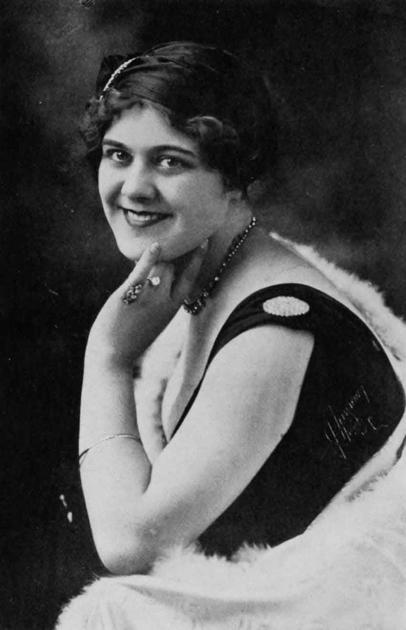
Above is a publicity still of Phyllis Gordon who technically became Universal Studio's first on screen monster. The following link is to a short article about 1913's "The Werewolf" and Miss Gordon.
http://www.santafenewmexican.com/pasatiempo/movies/silence-of-the-wolves-the-werewolf/article_45d8f1bc-419f-11e7-8c02-6f592742efc8.html
The second motion picture, also released by Universal, was "Wolf Blood", April 16, 1925, set in Canada about rival logging companies in a feud that has turned bloody. The foreman of the "Ford Logging Company", "Dick Benedict", played by George Chesbro, is attacked and left for dead. A doctor realizes he needs a transfusion and not having human blood substitutes wolf blood.
The character of "Bannister" will have dreams of running with a pack of phantom wolves. In each morning he finds different members of the rival company, who attacked him, dead from animal attacks.. The other lumberjacks of both companies decide that "Dick Bannister" is a werewolf.
Then came a decade of non werewolf films from Universal Pictures. The picture wasn't designed as a true "Horror" movie, but in 1923 Universal Studios made "The Hunchback of Notre Dame" starring Lon Chaney. Two years later Chaney was back as "The Phantom of the Opera". While in 1927 Laura La Plante was in the Horror Comedy "The Cat and the Canary". Remade in 1930 as "The Cat Creeps" with Helen Twelvetrees and Neil Hamilton. The future "Commissioner Gordon" on television's camp "Batman".
In 1931, the son of the studio's owner, Carl Lammele, Jr., known on the Lot just as "Junior", convinced his father to let him film some of his favorite Horror stories. "Senior" wasn't convinced of the value of such films, but gave his "OK". "Junior's" first two pictures were Bela Lugosi as "Dracula" and Boris Karloff as the "Frankenstein" monster. In 1932 he brought together Karloff, Melvyn Douglas, Charles Laughton, Raymond Massey and Ernest Thesiger in "The Old Dark House". That same year Boris Karloff played the title role of "The Mummy" another of Lammele, Jr.'s pet projects. In 1933 "Junior" cast the unknown Claude Rains as H.G. Wells' "The Invisible Man", because he liked Rains' distinctive voice.
Carl Lammele, Jr's next project was 1934's "The Black Cat" pairing Karloff and Lugosi in a sadistic tale of a man obsessed with Edgar Allan Poe. In 1935 "Junior" brought back Boris Karloff and Colin Clive. Added in Ernest Thesiger and Elsa Lanchester and created "The Bride of Frankenstein".
Searching for new thills Universal Studio assigned Stanley Bergerman to be Executive Producer on another Horror entry.
THE WEREWOLF OF LONDON (MAY 13, 1935)
_03.jpg)
Stanley Bergerman had been the Associate Producer on Universal's "The Mummy" and later in 1935 he would stop producing motion pictures after making "The Raven". Bergerman changed to the more lucrative professional of Talent Agent. Which was helpful for Universal Studios obtaining quality talent at a low price, because Stanley was married to Rosabelle Laemmele/ The daughter of "Senior" and sister of "Junior".
The 1935 story Bergerman chose, before becoming a talent agent, was by his Associate Producer Robert Harris. There is very little biographical information on Harris. He's listed as the producer for the 1931 "Fu Manhu" movie "Daughter of the Dragon" starring Warner Oland. Then there is nothing about him until 1935. When Harris is listed as an Associate Producer for "The Bride of Frankenstein" followed by this film. Again nothing for two years and then he is shown as producing the 1937 "When's Your Birthday?" A comedy starring Joe E. Brown and after that entry, on any website, Robert Harris just vanishes.
The actual screenplay was credited to John Colton. He had written the Broadway play based upon a W. Somerset Maugham's novella "Rain". Which was turned into a 1932 Joan Crawford motion picture. One stage the role was portrayed by fascinating actress Jeannie Eagles. Suggestion: see the bio pick on Eagles starring Kim Novak. John Colton wrote three other Broadway plays that were turned into motion pictures. Among his screenplays "Werewolf of London" was followed by "The Invisible Ray" and "Gunga Din".
Before Lon Chaney, Jr. became the "Classic Universal Werewolf". There were Henry Hull and Warner Oland. Hull portrayed "Dr. Glendon" a world-renowned botanist. He travels to Tibet in search of a rare plant called the mariphasa. In this tale it is not wolfbane, but the mariphasa plant that is associated with werewolves and the sap of this plant keeps a person from becoming transforming.
Henry Hull had been acting since 1917 and his most important motion picture role prior to this picture was as "Abel Magwitch" in the first sound production of Charles Dickens' "Great Expectation". That 1934 feature from Universal Pictures featured a young Jane Wyatt 20 years before she became Robert Young's wife on the television series "Father Knows Best".
After "The Werewolf of London" Hull would be seen in both 1939's "Jesse James" starring Tyrone Power and Henry Fonda and repeat his role in 1940's "The Return of Frank James" starring Fonda. Hull would also be seen, among his 114 screen and television credits, in 1941's "High Sierra" starring Humphrey Bogart and written by John Huston. Henry Hull was also one of the passengers aboard Alfred Hitchcock's "Lifeboat" in 1944.
_04.jpg)
Swedish born Warland Oland once again portrayed an oriental role as "Dr. Yogami". When "Glendon" and "Yogami" first meet.in Tibet. "Dr. Yogami" is the werewolf that attacks "Glendon".
Below Hull and Oland.
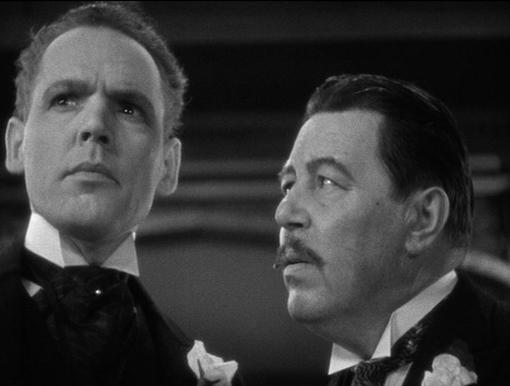
Warner Oland's career included playing Al Jolson's father in 1927's "The Jazz Singer", Fu Manchu in Daughter of the Dragon" and Charlie Chan in a highly successful series of features. My article on his life can be read at:
http://www.bewaretheblog.com/2017/04/warner-oland-jewish-cantor-werewolf.html
"Werewolf of London" was make-up artist Jack Pierce's first man into wolf feature. Originally he designed the same make-up he would use for Lon Chaney, Jr, but their are two stories as to why this was changed.
One story states that actor Henry Hull argued that according to the screenplay. Even in the form of a werewolf the audience knows it's "Dr. Glendon". The other is that the studio executives thought the make-up too costly. As the studio's money was going into "The Bride of Frankenstein" with both Karloff and Elsa Lanchester needing extensive make-ups. So Pierce was forced to minimize the werewolf look to the one seen in the picture. A make-up that emphasized Henry Hull's own facial features to some degree and I believe was very effective
Below this picture of Pierce's first werewolf make-up seen in the film.

There is a controversy over IF Warner Oland actually is seen above and not another actor. Whomever this was the scene at least show's "Dr. Yogami" in wolf form before he bites "Dr. Glendon".
Dr. Glendon returns home to London and his loving wife "Lisa Glendon". She is portrayed by actress Valerie Hobson. Who was very busy in 1935 by also portraying "Elizabeth Frankenstein", the role originated by Mae Clarke in 1931, and "Helena Landless" in the Claude Rains vehicle "The Mystery of Edwin Drood".
_07.jpg)
Below the meeting with "Dr, Yogami". As "Dr, Glendon" hears the story of how both men met and are now werewolves.

"Glendon" disbelieves the story, but when his hand goes under the simulated moon light to get his mariphasa specimen to bloom. Suddenly it turns into that of a wolf, but once out of the light it returns to normal.
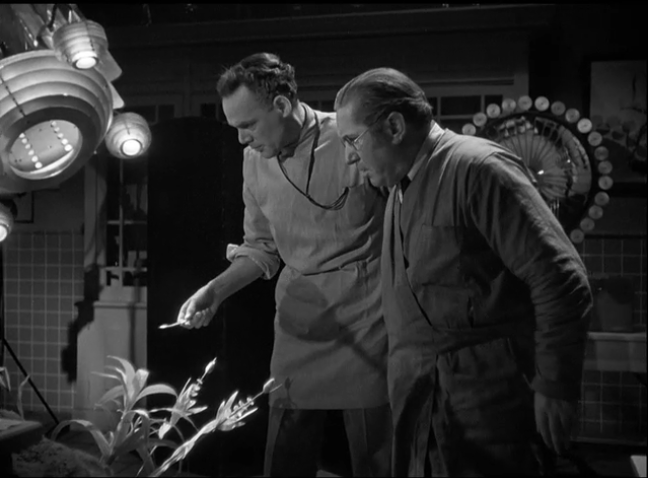
As I said only the sap from the plant can prevent a person from turning into a wolf. "Glendon's" plant will have three flowers. Two do bloom and "Dr. Yogami" gets into "Dr/Glendon's" laboratory and steals them. "Glendon" starts to transform and leaving his house seeks his first victim.


The career of Jack Pierce, the creator of all the classic Universal Monsters of the 1930's and 1940's, is very interesting. In 1948 the new owners of Universal Studios would replace him with the more economical Bud Westmore. This really started with the comedy "Abbott and Costello Meet Frankenstein". What happened after being fired is also part of my article on Pierce's life and creations:
http://www.bewaretheblog.com/2015/06/jack-p-pierce-man-who-created-monsters.html
Returning to "The Werewolf of London". There will be a climatic fight between "Dr. Glendon's" werewolf and "Dr. Yogami" over that last mariphasa blossom.


After killing "Dr Yogami", Henry Hull heads for Glendon Manor. Outside he confronts "Paul Ames", Lester Matthews, his wife's childhood sweetheart and his friend. He doesn't kill him, but goes into the manor looking for "Lisa".

Here is were the screenplay first establishes a rule for movie werewolves. They will instinctively want to kill the one they love.
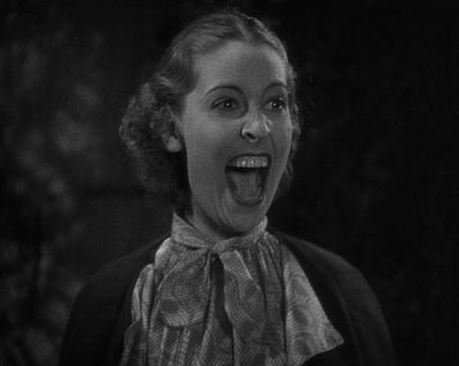
Just in time "Paul's" Uncle, "Sir Thomas Forsythe", Lawrence Grant, of Scotland Yard arrives with several police officers. They shoot the werewolf and as "Dr. Glendon", still as a werewolf, is dying. He first thanks "Forsythe" for the "merciful bullet" and than tells "Lisa" he wishes he could have made her happier.
What no Silver Bullets, or poems about the moon? That was to come next when screenwriter Curt Siodmak created the definitive werewolf story.
At the time of this film's release. Frank S. Nugent reviewing the "Werewolf of London" for the New York Times said:
Designed solely to amaze and horrify, the film goes about its task with commendable thoroughness, sparing no grisly detail and springing from scene to scene with even greater ease than that oft attributed to the daring young aerialist. Granting that the central idea has been used before, the picture still rates the attention of action-and-horror enthusiasts.I enjoy this film and as to Henry Hull's make-up which is still discussed pro and con.
Six years later Jack Pierce got his wish for his werewolf's look.
THE WOLFMAN (DECEMBER 12, 1941)

My reader may not recognize the name Curt Siodmak, but they probably know one of two variations of the following words:
Even a man who is pure in heart, and says his prayers by night;
May become a wolf when the wolfbane blooms and the autumn moon is bright.
Universal Studios assigned producer and director George Waggner to make their next werewolf motion picture in both capacities. As a director Waggner would make two John Wayne pictures "The Fighting Kentuckian" and "Operation Pacific". He directed several "B" Westerns and just prior to "The Wolfman" directed Lon Chaney, Jr. as the "Man Made-Monster". After this picture Waggner directed Boris Karloff in "The Climax". In the 1950's George Waggner would switch to television and among his work were seven episodes of "The Man from Uncle" and ten episodes of the camp "Batman".
Waggner thought of Lon Chaney, Jr. for the role of "Lawrence Talbot" after re-watching the actor as the dim witted "Lenny" in the 1939 filmed version of John Steinbeck's "Of Mice and Men". Besides "Of Mice and Men", Lon, had been seen as a heavy in many "B" Westerns and the 1936 science fiction serial "Undersea Kingdom". Lon portrayed Victor Mature's father in the pretty much silent 1940 motion picture "One Million B.C.", but before casting. George Waggner needed a screenplay and that's were Curt Siodmak created the definitive werewolf story
Curt wrote the previously mentioned "The Climax". A film that originally was conceived as a sequel to Universal's 1943 "The Phantom of the Opera", but the studio decided against it. Siodmak was given the problem of changing the concept into another film for Boris Karloff. A classic for Peter Lorre was Curt's 1946 "The Beast with Five Fingers".
Contrary to many accounts that even state it was an old European poem. It was Curt Siodmak that came up with those famous lines Evelyn Ankers' "Gwen Conlife" quotes to Lon Chaney, Jr's "Lawrence Talbot". Note that the above poem does not refer to a person changing under a full moon, but transforms from human to werewolf when the:
the wolfbane bloomsThe oft quoted change to those lines would come later from another Curt Siodmak screenplay I will mention.
For those of my readers interested in the careers of both Curt and Robert known for their Science Fiction and Film Noir motion pictures. You can read about the brothers at:
http://www.bewaretheblog.com/2017/11/curt-and-robert-siodmak-horror-and-film.html
"The Wolfman" gave make-up artist Jack Pierce the go ahead to create his original werewolf concept.
The very obvious change is that once Lon Chaney, Jr. is fully transformed. Unlike Henry Hull in "The Werewolf of London" the audience can't tell the werewolf is still Lon.
"Lawrence Talbot" is welcomed home by his father "Sir John Talbot" portrayed by Claude Rains. Should my reader not be aware Siodmak indicated in the screenplay that the Talbot Ancestral manor house was located in Lianwelly, Wales an actual place.

At this point in his career Claude Rains had appeared as "Prince John" in the Errol Flynn and Oliva DeHavilland "Adventures of Robin Hood", as "Napoleon III" in "Juarez" and the angel guide in "Here Comes Mr. Jordon".
Walking through the village "Larry" enters an antique store and meets "Gwen". There he picks out a cane with an unusual image on the handle shaped like the body of a wolf..
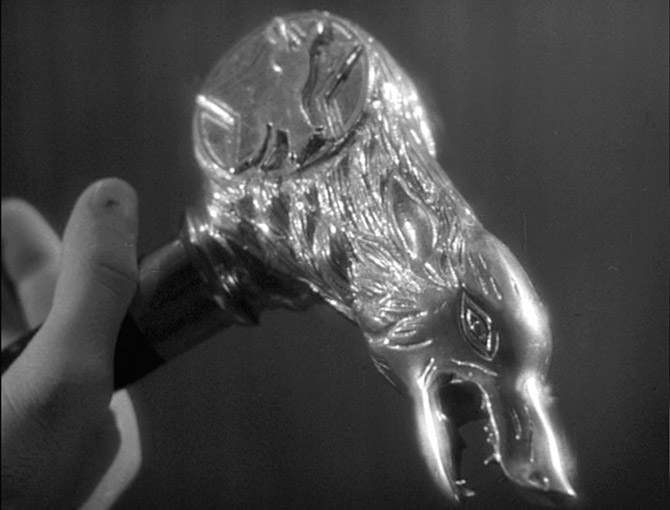
"Gwen" explains the image by quoting Curt's poem. After introductions the two decide to go to a gypsy encampment that night, but "Gwen" insists on taking her friend "Jenny Williams", Fay Helm. At this point in her career Evelyn Ankers had been seen in many non screen credited roles in "B" movies. She would follow "The Wolfman" with "The Ghost of Frankenstein", "Sherlock Holmes and the Voice of Terror", "Son of Dracula" and "The Invisible Man's Revenge".

At the encampment the three see "Bela", Bela Lugosi, the son of an old gypsy fortuneteller. Since 1931's "Dracula" Lugosi had been in some very good and some very bad films. On the good side were 1932's under appreciated "White Zombie" and the same years "Island of Lost Souls". In 1934 it was "The Black Cat". The there was, I hate the ending. Todd Browning's "Mark of the Vampire" in 1935 and, surprise, Bela as a good guy in that same year's "The Raven" opposite Karloff. On the other side were films like "50 Million Frenchmen" and "Women of All Nations" released in 1931 right after "Dracula". In both films Bela received no on screen credit. but in that second picture. There was no on screen credit for comedian Mischa Auer and a guy named Humphrey Bogart. Both of those actors had their scenes deleted from the finished motion picture.
The fortuneteller "Maleva" portrayed beautifully by Maria Ouspenskaya sees that "Jenny" is doomed to die by her son's bite, but lies to the young women. Curt Siodmak has the werewolf see the symbol, a variation of the pentagram, on the cane as a means of identifying their next victim. Bela Lugosi in that short scene shows the sadness he feels over what he is forced to do. A prime example of how underrated he was by Carl Lammele, Sr. and the other studio heads as an actor.
Later "Jenny" is attacked by a wolf and "Larry" kills it, but is bitten.

The authorities find the body of "Bela" and believe "Larry" acted for the safety of the now dead "Jenny". No one believes his story of being attacked by a wolf and he goes back to the gypsy camp and "Maleva". She tells "Larry" that he did kill a wolf, but a werewolf and as he has lived. He will also become one.
Of course he doesn't believe her and that night the first transformation takes place. "The Wolfman" will kill a grave digger and "Lawrence Talbot" will start to think he's going insane.
When you watch the film again. You will note that you do not see the on screen complete transformation as in future motion pictures from human to werewolf. In this film the audience only sees a series of cuts back and forth at different stages of Jack Pierce's make-up. However, our imaginations kick in.
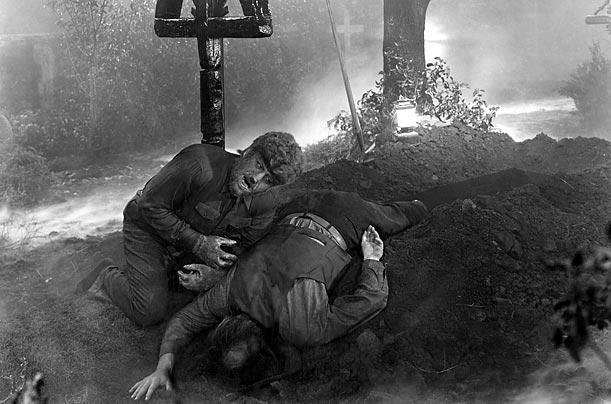
A friend of his father is "Colonel Paul Montford", Ralph Bellamy, who is also the police. Bellamy appeared in several "B" Detective thrillers and some comedy films. Two of those were with Cary Grant and he kept returning to the stage. For Universal Studios he would reunite with Lon Chaney, Jr., Bela Lugosi and Evelyn Ankers in "The Ghost of Frankenstein".
"Larry"s" father, "Colonel Montford" and "Doctor Lloyd", portrayed by Warren William, attempt to get him to realize he is just upset over all the folk tales of the area and is not a werewolf.
Warren William was a familiar face to audiences. Up to this point among his work was "Julius Caesar" in Cecil B. DeMille's 1934 "Cleopatra" starring Claudette Colbert. He was the first actor to portray "Perry Mason" and was seen in the role four times. Another series role was as "Michael Lanyard" the reformed jewel thief known as "The Lone Wolf". William was "Lanyard" in the first eight in the film series.
Of course nobody, but "Maleva" understands the torment "Lawrence Talbot" is going through and between Siodmak's screenplay and Chaney's acting. The audience feels for this young man cursed to kill and kill again.
"Maleva" is leaving with the other gypsies, but goes to see "Sir John" to tell him what he does not want to hear. The stories are true and his son is the killer and does turn into a wolf. Only silver, there is no silver bullet yet, will bring "PEACE" to the person who has the mark of the wolf upon them.
_15.jpg)
However, "Larry" has seemed to recover and no more attacks occur. He goes out and meets again with "Gwen", but then sees the symbol upon her palm. That night "The Wolfman" goes after the women he has fallen in love with.
Following his son it will be "Sir John Talbot" that will kill him. By hitting his son's head with the silver wolf head cane.

There is no bloody scene, horrific transformation and mutilated bodies, but this film stands as the classic werewolf tale others copied. It is also one that makes many members of the audience shed a tear for "Lawrence Talbot", because as in "Of Mice and Men". Lon Chaney, Jr. knew his subject matter. The following link will take you to my biography of the actor "OF MICE AND WEREWOLVES":
http://www.bewaretheblog.com/2016/05/lon-chaney-jr-of-mice-and-werewolves.html
THE UNDYING MONSTER AKA: THE HAMMOND MYSTERY (NOVEMBER 27, 1942)

Eleven months after "The Wolfman" premiered 20th Century Fox released their own werewolf motion picture. The movie was based upon a 1922 novel, I've read, by Jessie Douglas Kerruish with the interesting title of "The Undying Monster: A Tale of the Fifth Dimension".
Although Lillie Hayward and Michael Jacoby's screenplay changes a lot of the novel. To give my reader an idea of the story. Here is a quote from the website "Good Reads" about the novel's plot:
A Profound and Cosmic Werewolf Classic! Considered one of the most sophisticated and imaginative novels of lycanthropy ever written, Jessie Douglas Kerruish's spellbinder is the story of the Hammond family, which for centuries has been the prey of an undying monster that wreaks a hideous death on its victims and drives survivors to suicidal madness. An ancient rhyme declares; "Where grow pines and firs a main,/Under stars, sans heat or rain,/Chief of Hammand, beware thy bane.https://www.goodreads.com/book/show/3866498-the-undying-monster
One of the main reasons the story was changed is the movie is only 60 minutes long to tell a complicated and multifaceted tale. Also Lillie Hayward was known for Family stories not Horror. She wrote the screenplays for 1940's "The Biscuit Eater", 1943's "My Friend Flicka"and 1946's "Black Beauty". For Walt Disney Hayward wrote the screenplays for 1958's "Tonka" and the original 1959 "The Shaggy Dog". Even for Bert I. Gordon, Lillie Hayward wrote the screenplay for a movie he wanted to star his 11 year old daughter "The Boy and the Pirate" in 1960.
While Michael Jacoby only wrote a total of 17 screenplays. One was the Errol Flynn 1936 "The Charge of the Light Brigade". Jacoby basically wrote mystery screenplays which would help with this story. Such as 1940's "Doomed To Die" that starred Boris Karloff as Japanese Detective "James Lee Wong", but like his co-screenplay writer. Neither ever wrote a Horror story and this resulted in the audience having a pretty good idea, from the start, which Hammond was the werewolf.
The character who is investigating the legends of the Hammond family in the novel was Spiritualist "Luna Bartendale". She is changed to male Scotland Yard scientist "Robert Curtis" portrayed by James Ellison. Ellison career was mainly "B-" Westerns, because of his limited acting abilities. Along with "Curtis" comes his female side kick "Christy" played by Heather Thatcher. Thatcher was an English stage and movie comedy actress.

In the novel the two main Hammond's are brother and sister "Helga" and "Oliver". In this picture "Helga" was portrayed by Heather Angel. Angel was a British actress trained at the Old Vic and appeared in many British films before coming to the United States. She was the female lead in Basil Rathbone and Nigel Bruce's 1939 "The Hound of the Baskerville". In 1935 she had leads in "The Mystery of Edwin Drood", "The Three Musketeers" and John Ford's "The Informer". In 1936 Angel was opposite Randolph Scott in "The Last of the Mohicans", Alfred Hitchcock cast the actress as one of the passengers in his 1944 "Lifeboat". Angel voiced "Alice's Sister" in Walt Disney's 1951 animated "Alice in Wonderland" and voiced "Mary Darling" the mother of "John, Michael and Wendy" in Walt Disney's animated 1951 "Peter Pan".
"Oliver" was portrayed by American actor John Howard. Prior to World War 2 Howard was a major actor in projects such as Frank Capra's classic 1937 "Lost Horizon" starring Ronald Coleman and he co-starred in the Katharine Hepburn, Cary Grant and James Stewart 1940 "The Philadelphia Story". Howard entered the U.S. Navy during World War 2 and upon his return to Hollywood his roles were reduced.
I'm not putting down the production and the direction of John Brahm, He would go on to direct two outstanding Thrillers with Horror touches. They were 1944's "The Lodger" and "1945's "Hangeover Square". In 1954 Brahm directed Vincent Price in the 3-D feature "The Mad Magician".
Unfortunately in this screenplay the actual werewolf only shows itself during the last few minutes of the movie.
"The Undying Monster" is part of an article on five forgotten Horror and Thriller gems of 1940's I wrote about at:
http://www.bewaretheblog.com/2016/11/the-undying-monster-seventh-victim.html
CAT PEOPLE (DECEMBER 6, 1942)

A classic variation of the werewolf tale was brought to the screen by producer Val Lewton and director Jacques Tourneur. "Cat People" was the first motion picture produced by Val Lewton who would bring his audience such horror classics as "I Walked With A Zombie", "Isle of the Dead" and "Bedlam". The last two titles starring Boris Karloff. Lewton would produce director Robert Wise's version of Robert Louis Stevenson's "The Body Snatcher" with Karloff and in a very small role Bela Lugosi.
Lewton was the King of the low budget, high scare ratio feature. You thought you saw something, but maybe it wasn't there. It was the mood and lighting of the scene that played tricks on the audience. This technique was center stage in "Cat People".
For those of my readers who love the work of Val Lewton. My look at his life and films may be read at:
http://www.bewaretheblog.com/2015/10/val-lewton-master-of-subtle-terror-and.html
Paris, France born director Jacques Tourneur was also a master of the low budget film. Making them look better than some major productions and getting excellent performances even out of extras. Over his 75 film career would be a variety of genres. Besides "Cat People" for Lewton he directed the still very eerie "I Walked With A Zombie", and "The Leopard Man". Other of his work included the classic 1947 Film Noir "Out of the Past" starring Robert Mitchum, Burt Lancaster and Virginia Mayo in 1950's "The Flame and the Arrow" and 1959's Italian sword and sandal epic "The Giant of Marathon" starring Steve Reeves. Tourneur was the man behind the helm of the low keyed British Horror classic 1957's "Night of the Demon" aka: "Curse of the Demon" starring Dana Andrews.
"Cat People" opens at a zoo as Serbian born "Irena Dubrova" is making sketches of a black panther in its cage. Portraying "Irena" was French actress Simone Simon.

Simone Simon was a very popular actress in French films since 1931 and was brought to this country by 20th Century Fox. She was given only three weeks by the studio to learn English. She was placed in a motion picture opposite James Stewart and it flopped. She returned to France, but left France just before Hitler invaded and returned to Hollywood. In 1941 Val Lewton cast her as "Irena" and she would return as her apparent ghost in the 1942 psychological sequel "Curse of the Cat People" directed by Robert Wise for Lewton.
Below "Irena" is spotted by marine engineer "Oliver Reed" played by Kent Smith.

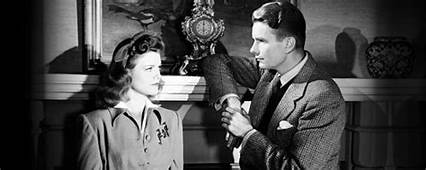
Smith was a solid "B" actor in many genres starting after the war. He also returned in his role of "Oliver Reed"in "Curse of the Cat People".
This low keyed horror story continues as the intrigued "Oliver" goes with "Irena" to her home. There he sees a statue of the real "King John of Serbia" with a large cat beside him. "Irena" relates the story and legend of evil associated with the "King" and his followers. Part of the legend tells of people turning into large cats, but "Oliver" dismisses it.
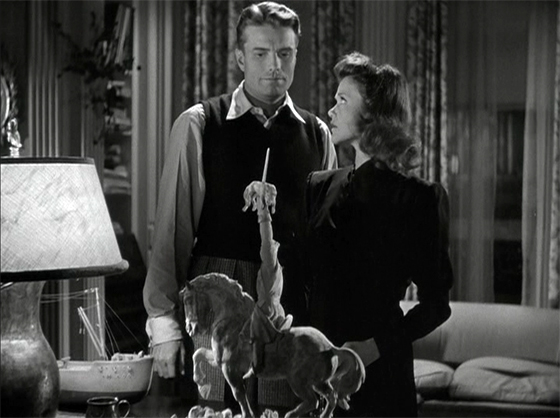
"Oliver" buys "Irena" a kitten, but when it comes near her. The kitten reacts in fear and "Irena" just says:
After their wedding at a Serbian restaurant a "Cat Like" women walks over to "Irena" and "Oliver" and addresses her as:
"Irena's" jealousy has been triggered and multiple deaths by some wild animal, or cat start. Is "Irena" turning into a black panther? The audience does not know as there is no transformation shown, but again there are shadows of a large cat walking.
"Cat People" is known for the swimming pool sequence. "Alice" is in the changing room for the pool in her apartment house's basement. She feels uneasy and then sees a black kitten, but it leaves. As "Alice" starts to leave the changing room for the pool area. She hears something on the staircase. Then the shadow of a panther is seen against the stairs. Without turning the lights on "Alice" drops her bathrobe and jumps into the swimming pool.
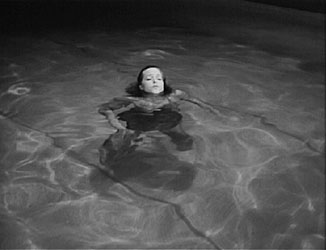
Treading water to keep herself in the center of the pool she feels something is stalking her.
Shadows of what appear to be a black panther move at times across the pool area's walls. Suddenly the lights are turned on and "Irena" stands there. "Irena" tells "Alice' that she's looking for "Oliver" and leaves.When "Alice" picks up her bathrobe it has burn torn to shreds as if by a large cat.
"Irena" has been seeing "Dr. Judd", played by Tom Conway, a psychiatrist for her dreams and fears of turning into a cat. Conway's last name was originally Sanders and he changed it. As as not to be confused with his brother actor George Sanders.
For RKO, but not producer Val Lewton, in 1942 was the motion picture "The Falcon's Brother". In which George Sanders portrayed sleuth "Guy Lawrence" aka: "The Falcon". Tom Conway appeared with brother George as "Tom Lawrence" "Guy"s" brother. At the end of the film George Sanders bowed out of the series after playing the title character for the first four motion picture. Brother Tom would star in the next nine films.
For Lewton, besides this picture, Tom Conway was in "I Walk With A Zombie" and "The Seventh Victim". The latter was made in 1943 with Tom Conway reprising his role of "Dr. Louis Judd". Because of that fact many Lewton buff's believe the second film's events proceeded "Cat People". As "Judd", who made the fatal mistake of having an affair with "Irena", is brutally murdered, off screen, by a black panther. Even though he was talking originally to "Irena" in his apartment.
After killing "Dr. Judd", "Irena" goes to the zoo and lets the black panther out of its cage. As it escapes confinement "Irena" is struck down and killed by it. The panther will be hit by a passing car. Cut back to the Zoo as "Oliver" and "Alice" arrive at the panther cage. Lying there is the body of another panther. "Oliver" turns to "Alice" and says:

FRANKENSTEIN MEETS THE WOLFMAN (MARCH 5, 1943)
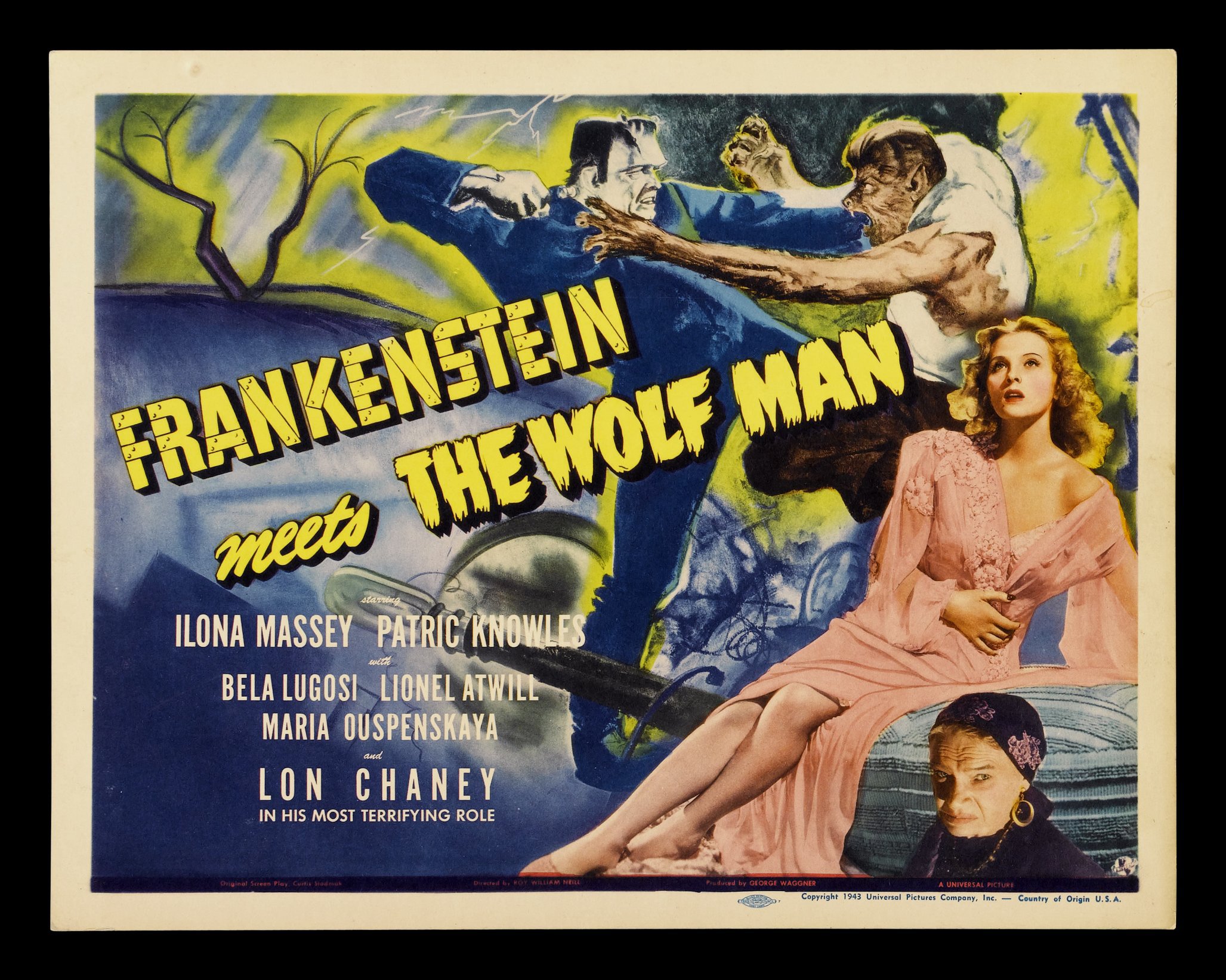
According to Curt Siodmak he was at lunch in the Universal Studio's commissary with producer George Waggner discussing potential projects. At the time Siodmak needed money for a new car and a screenplay would take care of it. It was obvious Waggner hadn't a clue of what he wanted. Curt joked he had a great title for a picture "Frankenstein Wolfs The Meat Man". Waggner left, but shortly afterwards called the writer to create the screenplay. The result was "Frankenstein Meets the Wolf Man".
As this news release poster clearly states the original idea Waggner had was to somehow case Lon Chaney, Jr. in both roles. Chaney had just played the monster in 1942's "The Ghost of Frankenstein".

Of course it would be Lon as "Larry Talbot" aka: "The Wolfman" and Bela as the "Frankenstein Monster". Lugosi hated the role. Originally he thought being in the fifth motion picture of the series and the third actor to play the part. He would have a chance to create his own version. However, George Waggner told him otherwise. In the previous film the dead "Ygor's", Lugosi, brain was placed in the monster to make it controllable and possibly able once again to speak. However, when he's brought to life the unexpected result is the monster is now blind. At that point Lon Chaney, Jr. started walking with his arms outstretched as if a blind person was feeling around their surroundings. Bela Lugosi was told he was to always walk like that throughout the film and not show originality.
Jack Pierce created the make-ups and unfortunately, in my opinion, Bela Lugosi had a very distinctive bone structure to his face and his "Frankenstein" monster looks like "Dracula" in many respects. Unlike "Ygor" with his beard covering part of Bela's face.
The story opens as two grave robbers enter the mausoleum of the "Talbot Family". They go to the coffin of the recently dead "Lawrence". Placing Curt Siodmak's story just after "The Wolfman" to rob his body. When the coffin is opened and by their lanterns light. The two men see his body is covered in wolfbane. One of the two grave robbers than speaks the revised poem by Curt Siodmak:
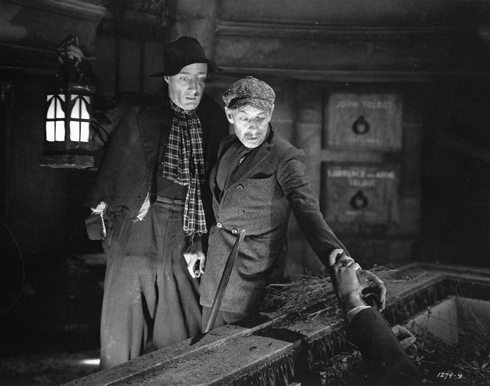
The two grave robbers, above, discover, that "Lawrence Talbot" was not killed.

The two grave robbers, above, discover, that "Lawrence Talbot" was not killed.
Curt Siodmak didn't write his joke to Waggner, but instead created a very exciting screenplay. That under Irish director Roy William Neil is extremely effective. Neil had been directing films in the U,K. since 1917. Among his works were 1935's "The Black Room" starring Boris Karloff, the excellent 1937 "Dr. Syn" starring George Arliss. Later in 1942 it was "Sherlock Holmes and the Deadly Weapon" starring Basil Rathbone and Nigel Bruce. In fact Neil would direct the next 11 pictures in Universal Studio's modern "Sherlock Holmes" series starring the duo.
Siomak's screenplay starts with "Lawrence Talbot" attempting to find a cure for the werewolf curse. Being found by the police the following morning after killing the grave robbers in the snow. He is taken the hospital of "Dr. Mannering" portrayed by Patrick Knowles. Knowles started acting in 1932 and was either the male lead, or second male lead in the majority of his motion pictures into 1973.
"Dr. Mannering" of course doesn't believe the story "Larry" is telling and thinks the injury to his head may be the cause of "Talbot's" delusions. The head injury is were his father struck him with the cane. "Larry's" father is nowhere to be seen in this film. It is even suggested he may be dead from a heart attack after killing his son.

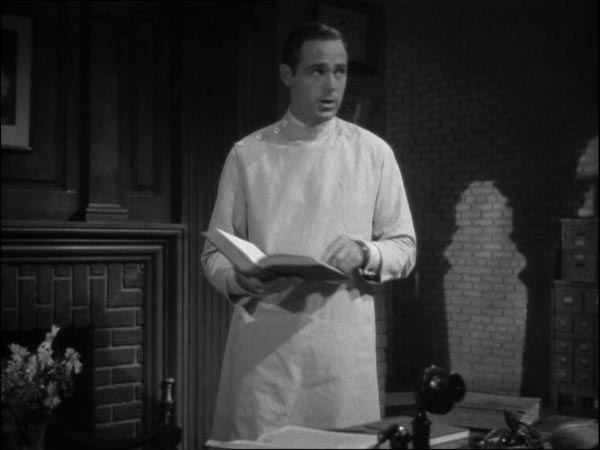
"Dr. Mannering" allows "Inspector Owen" to speak to "Larry". "Owen" is played by Dennis Hoey. "Hoey" is best remembered for portraying "Inspector Lestrade" in six of the Rathbone/Bruce "Sherlock Holmes" films starting with "Sherlock Holmes and the Secret Weapon". Hoey is on the right of the following still beside Patrick Knowles.

"Larry" becomes violent and "Dr. Mannereing" has him restrained by leather straps. "Mannering" than accompanies "Detective Owen" on a trip to "Talbot's" home. Meanwhile, the Full Moon comes out and "The Wolfman" bites through his restraints and escapes,
Leaving England "Lawrence Talbot" seeks out the gypsy women "Maleva". Once again portrayed by Maria Ouspenskaya for help ridding him of the curse.

The two go to the village of Vasaria seeking "Ludwig Frankenstein's" castle and the hope of finding his father's notebook about life and death. Hearing why they are in Vasaria the people tell them to leave. It's the night of the FULL MOON and "Talbot" changes into the werewolf and kills a local girl. The villagers chase him and in ends up at the ruins of "Ludwig's" castle. Moving through the ruins the floor gives way, he falls through it, and then "Talbot" discovers frozen in ice the "Frankenstein" monster.

"Larry Talbot" frees the monster in the hope it will lead him to the notebook, but this fails.

Note the way Bela Lugosi was forced by George Waggner to walk as the monster in the above photo.
"Lawrence Talbot" next decides that perhaps the daughter of "Ludwig", the "Baroness Elsa Frankenstein", can help him. In "The Ghost of Frankenstein" the role was portrayed by Evelyn Ankers, but in this film she is portrayed by Ilona Massey. Massey was a Hungarian actress billed as the "New Dietrich". The year before this picture Universal Studios had cast her opposite Jon Hall in "The Invisible Agent" from a Curt Siodmak screenplay using the H,G, Wells story as its basis.
While at a Festival "Dr, Mannering" arrives and joins "Elsa" and "Larry". "Mannering" is taken to see the "Frankenstein" monster and the notebook is located.

"Dr. Mannering" after reading the notebook says he knows how to free "Lawrence Talbot" of the curse. It is decided to let the monster think he is going to heal him while actually healing "Larry".


As in movies past and future. "Dr. Mannering" becomes obsessed with seeing the monster at its full power and this leads to the climatic fight between "The Wolfman" and "Henry Frankenstein's" creation. While this is going on the dam that is providing the power to the castle is being prepared with dynamite to be blown up by one of the villagers.

In the above still it is obvious that Bela Lugosi isn't carrying Ilona Massey. It is actually stuntman Gil Perkins.

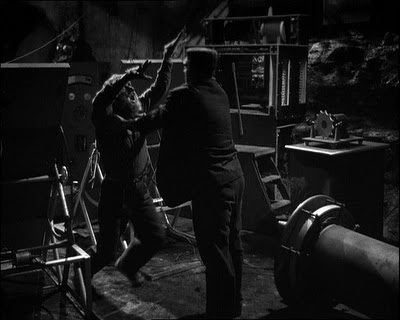
The dam is blown, "Dr. Mannering" and "Elsa" manage to escape and the wolfman with the "Frankenstein" monster are swept away by the raging water.


What's better than the "Frankenstein" monster and a werewolf? How about a vampire and a werewolf?
THE RETURN OF THE VAMPIRE ( NOVEMBER 11, 1943)

Columbia Pictures got into the act with a very original vampire and werewolf tale from a screenplay by Randall Faye and Griffin Jay.. Randall specialized in detective stories. While Jay would write the screenplays for all Lon Chaney, Jr.'s "Mummy" movies among other minor Horror films. One will be mentioned in this article.
The picture was directed by Lew Landers. Among Landers "B" picture work was the Classic Horror film 1935's "The Raven", forgotten westerns like 1949's "Stagecoach Kid" and 1950's television from"Terry and the Pirates" and "Science Fiction Theatre" to "Highway Patrol" and "Bat Masterson".
This story starts with "Sir Frederick Fleet", MIles Mander, reading the notes of "Professor Walter Saunders". It is 1919 England and the notes concern a series of vampire murders. Among Mander's film roles were "King Louis XIII" in the 1935 "The Three Musketeers" and "Cardinal Richelieu" in the 1936 version. He was "Aramis" in Dumas' sequel "The Man in the Iron Mask" in 1936, "King Henry VI" in 1939's "Tower of London" and "Pleyel" in the 1943 "The Phantom of the Opera".
The aforementioned "Professor Walter Saunders" was portrayed by Gilbert Emery. Emery was in 1932's "A Farewell to Arms" starring Helen Hayes and Gary Cooper. He played "Sir Basil Humphrey of Scotland Yard" in 1936's "Dracula's Daughter". Gilbert Emery was known for his British roles, but was born in Naples, New York.
"Doctor Lady Jane Ainsley" was portrayed by Frieda Inescort. She started on the British stage in 1922 and turned to motion pictures in 1935. Her film career was varied with the Greer Garson vehicle 1940's "Pride and Prejudice" and the same years "The Letter" starring Bette Davis She was in Bob Hope's 1954 "Casanova's Big Night" and 1956's cult Science Fiction film "The She Creature". Inspired by the story of Bridey Murphy who claimed to have been reincarnated and was all the talk, in the early 1950's.
"Professor Saunders" is talking to "Lady Jane" about a patient she has in her clinic with two tiny marks on the jugular vein. Enter two children. One is "Lady Janes" son "John" and the other is "Professor Saunders" granddaughter "Nikki". It is night and the two children are sent to bed..
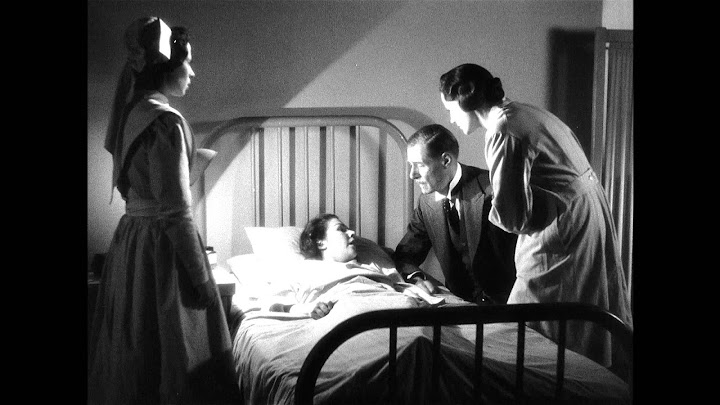
A cloaked figure is seen watching and realizing he can not get to the "Lady Jane's" patient/ He goes to ":Nikki's" room and attacks the little girl instead. After the patient dies "Professor Saunders" spends the night reading about vampires.
The vampire in question is "Armand Testa", Bela Lugosi. "Testa" has an assistant "Andreas Obry", Who is a slave to him by being under a spell turning the man into a werewolf. He is played by Matt Willis a solid "B" character actor in Westerns, War Pictures and other vehicles. Willis is completely unknown as many actors were and would remain as such except for this role. This werewolf is not the same as a "Lawrence Talbot", but remains in that state even in daylight to be "Testa's" protector.
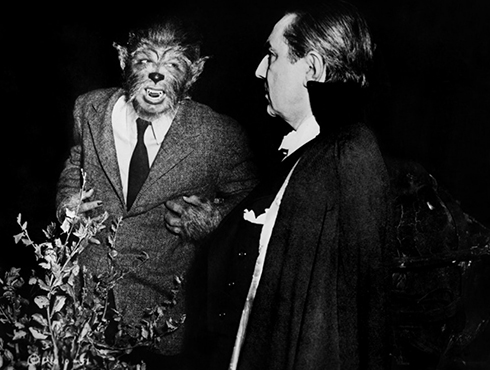
Having discovered the attack on "Nikki". "Professor Saunders" and "Lady Jane" go after "Testa". They find him, stake him out, and this frees "Adreas" of being a werewolf. He becomes a faithful servant and friend of "Lady Jane".
Move forward 24 years to England under the blitz. "Professor Saunders" is now dead and "Sir Frederick Fleet" is reading his written account.
During the war cemeteries did get bombed and people were assigned to put the bodies back into their coffins and rebury them. The audience see two such men going through a bombed out cemetery and come upon a skeleton with a stake in it. They believe that was caused by a bomb and remove it. "Armand Testa" returns to life and suddenly "Andreas" turns back into the werewolf.
We now have both children grown and "Nikki" is doing her part for the war.
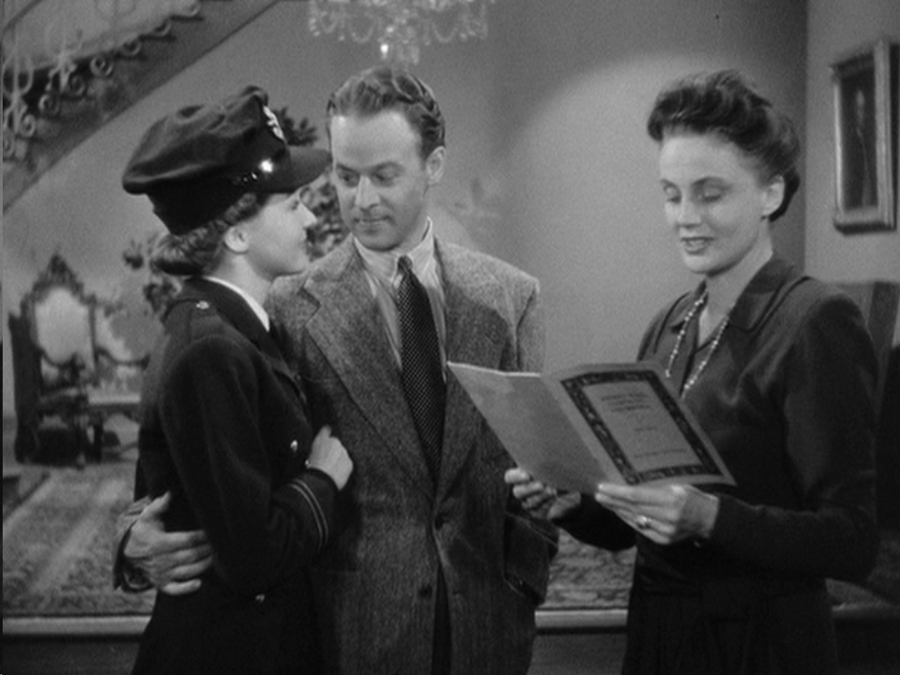
In the above photo is "Lady Jane" on the far right and on the left Nina Foch as "Nikki" and the man she is engaged to marry "John Ainsley" played by Roland Varno. Nine Foch, for fans of Cecile B. DeMilles 1956 "The Ten Commandments", played the Pharaoh's daughter who raises Charlton Heston's "Moses". The role led to an Academy Award nomination for Best Supporting Actress. .Foch also appeared in Stanley Kubrick's "Spartacus". Robert Wise''s "Executive Suite" and many Film Noirs.
Roland Varno wasn't a major lead, but appeared in many films such as 1939's "Gunga Din" and the only color movie Bela Lugosi had a starring role 1947's "Scared to Death". Varno also appeared on the early television Science Fiction series "Space Patrol".
On the evening of their engagement party "Sir Frederick" arrives with "Professor Saunders'" manuscript, but "Lady Jane" doesn't want to show it to "Nikki". Who has recovered years previously from a "Childhood Trauma", However, the manuscript is placed by "Andreas", prior to turning back into a werewolf, on her night stand and "Nikki" proceeds to read it.
The remainder of the picture is confirming that "Dr. Hugo Bruckner" is really "Armand Testa". Who wants to make "Nikki" his bride and the search to find and destroy him.



"Nikki" is saved, but "Andreas" is shot in his werewolf form and transforms back into his human. He then dies from the bullet wound the werewolf received. Of course "Dracula", oops, "Testa" is finally destroyed in sunlight for good.

David Skal in his 2004 work: "Hollywood Gothic: The Tangled Web of Dracula" writes;
CRY OF THE WEREWOLF AKA: DAUGHTER OF THE WEREWOLF (AUGUST 17, 1944)

Both Columbia Pictures and Nina Foch were back in another movie with a werewolf. Grffin Jay is also back and his screenplay may have taken a little from Val Lewton's "Cat People", the 1913 film "The Werewolf" and created a very good story.
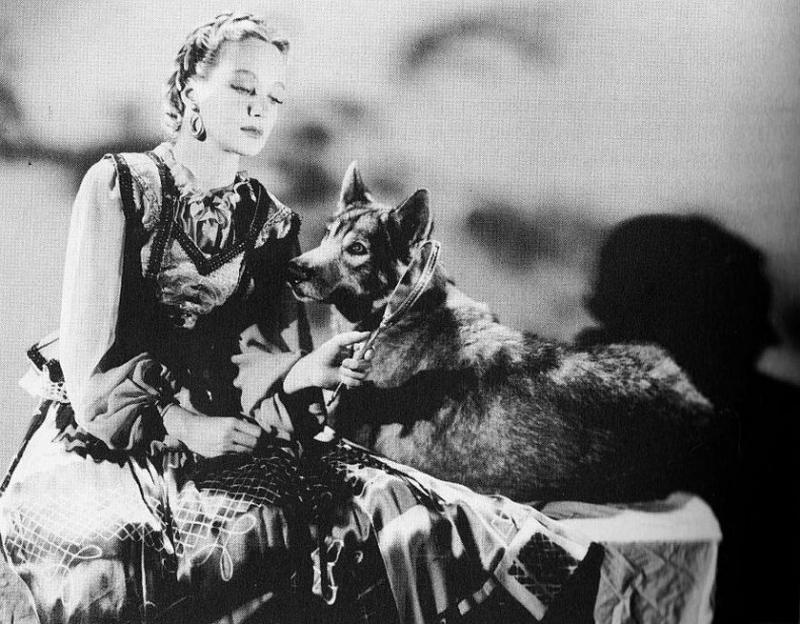
Above Nina Foch as "Celeste La Tour" the werewolf of the title in a publicity still.
This film was the first directing job for Henry Levin and he does a very good job working with cinematographer L. William O'Connell in setting up mood and suspense. Levin would go on to direct such films as 1946's "The Bandit of Sherwood Forest", 1949's and "Jolson Sings Again". Along with three movies starring singer Pat Boone, 1957's "Bernadine", 1957's "April Love" with Shirley Jones and 1959's "Journey to the Center of the Earth" with James Mason. While O'Connell had worked on Howard Hawks original 1932 "Scarface", "Return of the Vampire" and several of the original filmed "Nancy Drew Mysteries".
"Dr. Charles Morris" is researching "Marie La Tour" a gypsy queen. He runs a museum about the occult in her last residence and the story told to visitors by the guide "Peter Athius" is about a werewolf.
"Marie La Tour's" husband discovered the truth about her and when he confronted his wife in the house. He was murdered by his "Marie" the gypsy queen and werewolf. In this film there are no transformations like in either of Universal Studios films, or the preceding Columbia Pictures feature. The transformation from human to wolf is the same as in the 1913 Navajo legend and the person becomes an actual wolf.

According to research after the murder of her husband "Marie La Tour" seems to have just disappeared.
Now "Dr. Morris" has discovered something about the gypsy queen he will not reveal to his assistant "Elsa Chavet", played by Osa Massen, until she returns from the airport with his son, "Bob", played by Stephen Crane. Osa Massen was a Danish actress that came to the United States and become a solid "B" leading lady in films such as 1935's "Kidnapped", 1943's "Jack London" and the classic 1950's Science Fiction film "Rocketship X-M".
Stephen Crane was a "B" contract player for Columbia Pictures until he opened "The Luau" Restaurant. It became a major 1950's Hollywood film industry spot. Crane was also one of Lana Turner's ex-husbands.

"Bob's" father is murdered by what appears to be wild animal in a secret room, before the two return from the airport. The guide "Peter Arthius" is found coming out of a hidden room in a state of shock. Additionally all the notes of "Dr. Morris" have been thrown into a fire place with a newly lite fire burning them. What the police, "Elsa" and "Bob" do not know, but the audience does. Is that "Dr. Morris" was killed by the daughter of a werewolf, "Celeste La Tour" the "Princess" of her gypsy tribe. In the above photo "Bob" and "Elsa" are attempting to reconstruct with infrared photography the burnt notes.
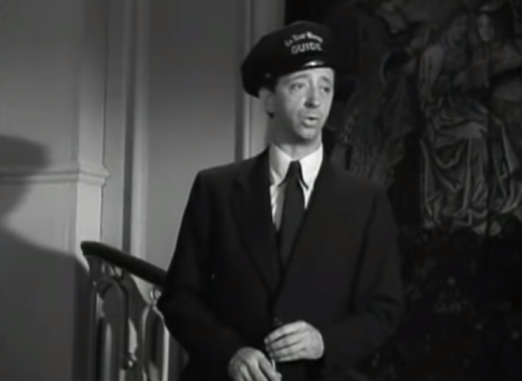
John Abbott, above, as ""Peter Athius", in this picture. Did another excellent low keyed role as "The Vampire's Ghost" in the group of 1940's films I mentioned under "The Undying Monster". Among the variety of Abbott's roles are "Prospero" in a 1939 film of "The Tempest", "Will Scarlet" in "The Bandit of Sherwood Forest"and in 1945 was in the "Sherlock Holmes" mystery "Pursuit to Algiers" starring Basil Rathbone and Nigel Bruce.
The police are led by "Lt. Barry Lane" portrayed by the very recognizable Barton MacLane in any of his 182 roles. Below on the left.

Among MacLane's other features were 1941's "The Maltese Falcon". the same year's "High Sierra" and 1948's "The Treasure of the Sierra Madre". All three starring Humphrey Bogart. Then there's James Cagney's 1935 "The Frisco Kid", Boris Karloff's 1936 "The Walking Dead", director Fritz Lang's 1941 "Western Union" and the Spencer Tracy, Lana Turner and Ingrid Bergman 1941 "Dr, Jekyll and Mr. Hyde".
The police find a woman's fingerprints on the inside of the secret room "Bob's" father was murdered in. "Lt. Lane" believe the prints will turn out to be "Elsa's". He is of course wrong. "Bob" finally confesses his love for "Elsa" and at a coroner's inquest "Celeste La Tour" is being questioned and "Bob" asked if he may question the gypsy girl. It becomes obvious to her that "Bob" may need to be stopped.
The janitor of the museum is one of "Celeste's" tribe and is instructed to destroy the reconstructed notes. He does, but leaves a clear hand print behind and becomes the number one suspect for the murder of "Dr. Morris". "Celeste" turns herself into a wolf and kills him for being so careless and possibly now leading the police to their camp.
"Bob" learns the the gypsies only bury their dead once a year at a sacred burial site. He goes to the mortuary that handles this and learns that the records and bodies are kept in a special freezer in the basement. The gypsies arrive with the body of the janitor and "Bob" sees them. He sneaks down to the basement while they're preoccupied with the mortuary owner.

The Owner reveals that "Bob" is there and "Celeste" says she wants to meet him. They find him gone, but "Celeste" figures were he is headed. "Bob" has finally located the records he wants, but hears footsteps. The audience sees "Celeste's" feet and as she passes behind something her feet seem to be those now of a wolf.
"Bob" is able to escape and meets "Celeste" back upstairs. She asks him if he would drive her back to her encampment. He agrees to learn more about her.
"Celeste" learns of "Bob's" engagement to "Elsa" and figures out a plan to stop them both. "Elsa", who came from Transylvania finds a doll planted on "Bob" by "Celeste" and refuses to talk to him anymore. It means that he is now engaged to "Celeste".
Things come to a head as "Celeste" hides in the museum waiting for "Elsa" to return. She then hypnotizes her and informs the girl that when she awakes. She will be her sister and a daughter of a werewolf. also.

"Bob" returns to the museum to find "Elsa" repeating over and over again that she killed "Dr. Morris". The police arrive and "Lt. Lane' considers this a confession of guilt even though "Elsa" appears to be in some type of trance. The lights suddenly go out and the police leave "Bob" with "Elsa" in the museum office as they investigate. The police now enter the secret passage and discover the burial tomb of "Marie La Tour", but two officers are attacked by a wolf. The wolf moves to attack again and the officers open fire wounding it.
Meanwhile, "Elsa" had been given a sedative, but it appears, unnoticed by "Bob", to not be working. While she pretends to be asleep he notices a pistol in the desk's center drawer. Entering the office is "Celeste La Tour" with her left arm injured corresponding to the left front paw of the wolf. Also, when this injury originally occurred. "Elsa"had reacted and her left arm is also bleeding.

"Bob" goes for the gun, but "Elsa" is holding it on him.

"Celeste" tells "Elsa" to kill "Bob", but he's trying to get the girl to snap out of her trance. "Celeste" takes matters in her own hands and turns into a wolf with the left front paw still bleeding.

The werewolf attacks "Bob" as the police break into the office. They shoot and kill "Celeste La Tour" freeing "Elsa's" mind.
Curt Siodmak was asked to create a story to revive Universal's Horror dominance. As it was waning compared even to Columbia Pictures. His solution was truly a winner,
HOUSE OF FRANKENSTEIN (DECEMBER 15, 1944)

The actual screenplay was by Edward T. Lowe, Jr.. He was a perfect choice having done the story/scenario for the 1923 "Hunchback of Notre Dame" that starred Lon Chaney, 1933's "The Vampire Bat" starring Fay Wray and Lionel Atwill, along with screenplays for, once again, "Sherlock Holmes and the Secret Weapon" and many detective films in both the "Charlie Chan" and "Bulldog Drummond" series.
The movie was directed by Erle C. Kenton. Kenton had already worked in Horror films with 1932's "Island of Lost Souls" and ten years later with "The Ghost of Frankenstein". The film was produced by Paul Malvern who was more familiar with "B" westerns starring John Wayne and Arabian Nights fantasies starring Maria Montez.
So lets look at the faces on the above poster. Although we see "Frankenstein's MONSTER" the name of the actor who portrayed him isn't on the poster. This was the first of three appearances by "B" Western actor and stuntman Glenn Strange. Whose face would become the model for many a Halloween mask as the years went by and the one most people remember.
Strange's career contained over 315 on screen roles between motion pictures and television programs. Some of those "B" Western credits include Bob Steele's 1932 "Riders of the Range" in which Strange was a singing cowboy and 1935's "Cyclone of the Saddle". In which not only his singing talent, but his fiddling were on view. He portrayed a giant in the 1944 "The Monster Maker" and was the "Chief Galley Overseer" in 1947's "Sinbad the Sailor" starring Douglas Fairbanks, Jr. and Maureen O'Hara. On television you would find Glenn Strange on "The Adventures of Kit Carson", "Space Patrol", he was "Butch Cavendish" in 1952's "The Legend of the Lone Ranger" starring Clayton Moore and Jay Silverheels and of course on many a "Gunsmoke" episode.
The first picture on the movie's poster, with second billing, was Lon Chaney, Jr. back as ":Lawrence Talbot".
The third picture said the character was "DRACULA", but in the picture he goes by the name of "Baron Latos".

Shakespearean trained John Carradine had the smarts not to play Bela Lugosi and to know just when to ham things up with a straight face, because this film was meant to be fun. By this time Carradine had been seen without on screen credit in two Universal Horror entries 1932's "The Invisible Man" and 1934's "The Black Cat". He actually had three different roles without screen credit in Cecil B. DeMille's lavish 1934 "Cleopatra" starring Claudette Colbert and was in the 1935 "Les Miserables" starring Frederick March and Charles Laughton. His credited dramatic roles now included 1937's "Captains Courageous" starring Spencer Tracy and John Ford's version of John Steinbeck's "The Grapes of Wrath" starring Henry Fonda. In short John Carradine was an all around actor.
The part of "The HUNCHBACK" named "Daniel" was portrayed by J. Carrol Naish and was patterned after Dwight Frye's "Fritz" from the 1931 "Frankenstein". Frye had died at the age of 44 on November 7, 1943.

J. Carrol Naish was of Irish decent, but played everything one could imagine as a character actor and excellently, if I may say so. Among his varied roles were a pirate in 1935's "Captain Blood", "Puran Singh" in 1936's "The Charge of the Light Brigade", a Russian named "Rasinoff" in 1939's "Beau Geste" and the title role in 1954's "Sitting Bull", but to fans of "Batman". J. Carrol Naish has the distinction of being the first on screen villain. A Japanese scientist, "Dr. Daka", bent on turning American scientists into electronic zombies in the 15 Chapter 1943 serial from Columbia Pictures entitled "Batman".
The final face on the poster is "The MAD DOCTOR" portrayed by Boris Karloff. Karloff's film appearances seemed to be in some really bad pictures around this time. They included Monogram Pictures 1940 "The Ape", RKO's comedy for Kay Kyser and his band 1940's "You Find Out". In that picture were also Peter Lorre and Bela Lugosi. Both also looking for any type of work that year. Then Boris Karloff appeared in 1942's "The Boggie Man Will Get You". A comedy/Horror film co-starring Lorre from Columbia Pictures. However, just after "House of Frankenstein" wrapped. Boris Karloff signed a picture deal with Val Lewton at RKO and appeared in three of his best roles. These were the 1945 adaptation of Robert Louis Stevenson's "The Body Snatcher" as I previously mentioned directed by Robert Wise, the same years "Isle of the Dead" directed by Mark Robson and 1946's "Bedlum" also directed by Robson.

The plot was crazy, pure excess and down right fun.
Karloff's "Dr. Gustav Niemann" escapes from prison with his hunchback assistant "Daniel". The two murder "Professor Lampini" guest ghoul George Zucco. Zurcco the previous year had been in "Sherlock Holmes in Washington" and "The Mad Ghoul". In 1944 prior to this release he was seen in Monogram's "Voodoo Man" with Bela Lugosi and John Carradine. Along with Universal's own "The Mummy's Ghost".
"Niemann" and "Daniel" take over "Lampini's" traveling horror exhibit. "Niemann" goes after the first of the people he seeks revenge upon a Burgomaster. By pulling the stake out of the skeleton of "Baron Latos" causing the vampire to come back to life.

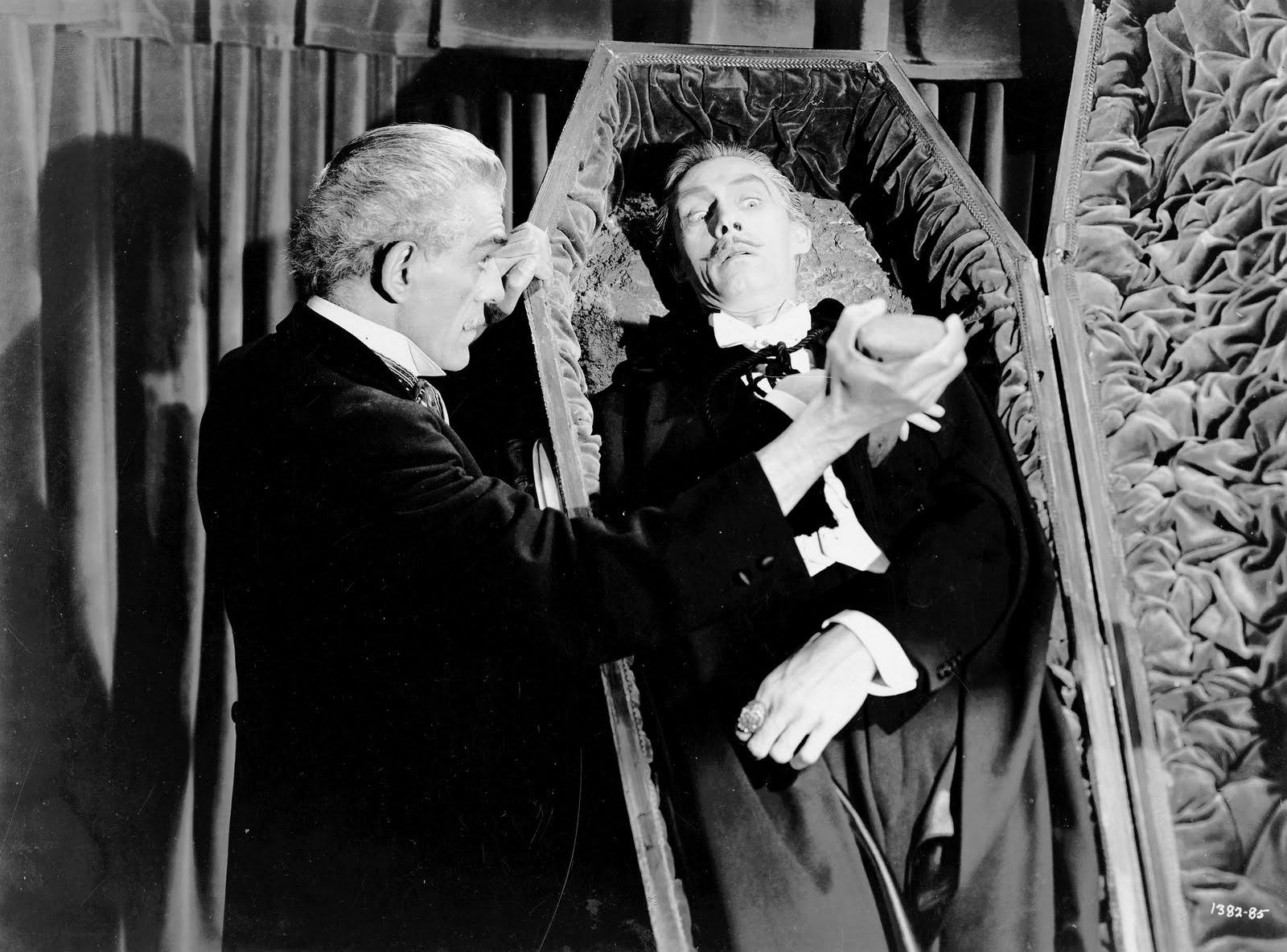 .
.
Getting the vampire to do his bidding as "Dr/Niemann" controls the coffin. Here's where things just role from one short subject to another in this 71 minute movie. The vampire kills the Burgomaster. but there's a chase by the local authorities. So Karloff just tosses Caradine's coffin off the exhibits traveling wagon and it breaks open exposing the vampire to the sunlight.
Moving on Karloff heads for the ruins of "Ludwig Frankenstein's" castle and finds both the monster and "Lawrence Talbot".
Both in a variation from "Frankenstein Meets the Wolfman" are frozen in the waters from the dam. "Dr. Niemann" and "Daniel" thaw them out and he promises "Talbot" he will help him be cured of being a werewolf. Where have we heard this before?
Actually "Niemann" is only interested in bringing the monster back to life to use for his revenge. I am sure producer Paul Malvern and director Erle C. Kenton, like the Universal executives, were thinking of the audience draw of having Boris Karloff now play the mad scientist bringing the monster he had played three times back to life.
An aside:
The best use of Karloff in such a role was in a low budget, but very well written and acted 1958 horror film "Frankenstein 1970". In which at the end you discover he is both the creator and the creation.
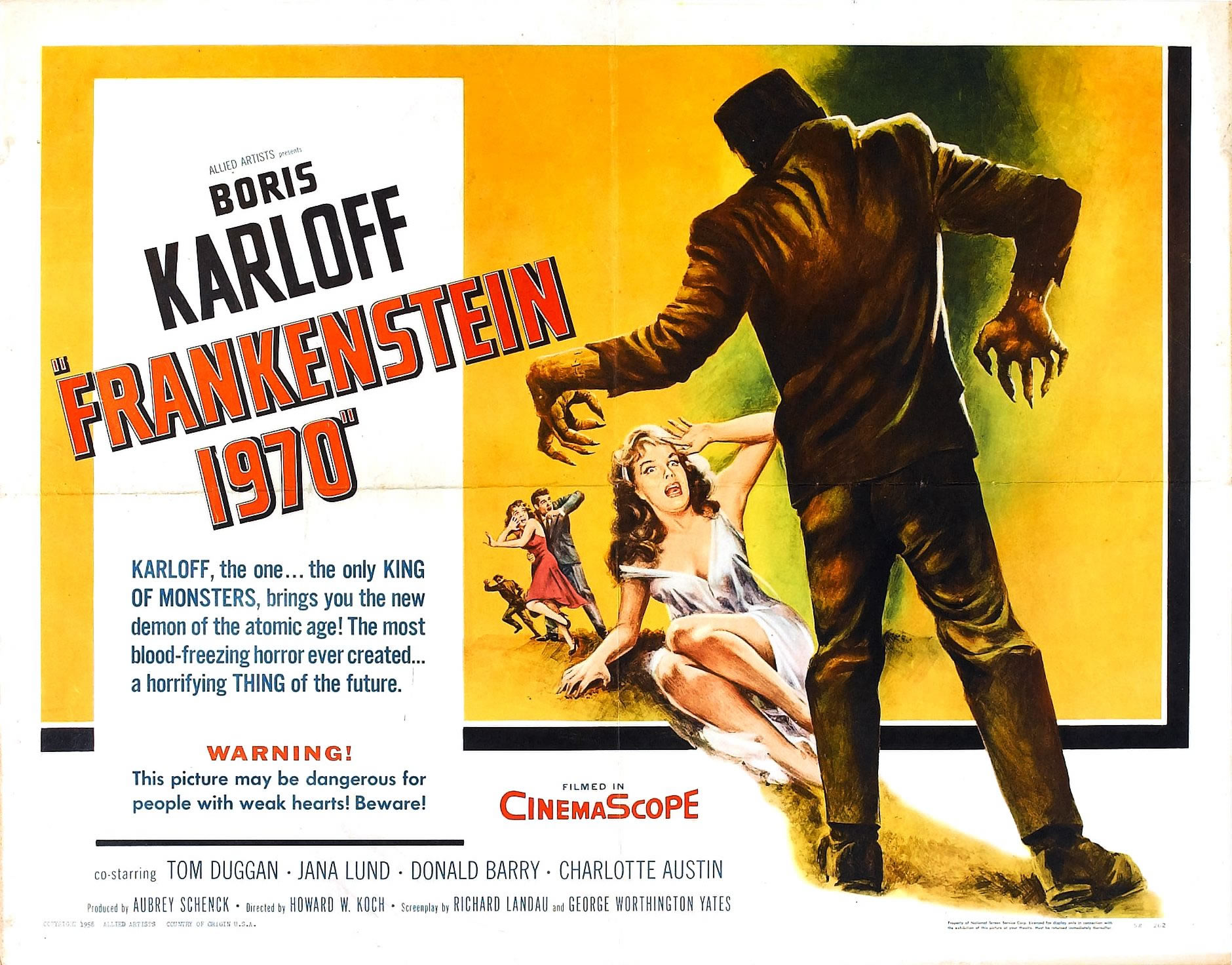
So "Dr. Nieman" with "Daniel's" assistance begins to revive the monster and supposedly help "Larry Talbot".
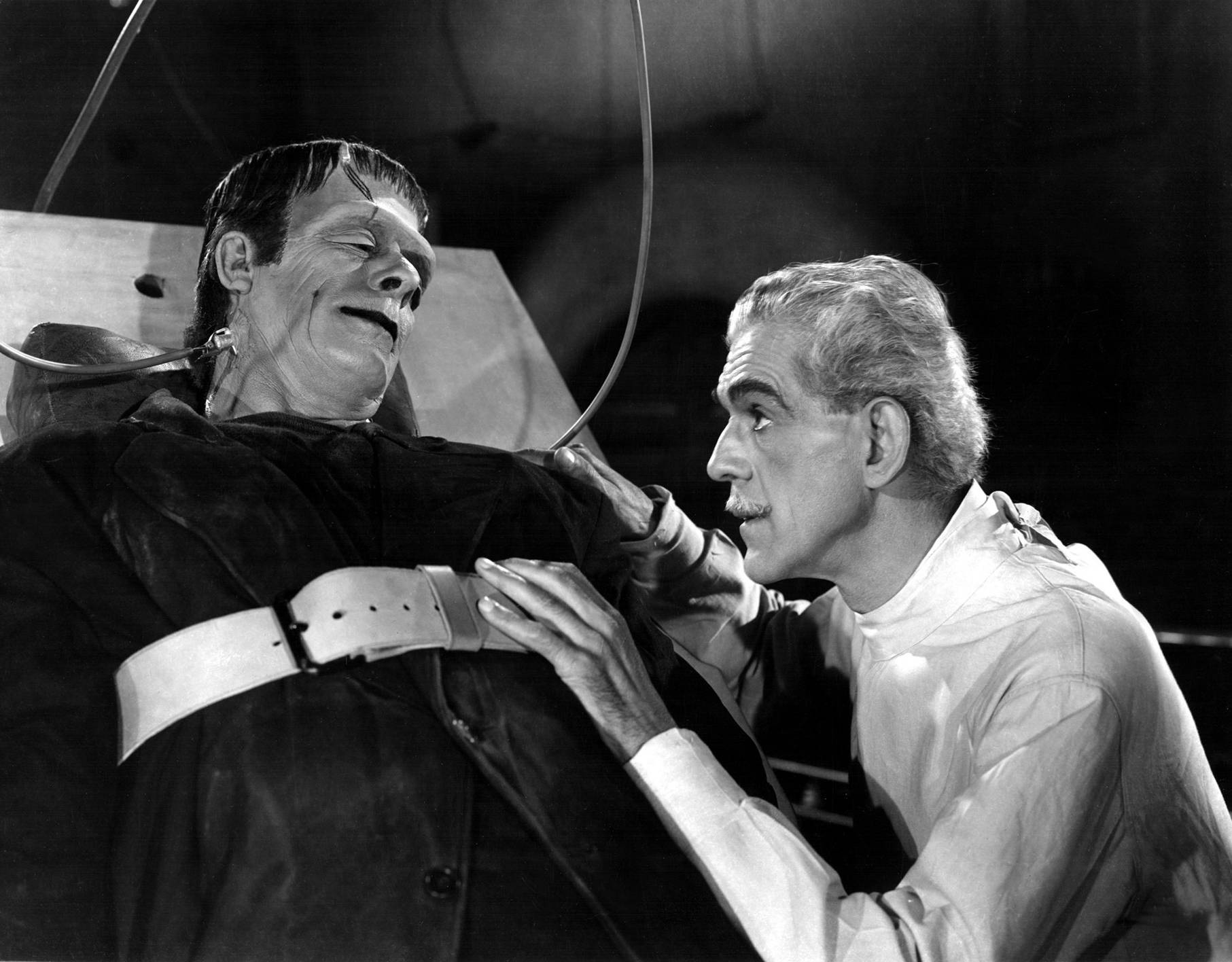
Meanwhile, as with "Quasimodo" in Victor Hugo's "The Hunchback of Notre Dame". "Daniel" rescues a gypsy girl, "Ilonka:, played by Elena Verdugo, and falls in love with her. Even knowing "Larry" is a werewolf she still loves him over "Daniel". Again going to "Esmeralda" in Hugo's novel.
Elena Verdugo was a descendant of the Verdugo family. One of the main Spanish founders of Los Angeles County. She is mostly known for playing office assistant "Consuelo Lopez" on the television series "Marcus Welby, M.D." starring Robert Young from 1969 into 1976.
The second name on the above poster catches the potential audience LON CHANEY. What that audience didn't know was this new movie was actually two old Mexican productions re-edited with some additional footage into a story about, ready (?), a MUMMIFIED WEREWOLF brought back to life.
The film was a product of film producer, writer, editor, director, cinematographer and actor Jerry Warren. His work includes such titles as 1957's "The Incredible Petrified World", 1961`'s "Teenage Zombies" and my favorite title 1966's "The Wild World of Batwomen".
The two Mexican movies Warren used were 1957's "La Monia Azteca (The Aztec Mummy)" and the entirely unrelated 1960 "La Casa del Terror (House of Terror)". Most of the additional footage was from Jerry Warren's other 1964 horror film "Attack of the Mayan Mummy". Which also used footage from the original Mexican picture "La Momia Azteca". Are you still with me.
I'll let Rich Wannen on the webite IMDb describe this convoluted plot:
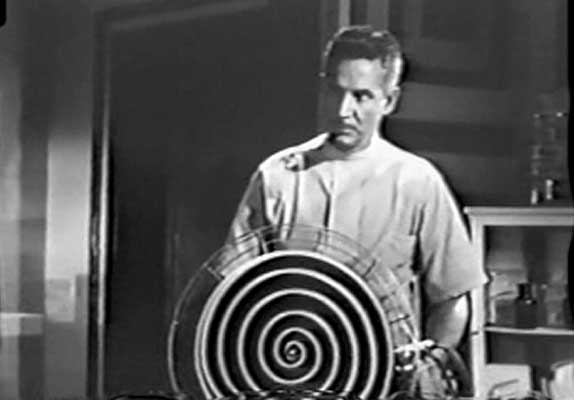
How about a little name changing from Spanish to English? Designed to fool Warren's viewers in the dubbed scenes from the two original Mexican features. Ramon Gay now becomes Raymond Gaylord portraying "Dr Edmund Redding". Alfredo W. Barron is simply changed to Donald Barron portraying "Redding's Henchman". Yolanda Varela becomes Landa Varle as "The Girl carried off by the werewolf". While Rosita Arenas becomes the character "Ann Taylor". One has to wonder did Jerry Warren pay any of these actors including Lon Chaney, Jr. royalties, at least, for using their previous motion pictures and did any of them discover this turkey?
As to that new footage. One of the actors was a George Mitchell who had 6 feature films to his credit and they were all Warren's productions. He was also Warren's make-up department. Fred Hoffman had 5 Jerry Warren pictures for his film acting career and Chuck Niles had the most at 11.
In 1965 out of 31 Horror motion pictures released. Only one and one-fifth were about werewolves. Two were still about vampires, but one was the classic prototype for the look of Ridley Scott's "Alien", "Planet of the Vampires" by Mario Bava.
DR. TERROR'S HOUSE OF HORRORS (FEBRUARY 25, 1965)

Five strangers meet in a train car and are joined by a sixth "Dr. Schreck" and a deck of Tarot cards. As the above poster indicates "Dr. Schreck", at his low keyed best, was portrayed by Peter Cushing. Peter would follow this film with the first color version of H. Rider Haggard's novel "SHE". He portrayed "Holly" a role Nigel Bruce did in the 1936. That version was by Merian C. Cooper the man who brought the world "King Kong". "SHE" would be followed by the first of his two controversial portrayals of "The Doctor" in "Dr. Who and the Daleks".
The first of the five episodes is titled "Werewolf" and finds architect "Jim Dawson" portrayed by Neil McCallum returning to his old family home on the Scottish moors. Canadian-British actor McCallum is known more for not being seen, but providing voices in Gerry Anderson's "Thunderbirds Are Go!" and "Captain Scarlet and the Mysterons".

"Jim Dawson" has arrived to renovate the ancestral home for its new owner "Mrs. Biddulph" portrayed by Ursula Howells. A British character actress known for her elegant roles. While looking over the house in the lower levels. "Dawson" discovers the tomb of the house's original owner "Count Cosmo Valdemar". "Mrs. Biddulph" believes the local legend that "Count Valdemar" will roam the halls as a werewolf and take revenge on the current owner. Believing "Mrs. Biddulph", "Jim Dawson", makes silver bullets to protect her. However, what he doesn't know are three things.
The first is that the legend says "Count Cosmo Valdemar" will return to life after he takes revenge on the last member of the "Dawson" family. Who killed the evil Count and that was how the house actually went to "Jim's" ancestors. The other unknown is that "Jim Dawson" is the last member of his family and "Mrs. Biddulph" is actually the reincarnation of the Count's wife.
The other stories have as cast members Christopher Lee, Bernard Lee the original "M" in the "James Bond" movies, Jeremy Kemp, Michael Gough and Donald Sutherland.

LA LOBA AKA: THE SHE-WOLF (JULY 1, 1965)

This Mexican made feature film has a simple, but interesting plot. Actress Kitty de Hoyos portrays "Clarisa Fernandez" a young women cursed as a werewolf. She has been seeing a "Dr. Alejandro Bernstein" portrayed by Joaquin Cordero for help in breaking her curse.
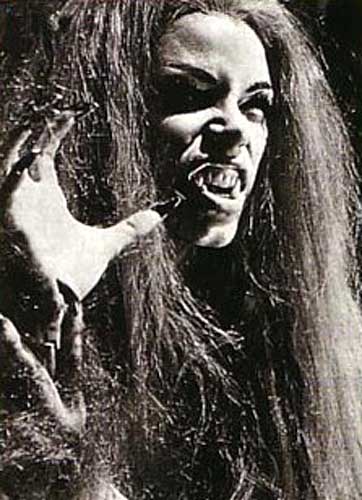
The twist is that "Dr. Bernstein" is also a werewolf. The two fall in love and go on a killing spree. Her father "Professor Fernandez" portrayed by Jose Elias Moreno has been studying metamorphosis to attempt to also cure and understand what has happened to his daughter. However, in the end both werewolves lives are ended by a trained werewolf killing dog.
MUNSTER GO HOME (JUNE 15, 1966)

As this article is about every werewolf movie. I have to include the feature film based upon the popular television series "The Munsters". Seeing that "Herman", Fred Gwynne, and "Lily's", Yvonne DeCarlo, little boy "Eddie Munster", Butch Patrick, is supposed to be a werewolf. There was one change to the cast for the feature film. Instead of Pat Priest as "Marilyn", she already had replaced Beverly Own starting in episode 14 of the television show, we have Debbie Watson. Watson had played "Tammy" on the television series. She would make one "Tammy" movie 1967's "Tammy and the Millionaire". The character was first seen in 1958's "Tammy and the Bachelor" starring Debbie Reynolds and then a series of films in the early 1960's starring Sandra Dee.
Anyhow, "Herman", "Lily", "Grandpa", Al Lewis, "Eddie" and "Marilyn" inherit an old English Mansion. There they run afoul of "Cousin Freddie Munster" portrayed by Terry-Thomas and "Lady Effigie Munster", Hermione Gingold, in some funny bits including a drag race using the "DRAG-U-LA".



For those of my readers who remember both "The Munsters" and "The Addams Family". My article on both television programs can be read at:
http://www.bewaretheblog.com/2017/09/the-addams-family-and-munsters.html
How about a another variation of the werewolf motif?
THE BLOOD BEAST TERROR AKA: THE VAMPIRE-BEAST CRAVES BLOOD (JANUARY 1968)
It's 19th Century England and strange murders are occurring. "Inspector Quennell" portrayed by Peter Cushing starts to investigate. This will lead to "Dr. Carl Mallinger", portrayed by Robert Flemyng, an entomologist with a beautiful daughter. Flemyng started acting in 1937 and appeared in a variety of American and British television programs. In films he was in the 1957 musical "Funny Face" starring Audrey Hepburn and Fred Astaire, the 1962 Italian Horror film "The Horrible Dr. Hitchcock" co-starring British actress Barbara Steele, 1966's "The Quiller Memorandum" starring George Segal and Alec Guinness and 1969's "The Body Stealers" starring George Sanders and Maurice Evans.
Portraying "Dr, Mallinger's" daughter "Clare" was Wanda Ventham. The actress is known mainly for her role of "Colonel Virginia Lake" in Gerry Anderson's classic British Science Fiction television show "UFO". In this film she portrays, are you ready (?), a "Were-Moth". At night "Clare" turns into a human moth created by her father and drains the fluids out of her victims. Her Father is searching for the right male to be turned into her mate to keep the species alive.
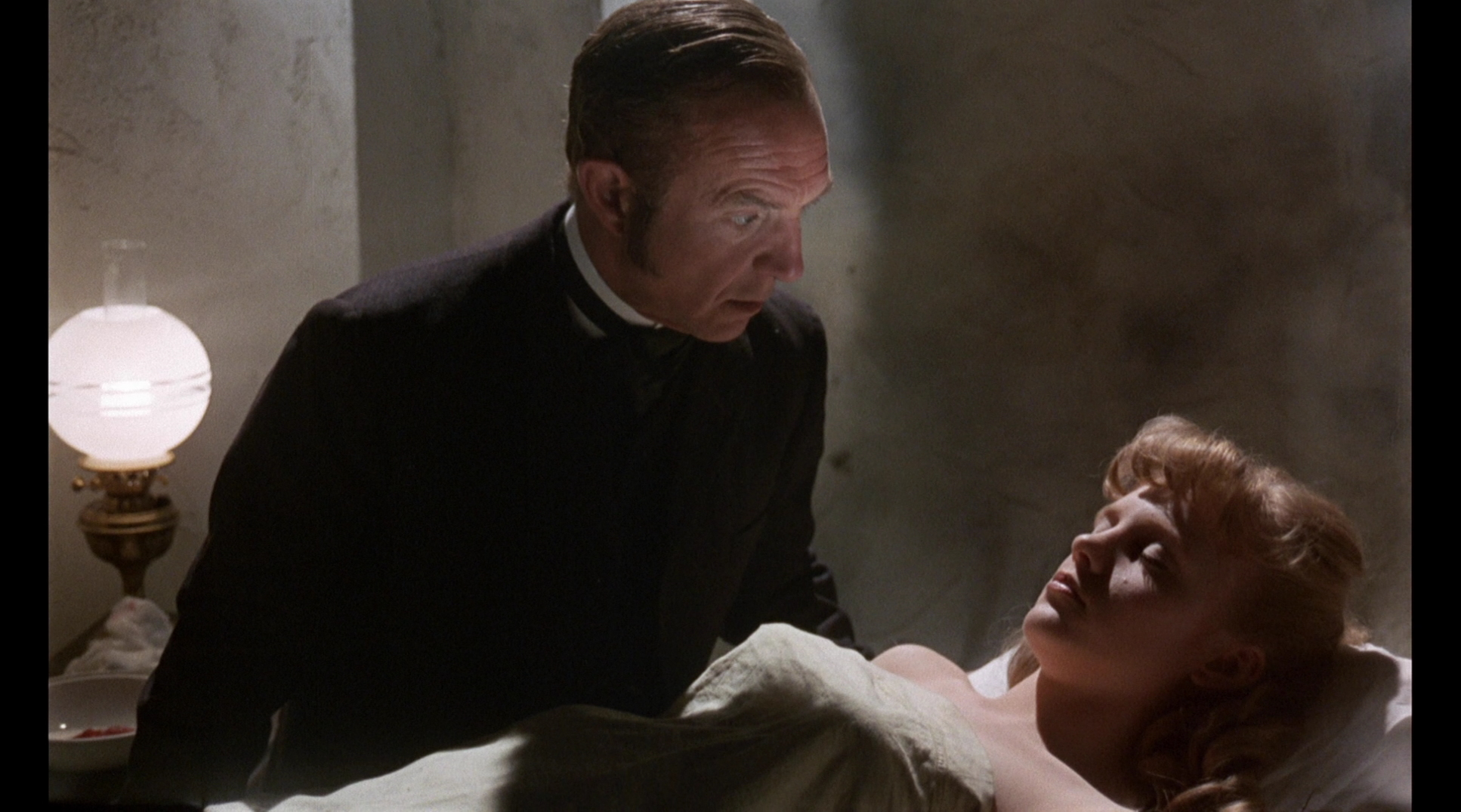
Unfortunately in this screenplay the actual werewolf only shows itself during the last few minutes of the movie.
"The Undying Monster" is part of an article on five forgotten Horror and Thriller gems of 1940's I wrote about at:
http://www.bewaretheblog.com/2016/11/the-undying-monster-seventh-victim.html
CAT PEOPLE (DECEMBER 6, 1942)

A classic variation of the werewolf tale was brought to the screen by producer Val Lewton and director Jacques Tourneur. "Cat People" was the first motion picture produced by Val Lewton who would bring his audience such horror classics as "I Walked With A Zombie", "Isle of the Dead" and "Bedlam". The last two titles starring Boris Karloff. Lewton would produce director Robert Wise's version of Robert Louis Stevenson's "The Body Snatcher" with Karloff and in a very small role Bela Lugosi.
Lewton was the King of the low budget, high scare ratio feature. You thought you saw something, but maybe it wasn't there. It was the mood and lighting of the scene that played tricks on the audience. This technique was center stage in "Cat People".
For those of my readers who love the work of Val Lewton. My look at his life and films may be read at:
http://www.bewaretheblog.com/2015/10/val-lewton-master-of-subtle-terror-and.html
Paris, France born director Jacques Tourneur was also a master of the low budget film. Making them look better than some major productions and getting excellent performances even out of extras. Over his 75 film career would be a variety of genres. Besides "Cat People" for Lewton he directed the still very eerie "I Walked With A Zombie", and "The Leopard Man". Other of his work included the classic 1947 Film Noir "Out of the Past" starring Robert Mitchum, Burt Lancaster and Virginia Mayo in 1950's "The Flame and the Arrow" and 1959's Italian sword and sandal epic "The Giant of Marathon" starring Steve Reeves. Tourneur was the man behind the helm of the low keyed British Horror classic 1957's "Night of the Demon" aka: "Curse of the Demon" starring Dana Andrews.
"Cat People" opens at a zoo as Serbian born "Irena Dubrova" is making sketches of a black panther in its cage. Portraying "Irena" was French actress Simone Simon.

Simone Simon was a very popular actress in French films since 1931 and was brought to this country by 20th Century Fox. She was given only three weeks by the studio to learn English. She was placed in a motion picture opposite James Stewart and it flopped. She returned to France, but left France just before Hitler invaded and returned to Hollywood. In 1941 Val Lewton cast her as "Irena" and she would return as her apparent ghost in the 1942 psychological sequel "Curse of the Cat People" directed by Robert Wise for Lewton.
Below "Irena" is spotted by marine engineer "Oliver Reed" played by Kent Smith.

Smith was a solid "B" actor in many genres starting after the war. He also returned in his role of "Oliver Reed"in "Curse of the Cat People".
This low keyed horror story continues as the intrigued "Oliver" goes with "Irena" to her home. There he sees a statue of the real "King John of Serbia" with a large cat beside him. "Irena" relates the story and legend of evil associated with the "King" and his followers. Part of the legend tells of people turning into large cats, but "Oliver" dismisses it.

"Oliver" buys "Irena" a kitten, but when it comes near her. The kitten reacts in fear and "Irena" just says:
Cat's just don't like me.As strange as "Irena" seems to "Oliver". He still falls in love with her and convinces "Irena" to marry him. A big mistake as "Irena" believes she is a descendant of the "Cat People". Who were the villagers that fled in the legend. The mood of impending Horror is set by Tourneur from DeWitt Bodeen's screenplay. DeWitt will wrote twice more for Val Lewton "The Curse of the Cat People" and "The Seventh Victim".
After their wedding at a Serbian restaurant a "Cat Like" women walks over to "Irena" and "Oliver" and addresses her as:
Moya sestra, or my sisterOdd things continue to happen in their marriage including "Irena" refusing to sleep with "Oliver". He tells his assistant "Alice Moore", played by Jane Randolph, whats been bothering him. She in return confesses her love for "Oliver". Randolph was also a solid "B" actress and would return as "Oliver's" wife in "Curse of the Cat People" and appear as "Joan Raymond" in 1948 "Abbott and Costello Meet Frankenstein".
"Irena's" jealousy has been triggered and multiple deaths by some wild animal, or cat start. Is "Irena" turning into a black panther? The audience does not know as there is no transformation shown, but again there are shadows of a large cat walking.
"Cat People" is known for the swimming pool sequence. "Alice" is in the changing room for the pool in her apartment house's basement. She feels uneasy and then sees a black kitten, but it leaves. As "Alice" starts to leave the changing room for the pool area. She hears something on the staircase. Then the shadow of a panther is seen against the stairs. Without turning the lights on "Alice" drops her bathrobe and jumps into the swimming pool.

Treading water to keep herself in the center of the pool she feels something is stalking her.
Shadows of what appear to be a black panther move at times across the pool area's walls. Suddenly the lights are turned on and "Irena" stands there. "Irena" tells "Alice' that she's looking for "Oliver" and leaves.When "Alice" picks up her bathrobe it has burn torn to shreds as if by a large cat.
"Irena" has been seeing "Dr. Judd", played by Tom Conway, a psychiatrist for her dreams and fears of turning into a cat. Conway's last name was originally Sanders and he changed it. As as not to be confused with his brother actor George Sanders.
For RKO, but not producer Val Lewton, in 1942 was the motion picture "The Falcon's Brother". In which George Sanders portrayed sleuth "Guy Lawrence" aka: "The Falcon". Tom Conway appeared with brother George as "Tom Lawrence" "Guy"s" brother. At the end of the film George Sanders bowed out of the series after playing the title character for the first four motion picture. Brother Tom would star in the next nine films.
For Lewton, besides this picture, Tom Conway was in "I Walk With A Zombie" and "The Seventh Victim". The latter was made in 1943 with Tom Conway reprising his role of "Dr. Louis Judd". Because of that fact many Lewton buff's believe the second film's events proceeded "Cat People". As "Judd", who made the fatal mistake of having an affair with "Irena", is brutally murdered, off screen, by a black panther. Even though he was talking originally to "Irena" in his apartment.
After killing "Dr. Judd", "Irena" goes to the zoo and lets the black panther out of its cage. As it escapes confinement "Irena" is struck down and killed by it. The panther will be hit by a passing car. Cut back to the Zoo as "Oliver" and "Alice" arrive at the panther cage. Lying there is the body of another panther. "Oliver" turns to "Alice" and says:
SHE NEVER LIED TO US!

FRANKENSTEIN MEETS THE WOLFMAN (MARCH 5, 1943)

According to Curt Siodmak he was at lunch in the Universal Studio's commissary with producer George Waggner discussing potential projects. At the time Siodmak needed money for a new car and a screenplay would take care of it. It was obvious Waggner hadn't a clue of what he wanted. Curt joked he had a great title for a picture "Frankenstein Wolfs The Meat Man". Waggner left, but shortly afterwards called the writer to create the screenplay. The result was "Frankenstein Meets the Wolf Man".
As this news release poster clearly states the original idea Waggner had was to somehow case Lon Chaney, Jr. in both roles. Chaney had just played the monster in 1942's "The Ghost of Frankenstein".

Of course it would be Lon as "Larry Talbot" aka: "The Wolfman" and Bela as the "Frankenstein Monster". Lugosi hated the role. Originally he thought being in the fifth motion picture of the series and the third actor to play the part. He would have a chance to create his own version. However, George Waggner told him otherwise. In the previous film the dead "Ygor's", Lugosi, brain was placed in the monster to make it controllable and possibly able once again to speak. However, when he's brought to life the unexpected result is the monster is now blind. At that point Lon Chaney, Jr. started walking with his arms outstretched as if a blind person was feeling around their surroundings. Bela Lugosi was told he was to always walk like that throughout the film and not show originality.
Jack Pierce created the make-ups and unfortunately, in my opinion, Bela Lugosi had a very distinctive bone structure to his face and his "Frankenstein" monster looks like "Dracula" in many respects. Unlike "Ygor" with his beard covering part of Bela's face.
The story opens as two grave robbers enter the mausoleum of the "Talbot Family". They go to the coffin of the recently dead "Lawrence". Placing Curt Siodmak's story just after "The Wolfman" to rob his body. When the coffin is opened and by their lanterns light. The two men see his body is covered in wolfbane. One of the two grave robbers than speaks the revised poem by Curt Siodmak:
Even a man who is pure in heart, and says his prayers by night; May become a wolf when the wolfbane blooms and THE MOON IS FULL BRIGHTThat slight change in wording/ Forever associated a werewolf with the Full Moon. As the cause of the transformation from human to wolf form.

The two grave robbers, above, discover, that "Lawrence Talbot" was not killed.

The two grave robbers, above, discover, that "Lawrence Talbot" was not killed.
Curt Siodmak didn't write his joke to Waggner, but instead created a very exciting screenplay. That under Irish director Roy William Neil is extremely effective. Neil had been directing films in the U,K. since 1917. Among his works were 1935's "The Black Room" starring Boris Karloff, the excellent 1937 "Dr. Syn" starring George Arliss. Later in 1942 it was "Sherlock Holmes and the Deadly Weapon" starring Basil Rathbone and Nigel Bruce. In fact Neil would direct the next 11 pictures in Universal Studio's modern "Sherlock Holmes" series starring the duo.
Siomak's screenplay starts with "Lawrence Talbot" attempting to find a cure for the werewolf curse. Being found by the police the following morning after killing the grave robbers in the snow. He is taken the hospital of "Dr. Mannering" portrayed by Patrick Knowles. Knowles started acting in 1932 and was either the male lead, or second male lead in the majority of his motion pictures into 1973.
"Dr. Mannering" of course doesn't believe the story "Larry" is telling and thinks the injury to his head may be the cause of "Talbot's" delusions. The head injury is were his father struck him with the cane. "Larry's" father is nowhere to be seen in this film. It is even suggested he may be dead from a heart attack after killing his son.


"Dr. Mannering" allows "Inspector Owen" to speak to "Larry". "Owen" is played by Dennis Hoey. "Hoey" is best remembered for portraying "Inspector Lestrade" in six of the Rathbone/Bruce "Sherlock Holmes" films starting with "Sherlock Holmes and the Secret Weapon". Hoey is on the right of the following still beside Patrick Knowles.

"Larry" becomes violent and "Dr. Mannereing" has him restrained by leather straps. "Mannering" than accompanies "Detective Owen" on a trip to "Talbot's" home. Meanwhile, the Full Moon comes out and "The Wolfman" bites through his restraints and escapes,
Leaving England "Lawrence Talbot" seeks out the gypsy women "Maleva". Once again portrayed by Maria Ouspenskaya for help ridding him of the curse.

The two go to the village of Vasaria seeking "Ludwig Frankenstein's" castle and the hope of finding his father's notebook about life and death. Hearing why they are in Vasaria the people tell them to leave. It's the night of the FULL MOON and "Talbot" changes into the werewolf and kills a local girl. The villagers chase him and in ends up at the ruins of "Ludwig's" castle. Moving through the ruins the floor gives way, he falls through it, and then "Talbot" discovers frozen in ice the "Frankenstein" monster.

"Larry Talbot" frees the monster in the hope it will lead him to the notebook, but this fails.

Note the way Bela Lugosi was forced by George Waggner to walk as the monster in the above photo.
"Lawrence Talbot" next decides that perhaps the daughter of "Ludwig", the "Baroness Elsa Frankenstein", can help him. In "The Ghost of Frankenstein" the role was portrayed by Evelyn Ankers, but in this film she is portrayed by Ilona Massey. Massey was a Hungarian actress billed as the "New Dietrich". The year before this picture Universal Studios had cast her opposite Jon Hall in "The Invisible Agent" from a Curt Siodmak screenplay using the H,G, Wells story as its basis.
While at a Festival "Dr, Mannering" arrives and joins "Elsa" and "Larry". "Mannering" is taken to see the "Frankenstein" monster and the notebook is located.

"Dr. Mannering" after reading the notebook says he knows how to free "Lawrence Talbot" of the curse. It is decided to let the monster think he is going to heal him while actually healing "Larry".


As in movies past and future. "Dr. Mannering" becomes obsessed with seeing the monster at its full power and this leads to the climatic fight between "The Wolfman" and "Henry Frankenstein's" creation. While this is going on the dam that is providing the power to the castle is being prepared with dynamite to be blown up by one of the villagers.

In the above still it is obvious that Bela Lugosi isn't carrying Ilona Massey. It is actually stuntman Gil Perkins.


The dam is blown, "Dr. Mannering" and "Elsa" manage to escape and the wolfman with the "Frankenstein" monster are swept away by the raging water.


What's better than the "Frankenstein" monster and a werewolf? How about a vampire and a werewolf?
THE RETURN OF THE VAMPIRE ( NOVEMBER 11, 1943)

Columbia Pictures got into the act with a very original vampire and werewolf tale from a screenplay by Randall Faye and Griffin Jay.. Randall specialized in detective stories. While Jay would write the screenplays for all Lon Chaney, Jr.'s "Mummy" movies among other minor Horror films. One will be mentioned in this article.
The picture was directed by Lew Landers. Among Landers "B" picture work was the Classic Horror film 1935's "The Raven", forgotten westerns like 1949's "Stagecoach Kid" and 1950's television from"Terry and the Pirates" and "Science Fiction Theatre" to "Highway Patrol" and "Bat Masterson".
This story starts with "Sir Frederick Fleet", MIles Mander, reading the notes of "Professor Walter Saunders". It is 1919 England and the notes concern a series of vampire murders. Among Mander's film roles were "King Louis XIII" in the 1935 "The Three Musketeers" and "Cardinal Richelieu" in the 1936 version. He was "Aramis" in Dumas' sequel "The Man in the Iron Mask" in 1936, "King Henry VI" in 1939's "Tower of London" and "Pleyel" in the 1943 "The Phantom of the Opera".
The aforementioned "Professor Walter Saunders" was portrayed by Gilbert Emery. Emery was in 1932's "A Farewell to Arms" starring Helen Hayes and Gary Cooper. He played "Sir Basil Humphrey of Scotland Yard" in 1936's "Dracula's Daughter". Gilbert Emery was known for his British roles, but was born in Naples, New York.
"Doctor Lady Jane Ainsley" was portrayed by Frieda Inescort. She started on the British stage in 1922 and turned to motion pictures in 1935. Her film career was varied with the Greer Garson vehicle 1940's "Pride and Prejudice" and the same years "The Letter" starring Bette Davis She was in Bob Hope's 1954 "Casanova's Big Night" and 1956's cult Science Fiction film "The She Creature". Inspired by the story of Bridey Murphy who claimed to have been reincarnated and was all the talk, in the early 1950's.
"Professor Saunders" is talking to "Lady Jane" about a patient she has in her clinic with two tiny marks on the jugular vein. Enter two children. One is "Lady Janes" son "John" and the other is "Professor Saunders" granddaughter "Nikki". It is night and the two children are sent to bed..
A cloaked figure is seen watching and realizing he can not get to the "Lady Jane's" patient/ He goes to ":Nikki's" room and attacks the little girl instead. After the patient dies "Professor Saunders" spends the night reading about vampires.
The vampire in question is "Armand Testa", Bela Lugosi. "Testa" has an assistant "Andreas Obry", Who is a slave to him by being under a spell turning the man into a werewolf. He is played by Matt Willis a solid "B" character actor in Westerns, War Pictures and other vehicles. Willis is completely unknown as many actors were and would remain as such except for this role. This werewolf is not the same as a "Lawrence Talbot", but remains in that state even in daylight to be "Testa's" protector.

Having discovered the attack on "Nikki". "Professor Saunders" and "Lady Jane" go after "Testa". They find him, stake him out, and this frees "Adreas" of being a werewolf. He becomes a faithful servant and friend of "Lady Jane".
Move forward 24 years to England under the blitz. "Professor Saunders" is now dead and "Sir Frederick Fleet" is reading his written account.
During the war cemeteries did get bombed and people were assigned to put the bodies back into their coffins and rebury them. The audience see two such men going through a bombed out cemetery and come upon a skeleton with a stake in it. They believe that was caused by a bomb and remove it. "Armand Testa" returns to life and suddenly "Andreas" turns back into the werewolf.
We now have both children grown and "Nikki" is doing her part for the war.

In the above photo is "Lady Jane" on the far right and on the left Nina Foch as "Nikki" and the man she is engaged to marry "John Ainsley" played by Roland Varno. Nine Foch, for fans of Cecile B. DeMilles 1956 "The Ten Commandments", played the Pharaoh's daughter who raises Charlton Heston's "Moses". The role led to an Academy Award nomination for Best Supporting Actress. .Foch also appeared in Stanley Kubrick's "Spartacus". Robert Wise''s "Executive Suite" and many Film Noirs.
Roland Varno wasn't a major lead, but appeared in many films such as 1939's "Gunga Din" and the only color movie Bela Lugosi had a starring role 1947's "Scared to Death". Varno also appeared on the early television Science Fiction series "Space Patrol".
On the evening of their engagement party "Sir Frederick" arrives with "Professor Saunders'" manuscript, but "Lady Jane" doesn't want to show it to "Nikki". Who has recovered years previously from a "Childhood Trauma", However, the manuscript is placed by "Andreas", prior to turning back into a werewolf, on her night stand and "Nikki" proceeds to read it.
The remainder of the picture is confirming that "Dr. Hugo Bruckner" is really "Armand Testa". Who wants to make "Nikki" his bride and the search to find and destroy him.



"Nikki" is saved, but "Andreas" is shot in his werewolf form and transforms back into his human. He then dies from the bullet wound the werewolf received. Of course "Dracula", oops, "Testa" is finally destroyed in sunlight for good.

David Skal in his 2004 work: "Hollywood Gothic: The Tangled Web of Dracula" writes;
Columbia Pictures hired Lugosi for Return of the Vampire, in which he played Dracula in all but name; for copyright purposes, the vampire's name was Armand Tesla.
CRY OF THE WEREWOLF AKA: DAUGHTER OF THE WEREWOLF (AUGUST 17, 1944)

Both Columbia Pictures and Nina Foch were back in another movie with a werewolf. Grffin Jay is also back and his screenplay may have taken a little from Val Lewton's "Cat People", the 1913 film "The Werewolf" and created a very good story.

Above Nina Foch as "Celeste La Tour" the werewolf of the title in a publicity still.
This film was the first directing job for Henry Levin and he does a very good job working with cinematographer L. William O'Connell in setting up mood and suspense. Levin would go on to direct such films as 1946's "The Bandit of Sherwood Forest", 1949's and "Jolson Sings Again". Along with three movies starring singer Pat Boone, 1957's "Bernadine", 1957's "April Love" with Shirley Jones and 1959's "Journey to the Center of the Earth" with James Mason. While O'Connell had worked on Howard Hawks original 1932 "Scarface", "Return of the Vampire" and several of the original filmed "Nancy Drew Mysteries".
"Dr. Charles Morris" is researching "Marie La Tour" a gypsy queen. He runs a museum about the occult in her last residence and the story told to visitors by the guide "Peter Athius" is about a werewolf.
"Marie La Tour's" husband discovered the truth about her and when he confronted his wife in the house. He was murdered by his "Marie" the gypsy queen and werewolf. In this film there are no transformations like in either of Universal Studios films, or the preceding Columbia Pictures feature. The transformation from human to wolf is the same as in the 1913 Navajo legend and the person becomes an actual wolf.

According to research after the murder of her husband "Marie La Tour" seems to have just disappeared.
Now "Dr. Morris" has discovered something about the gypsy queen he will not reveal to his assistant "Elsa Chavet", played by Osa Massen, until she returns from the airport with his son, "Bob", played by Stephen Crane. Osa Massen was a Danish actress that came to the United States and become a solid "B" leading lady in films such as 1935's "Kidnapped", 1943's "Jack London" and the classic 1950's Science Fiction film "Rocketship X-M".
Stephen Crane was a "B" contract player for Columbia Pictures until he opened "The Luau" Restaurant. It became a major 1950's Hollywood film industry spot. Crane was also one of Lana Turner's ex-husbands.

"Bob's" father is murdered by what appears to be wild animal in a secret room, before the two return from the airport. The guide "Peter Arthius" is found coming out of a hidden room in a state of shock. Additionally all the notes of "Dr. Morris" have been thrown into a fire place with a newly lite fire burning them. What the police, "Elsa" and "Bob" do not know, but the audience does. Is that "Dr. Morris" was killed by the daughter of a werewolf, "Celeste La Tour" the "Princess" of her gypsy tribe. In the above photo "Bob" and "Elsa" are attempting to reconstruct with infrared photography the burnt notes.

John Abbott, above, as ""Peter Athius", in this picture. Did another excellent low keyed role as "The Vampire's Ghost" in the group of 1940's films I mentioned under "The Undying Monster". Among the variety of Abbott's roles are "Prospero" in a 1939 film of "The Tempest", "Will Scarlet" in "The Bandit of Sherwood Forest"and in 1945 was in the "Sherlock Holmes" mystery "Pursuit to Algiers" starring Basil Rathbone and Nigel Bruce.
The police are led by "Lt. Barry Lane" portrayed by the very recognizable Barton MacLane in any of his 182 roles. Below on the left.

Among MacLane's other features were 1941's "The Maltese Falcon". the same year's "High Sierra" and 1948's "The Treasure of the Sierra Madre". All three starring Humphrey Bogart. Then there's James Cagney's 1935 "The Frisco Kid", Boris Karloff's 1936 "The Walking Dead", director Fritz Lang's 1941 "Western Union" and the Spencer Tracy, Lana Turner and Ingrid Bergman 1941 "Dr, Jekyll and Mr. Hyde".
The police find a woman's fingerprints on the inside of the secret room "Bob's" father was murdered in. "Lt. Lane" believe the prints will turn out to be "Elsa's". He is of course wrong. "Bob" finally confesses his love for "Elsa" and at a coroner's inquest "Celeste La Tour" is being questioned and "Bob" asked if he may question the gypsy girl. It becomes obvious to her that "Bob" may need to be stopped.
The janitor of the museum is one of "Celeste's" tribe and is instructed to destroy the reconstructed notes. He does, but leaves a clear hand print behind and becomes the number one suspect for the murder of "Dr. Morris". "Celeste" turns herself into a wolf and kills him for being so careless and possibly now leading the police to their camp.
"Bob" learns the the gypsies only bury their dead once a year at a sacred burial site. He goes to the mortuary that handles this and learns that the records and bodies are kept in a special freezer in the basement. The gypsies arrive with the body of the janitor and "Bob" sees them. He sneaks down to the basement while they're preoccupied with the mortuary owner.

The Owner reveals that "Bob" is there and "Celeste" says she wants to meet him. They find him gone, but "Celeste" figures were he is headed. "Bob" has finally located the records he wants, but hears footsteps. The audience sees "Celeste's" feet and as she passes behind something her feet seem to be those now of a wolf.
"Bob" is able to escape and meets "Celeste" back upstairs. She asks him if he would drive her back to her encampment. He agrees to learn more about her.
"Celeste" learns of "Bob's" engagement to "Elsa" and figures out a plan to stop them both. "Elsa", who came from Transylvania finds a doll planted on "Bob" by "Celeste" and refuses to talk to him anymore. It means that he is now engaged to "Celeste".
Things come to a head as "Celeste" hides in the museum waiting for "Elsa" to return. She then hypnotizes her and informs the girl that when she awakes. She will be her sister and a daughter of a werewolf. also.

"Bob" returns to the museum to find "Elsa" repeating over and over again that she killed "Dr. Morris". The police arrive and "Lt. Lane' considers this a confession of guilt even though "Elsa" appears to be in some type of trance. The lights suddenly go out and the police leave "Bob" with "Elsa" in the museum office as they investigate. The police now enter the secret passage and discover the burial tomb of "Marie La Tour", but two officers are attacked by a wolf. The wolf moves to attack again and the officers open fire wounding it.
Meanwhile, "Elsa" had been given a sedative, but it appears, unnoticed by "Bob", to not be working. While she pretends to be asleep he notices a pistol in the desk's center drawer. Entering the office is "Celeste La Tour" with her left arm injured corresponding to the left front paw of the wolf. Also, when this injury originally occurred. "Elsa"had reacted and her left arm is also bleeding.

"Bob" goes for the gun, but "Elsa" is holding it on him.

"Celeste" tells "Elsa" to kill "Bob", but he's trying to get the girl to snap out of her trance. "Celeste" takes matters in her own hands and turns into a wolf with the left front paw still bleeding.

The werewolf attacks "Bob" as the police break into the office. They shoot and kill "Celeste La Tour" freeing "Elsa's" mind.
Curt Siodmak was asked to create a story to revive Universal's Horror dominance. As it was waning compared even to Columbia Pictures. His solution was truly a winner,
HOUSE OF FRANKENSTEIN (DECEMBER 15, 1944)

The actual screenplay was by Edward T. Lowe, Jr.. He was a perfect choice having done the story/scenario for the 1923 "Hunchback of Notre Dame" that starred Lon Chaney, 1933's "The Vampire Bat" starring Fay Wray and Lionel Atwill, along with screenplays for, once again, "Sherlock Holmes and the Secret Weapon" and many detective films in both the "Charlie Chan" and "Bulldog Drummond" series.
The movie was directed by Erle C. Kenton. Kenton had already worked in Horror films with 1932's "Island of Lost Souls" and ten years later with "The Ghost of Frankenstein". The film was produced by Paul Malvern who was more familiar with "B" westerns starring John Wayne and Arabian Nights fantasies starring Maria Montez.
So lets look at the faces on the above poster. Although we see "Frankenstein's MONSTER" the name of the actor who portrayed him isn't on the poster. This was the first of three appearances by "B" Western actor and stuntman Glenn Strange. Whose face would become the model for many a Halloween mask as the years went by and the one most people remember.
Strange's career contained over 315 on screen roles between motion pictures and television programs. Some of those "B" Western credits include Bob Steele's 1932 "Riders of the Range" in which Strange was a singing cowboy and 1935's "Cyclone of the Saddle". In which not only his singing talent, but his fiddling were on view. He portrayed a giant in the 1944 "The Monster Maker" and was the "Chief Galley Overseer" in 1947's "Sinbad the Sailor" starring Douglas Fairbanks, Jr. and Maureen O'Hara. On television you would find Glenn Strange on "The Adventures of Kit Carson", "Space Patrol", he was "Butch Cavendish" in 1952's "The Legend of the Lone Ranger" starring Clayton Moore and Jay Silverheels and of course on many a "Gunsmoke" episode.
The first picture on the movie's poster, with second billing, was Lon Chaney, Jr. back as ":Lawrence Talbot".
The third picture said the character was "DRACULA", but in the picture he goes by the name of "Baron Latos".

Shakespearean trained John Carradine had the smarts not to play Bela Lugosi and to know just when to ham things up with a straight face, because this film was meant to be fun. By this time Carradine had been seen without on screen credit in two Universal Horror entries 1932's "The Invisible Man" and 1934's "The Black Cat". He actually had three different roles without screen credit in Cecil B. DeMille's lavish 1934 "Cleopatra" starring Claudette Colbert and was in the 1935 "Les Miserables" starring Frederick March and Charles Laughton. His credited dramatic roles now included 1937's "Captains Courageous" starring Spencer Tracy and John Ford's version of John Steinbeck's "The Grapes of Wrath" starring Henry Fonda. In short John Carradine was an all around actor.
The part of "The HUNCHBACK" named "Daniel" was portrayed by J. Carrol Naish and was patterned after Dwight Frye's "Fritz" from the 1931 "Frankenstein". Frye had died at the age of 44 on November 7, 1943.

J. Carrol Naish was of Irish decent, but played everything one could imagine as a character actor and excellently, if I may say so. Among his varied roles were a pirate in 1935's "Captain Blood", "Puran Singh" in 1936's "The Charge of the Light Brigade", a Russian named "Rasinoff" in 1939's "Beau Geste" and the title role in 1954's "Sitting Bull", but to fans of "Batman". J. Carrol Naish has the distinction of being the first on screen villain. A Japanese scientist, "Dr. Daka", bent on turning American scientists into electronic zombies in the 15 Chapter 1943 serial from Columbia Pictures entitled "Batman".
The final face on the poster is "The MAD DOCTOR" portrayed by Boris Karloff. Karloff's film appearances seemed to be in some really bad pictures around this time. They included Monogram Pictures 1940 "The Ape", RKO's comedy for Kay Kyser and his band 1940's "You Find Out". In that picture were also Peter Lorre and Bela Lugosi. Both also looking for any type of work that year. Then Boris Karloff appeared in 1942's "The Boggie Man Will Get You". A comedy/Horror film co-starring Lorre from Columbia Pictures. However, just after "House of Frankenstein" wrapped. Boris Karloff signed a picture deal with Val Lewton at RKO and appeared in three of his best roles. These were the 1945 adaptation of Robert Louis Stevenson's "The Body Snatcher" as I previously mentioned directed by Robert Wise, the same years "Isle of the Dead" directed by Mark Robson and 1946's "Bedlum" also directed by Robson.

The plot was crazy, pure excess and down right fun.
Karloff's "Dr. Gustav Niemann" escapes from prison with his hunchback assistant "Daniel". The two murder "Professor Lampini" guest ghoul George Zucco. Zurcco the previous year had been in "Sherlock Holmes in Washington" and "The Mad Ghoul". In 1944 prior to this release he was seen in Monogram's "Voodoo Man" with Bela Lugosi and John Carradine. Along with Universal's own "The Mummy's Ghost".
"Niemann" and "Daniel" take over "Lampini's" traveling horror exhibit. "Niemann" goes after the first of the people he seeks revenge upon a Burgomaster. By pulling the stake out of the skeleton of "Baron Latos" causing the vampire to come back to life.

 .
.Getting the vampire to do his bidding as "Dr/Niemann" controls the coffin. Here's where things just role from one short subject to another in this 71 minute movie. The vampire kills the Burgomaster. but there's a chase by the local authorities. So Karloff just tosses Caradine's coffin off the exhibits traveling wagon and it breaks open exposing the vampire to the sunlight.
Moving on Karloff heads for the ruins of "Ludwig Frankenstein's" castle and finds both the monster and "Lawrence Talbot".
Both in a variation from "Frankenstein Meets the Wolfman" are frozen in the waters from the dam. "Dr. Niemann" and "Daniel" thaw them out and he promises "Talbot" he will help him be cured of being a werewolf. Where have we heard this before?
Actually "Niemann" is only interested in bringing the monster back to life to use for his revenge. I am sure producer Paul Malvern and director Erle C. Kenton, like the Universal executives, were thinking of the audience draw of having Boris Karloff now play the mad scientist bringing the monster he had played three times back to life.
An aside:
The best use of Karloff in such a role was in a low budget, but very well written and acted 1958 horror film "Frankenstein 1970". In which at the end you discover he is both the creator and the creation.

So "Dr. Nieman" with "Daniel's" assistance begins to revive the monster and supposedly help "Larry Talbot".

Meanwhile, as with "Quasimodo" in Victor Hugo's "The Hunchback of Notre Dame". "Daniel" rescues a gypsy girl, "Ilonka:, played by Elena Verdugo, and falls in love with her. Even knowing "Larry" is a werewolf she still loves him over "Daniel". Again going to "Esmeralda" in Hugo's novel.
Elena Verdugo was a descendant of the Verdugo family. One of the main Spanish founders of Los Angeles County. She is mostly known for playing office assistant "Consuelo Lopez" on the television series "Marcus Welby, M.D." starring Robert Young from 1969 into 1976.
"Ilonka" promises "Larry" that she will do anything needed to help him. This immediately comes to a head as "Dr. Niemann" succeeds in bringing the monster back to full life, but the moon is full and "Talbot" turns into a werewolf. He attacks "Ilonka" who is fatally injured, but she manages to "Help Larry" by shooting him with, first time here folks, a "SILVER BULLET". Once again Curt Siodmak creates a story line that will remain in future werewolf films.

The monster throws "Daniel" through a window killing him and then takes "Niemann" in its arms and heads for the village.

The two are chased into the swamps. The monster walks with the now conscious and screaming "Dr. Niemann" into quicksand were they sink. End of film.
At the time of the picture's release A.H. Wheeler in his review for "The New York Times" wrote comparing all the monsters in the line up to:
HOUSE OF DRACULA (DECEMBER 7, 1945)
Erle C. Kenton was back directing and Paul Malvern producing the next Universal Monster Fest. The screenplay was by Edward T. Lowe, Jr. once again, but not from a Curt Siodmak story. The story was apparently created by two non screen credited writers. One was Dwight V. Babcock who had developed the story for 1944's "The Mummy's Ghost" and the other George Bricker who developed the story for 1940's "The Devil Bat".
There is no explanation as to why "Baron Latos" aka: "Count Dracula", again portrayed by John Carradine, is now alive after being destroyed in the previous film. One night he shows up at "Dr. Franz Edlemann:s" house seeking help from the doctor to cure his vampirism. Portraying "Dr. Edlemann" is Onslow Stevens. Among his roles was "Aramis" in the 1935 "The Three Musketeers", in 1941 he appeared in "The Monster and the Girl" about a man's brain being put in a gorilla's and in 1954 was seen as "Brigadier General Robert O'Brien" in the Science Fiction classic "THEM!".
Above Onslow Stevens with Glenn Strange.
"Dr. Edlemann" has two female assistants. One is "Milizia Morette" portrayed by Martha O'Droscoll. She portrayed "Daisy Mae Scraggs" in the 1940 "Li'l Abner" based upon the comic strip and starring Pre-Walt Disney Jeff York in the title role. She was also in Cecil B. DeMille's "Reap the Wild Wind" starring John Wayne and Paulette Goddard.

The other assistant was "Nina" portrayed by Jane "Poni" Adams. "Nina" is the picture's hunchback. She was also the screens first "Vicki Vale" in the 1949 Columbia serial "Batman and Robin" and appeared back in 1946 in the serial "Lost City of the Jungle". That same year she appeared in the thriller "The Brute Man" starring Rondo Hatton.
_01.jpg)
So who also should be in the neighborhood and come knocking at the doctor's door, but "Lawrence Talbot". Once more looking for a cure from being turned into a werewolf and wearing a mustache as a disguise. As with the "Baron Latos" how he is still alive is never explained.
Actually,"Larry" realizes the Full Moon is coming and has the police incarcerate him to protect the village. The police call the Doctor and he arrives in time to see the jailed "Talbot" turn into the Wolfman.
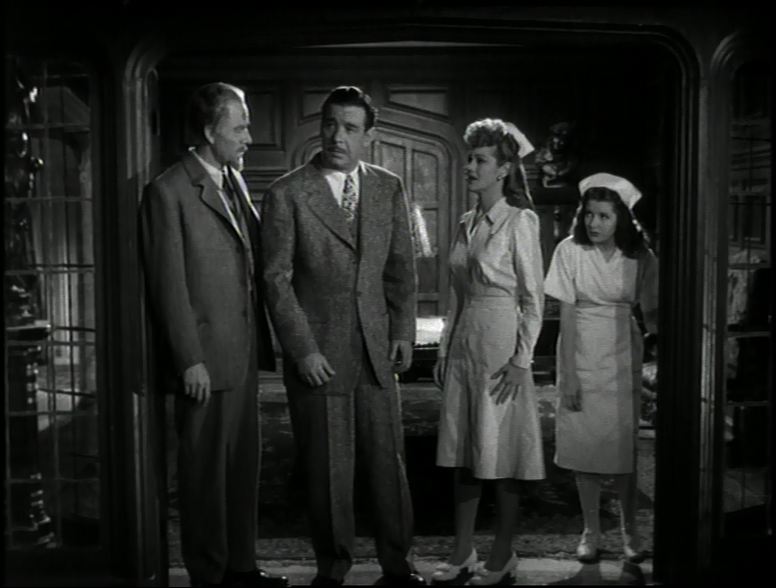
However, "Dr. Edlemann" believes that it is not the Full Moon that causes the transformation, but pressure on "Talbot's" brain. He is transferred to 'Edelmann's" castle. It seems everyone in these movies owns at least one castle.
"Talbot" though is despondent over the possibility of turning into the Wolfman again. He admits wanting to kill himself and jumps out of a window into the ocean. Which makes no sense as "Larry" knows he can't be killed. However for plot purposes he ends up in a cave under the castle. "Dr. Edlemann" goes in search of "Larry" and finds him along with the "Frankenstein" monster, Glenn Strange, still clutching the skeleton of " Dr.Niemann".
_NRFPT_01.jpg)
As with how "Dracula" and "Talbot" are still alive after the end of the "House of Frankenstein". This screenplay presents another hole as to how after sinking in quicksand in swamp near the village. The monster and "Niemann" ended up in an cave under "Edlemann's" castle by the ocean.
Meanwhile, "Dr. Edlemann" has been giving "Baron Latos" transfusions of blood and now makes a discovery of certain weird antibodies in "Dracula's" blood that are causing the vampirism. "Edlemann" believes he can now cure the Count, or Baron. However, "Latos" has been attempting to put the bite on "Milizia". Who on one occasion was saved by a crucifix. "Nina" follows "Baron Latos" and finds him again with "Milizia", but not casting a reflection in the mirror.

"Nina" informs "Dr. Edlemann" who prepares a blood mixture that will kill the vampire. While "Baron Latos" is being transfused. He hypnotizes both the doctor and "Nina" putting them to sleep and reverses the flow of the blood into "Dr. Edlemann". Who now becomes two personalities. At times he is the good doctor and at others an evil madman. Can you say "Dr. Jekyll and Mr. Hyde" revised?
When they come out of the spell "Edlemann" and "Nina" see "Dracula" carrying away "Milizia". The two get "Talbot" and go after "Baron Latos". Locating him the trio force him away from the girl by using a crucifix. "Dracula" heads for his coffin as the sun is rising, but is followed by the doctor. With "Dracula" in an open coffin "Dr. Edlemann" drags it into the sunlight killing the vampire for the second time by the same means as in "House of Frankenstein"..
The good doctor becomes his evil self and kills his gardener.

Back as his normal self the doctor performs the promised operation on "Lawrence Talbot" with success. "Larry" can go out in the Full Moon and there is no transformation. After all this time the curse has been lifted.

Meanwhile the townspeople think the Wolfman killed the gardener, but one of the villagers believes it is "Dr. Edlemann" and convinces them otherwise. A mob starts for the castle and the doctor transforms into his evil self and revives the monster.

"Edlemann" is surprised by how weak the monster is and "Nina' is shocked to see the kind doctor's transformation into his evil self. The doctor attacks "Nina" and breaks her neck. The police arrive and the weaken monster attacks them. While "Lawrence Talbot" shoots the evil "Dr. Edlemann" killing him and he reverts to the kindly doctor. A fire breaks out in the lab and "Larry" dumps over some shelving trapping "Frankenstein's" creation there. Everyone gets out of the castle as the roof collapses upon the monster.
The actual working title for the picture was "Dracula vs the Wolfman", but another possibility was the reverse "The Wolfman vs Dracula" considered for the pictures actual release.
Also in the adds, see the poster, and the trailers for the film. "Nina" was portrayed as a monster, because she portrayed the "HUNCHBACK". However, even more than "Lawrence Talbot", "Nina" was a very sympathetic character and not like the evil "Daniel" of the previous motion picture.
THE SHE-WOLF OF LONDON (MAY 17, 1946)
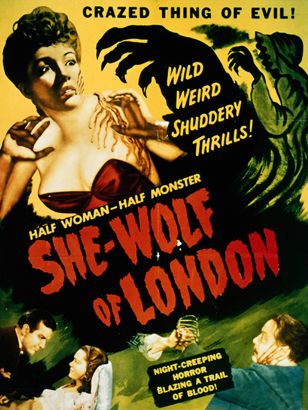
A great poster, but maybe a little bait and switch by Universal Studios and the screenplay by George Bicker. The obvious title is a play on 1935's "The Werewolf of London". The director of the picture was Jean Yarbrough and among his many assigned films were several Abbott and Costello comedies. 1940 saw Yarbrough's first feature length film "The Devil Bat" starring Bela Lugosi. The following year it was the horror/comedy "King of the Zombies" but in March of 1946 he wrote the low keyed thriller "House of Horrors" This very effective low budget film. in the style of Val Lewton. introduced Rondo Hatton as "The Creeper". Both Hatton and Jean Yarbrough would be back in fine form in both October 1946's "The Brute Man" and 1948's "The Creeper".
Between "House of Horrors" and "The Brute Man" was "The She-Wolf of London". "Phyllis Allenby" lives in "Allenby Mansion" with her "Aunt Martha" and "Cousin Carol". "Phyllis" was portrayed by June Lockhart. Lockhart had been in 1941's "Sergeant York" and 1944's "Meet Me In St. Louis", but it was her television work that she is remembered for mostly. She portrayed "Ruth Martin", mother of "Timmy", on "Lassie" from 1958 through 1964 for 200 episodes. Then opposite Guy Williams became "Maureen Robinson" on "Lost in Space" from 1956 to 1968 for 84 episodes. Followed by "Dr. Janet Craig" on "Petticoat Junction" 1968 to 1970 for 45 episodes.
Portraying her future husband "Barry Lanfield" was Don Porter. Porter like Lockhart was a solid film actor, but is also best remembered for three television roles. First he was Ann Southern's boss "Peter Sands" on "Private Secretary" from 1953 to 1957 for 103 episodes. Next "James Devery" on "The Ann Southern Show" from 1959 to 1961 for 45 episodes and "Professor Russel Lawrence" on the Sally Field show "Gidget" 1965 to 1966 for 32 episodes.

The role of "Aunt Martha Winthrop" is portrayed by Sara Haden. Character actress Haden was seen in Peter Lorre's 1935 "Mad Love", she appeared in Mickey Rooney's "Andy Hardy" film series as his "Aunt Milly Forest" and was "Lula Mae McManamee" in the 1953 James Cagney classic "A Lion in the Streets". Which was loosely based upon the life of Louisiana Politician Huey Long.
As the opening title card states:

As "Phyllis" and "Barry's" wedding date approaches. London is shocked by a series of murders with the throats of the victims ripped out as by an animal. A "Wolf-Women" has been seen prowling the local park in which the murders are taking place.


"Phyllis" starts believing that the "Curse" is real and she is turning into the "Wolf Women".

Is "Phyllis" turning into a werewolf in answer to the "Allenby Curse", or is she just going insane and having blackouts? The movie is very moody, well written and acted. As some reviewers have written. My reader might consider this feature as "Werewolf Legend Meets Alfred Hitchcock", but in the effective hands of director Jean Yarbrough.

When a suspicious detective visits the "Allenby Mansion" and is murdered almost immediately after that visit by the "Wolf Women". "Barry Lanfield" thinks something else is going on and will discover the truth. There is no female werewolf, but "Aunt Martha" fearing she and her daughter will be thrown out of the house once "Barry" marries "Phyllis". "Martha" brings the "Allenby Curse" to life in the hope of driving her niece insane. So she and "Carol" can live in the mansion.

The last werewolf movie of the 1940's is also considered the "swan song" for the "Classic" monsters of Universal Studios.
ABBOTT AND COSTELLO MEET FRANKENSTEIN (JUNE 15, 1948)

66 Year Old Bela Lugosi was back as "Dracula", Lon Chaney was back as "Lawrence Talbott" aka" "The Wolfman" and Glenn Strange made his third appearance as the "Frankenstein" monster. It seemed like we have the third "House" film, but these three classic monsters were now the fall guys of comedians Bud Abbott and Lou Costello.
The actual on screen title, that never changed, is "Bud Abbott and Lou Costello Meet Frankenstein". Check that out the next time you watch the picture. The movie was their 22nd motion picture together. From the writing of the original screenplay by Robert Lees, Fredric J. Rinaldo and John Grant until the shooting was completed. The title for the motion picture was to have been "The Brain of Frankenstein", but some shrewd person made the point that sounded like a Horror movie and would keep fans of the duo and families away.
Both Lees and Rinaldo wrote the screenplay for the Curt Siodmak comedy treatment of H.G. Wells 1940's "The Invisible Women" and both had Horror experience with the second Universal film based on Edgar Allan Poe's "The Raven" in 1941 starring Basil Rathbone, Broderick Crawford, Bela Lugosi and a young actor named Alan Ladd,
While John Grant had written 3 Abbott and Costello films prior to this and would write another 8 afterwards including "Abbott and Costello Meet the Killer, Boris Karloff", "Abbott and Costello Meet the Invisible Man" and "Abbott and Costello Meet the Mummy".
For those of my readers interested in all the Bud Abbott and Lou Costello monster films including a television appearance with "The Creature from the Black Lagoon" may article on these pictures can be read at:
http://www.bewaretheblog.com/2015/04/abbott-and-costello-meet-universal.html
The comedic tone for the audience of the film is set with the opening animated titles as they introduce the actors. Bud and Lou were a thin tall skeleton and a short fat one. For publicity purposes the following poster with the actors photo's were released. Note that Bud and Lou are on the bottom with the small photo of Glenn Strange, The photo at the top is actress Lenore Aubert who portrays "Dr. Sandra Mornay".

Lenore Aubert was a model and actress known for playing "Exotic" roles. Two of her films in 1946 were "The Catman of Paris" and "The Wife of Monte Cristo". After this film she appeared in "Abbott and Costello Meet the Killer, Boris Karloff".
The plot is very simple as the boys work at a railway station in Florida in the baggage department. While inspecting two newly arrived large crates the phone rings and Lou answers it. It is "Lawrence Talbot" calling from London, England, warning the boys that the two crates for "McDougal's House of Horrors" contains the actual bodies of "Dracula" and the "Frankenstein Monster", but before he can finish. "Larry" turns into the wolfman having Lou's "Wilbur Grey" telling him to keep his dog away from the phone.
"McDougal" arrives to claim his crates, but "Wilbur" mishandles one of them. The "House of Horrors" owner demands that "Wilbur" and "Chick Young", Abbott, deliver them to his business.
It is there the fun really kicks in as "Chick" starts reading the descriptions "McDougal" has for "Dracula" and the "Frankenstein" monster.
Of course "Dracula" leaves his coffin and with a ring, that has an electrical charge, reactivates the monster.

"Dracula" hypnotizes "Wilbur" so that along with the monster they can leave the "House of Horrors".
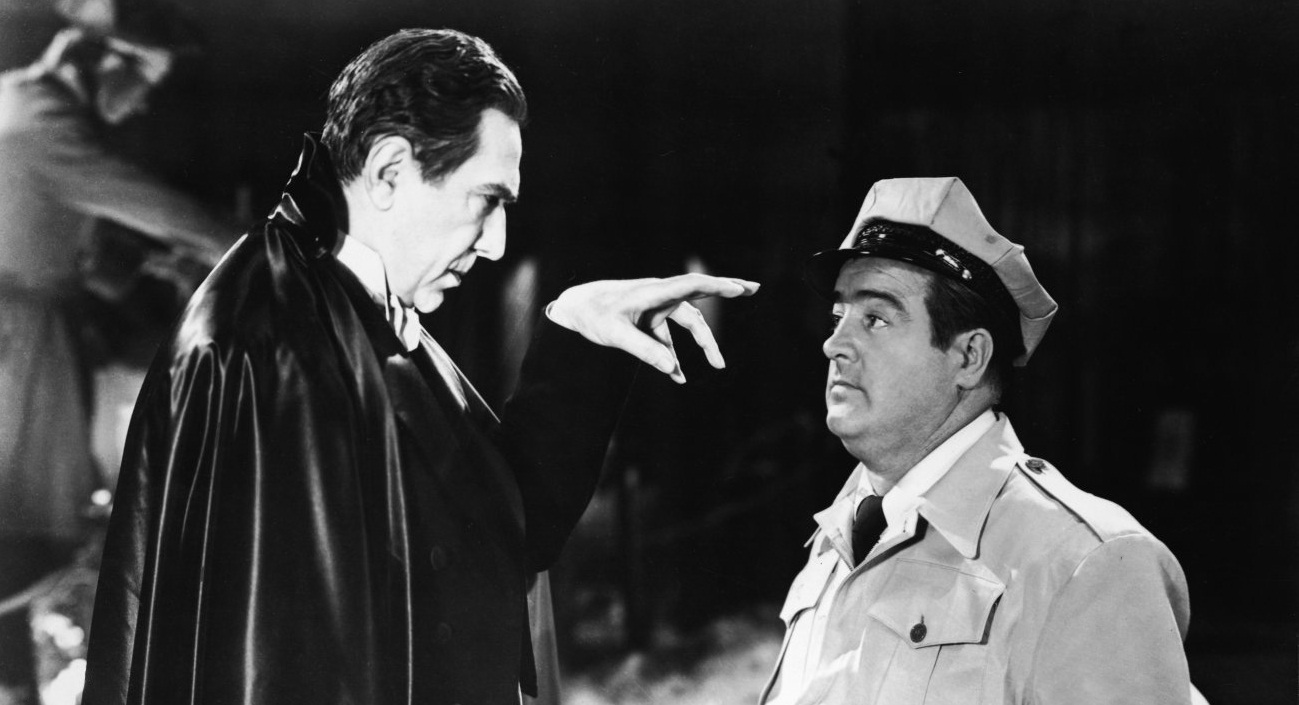
This leads to "Chck" not believing "Wilbur" that the two exhibits are alive and just "Walked Away", "McDougal" accuses Bud and Lou of stealing his exhibits and next the audience sees the arrival of an insurance investigator "Joan Raymond" portrayed by Jane Randolph. Her name should be familiar with my reader as Randolph was "Alice Moore" in Val Lewton's "Cat People" and "Alice Moore Reed in "The Curse of the Cat People".
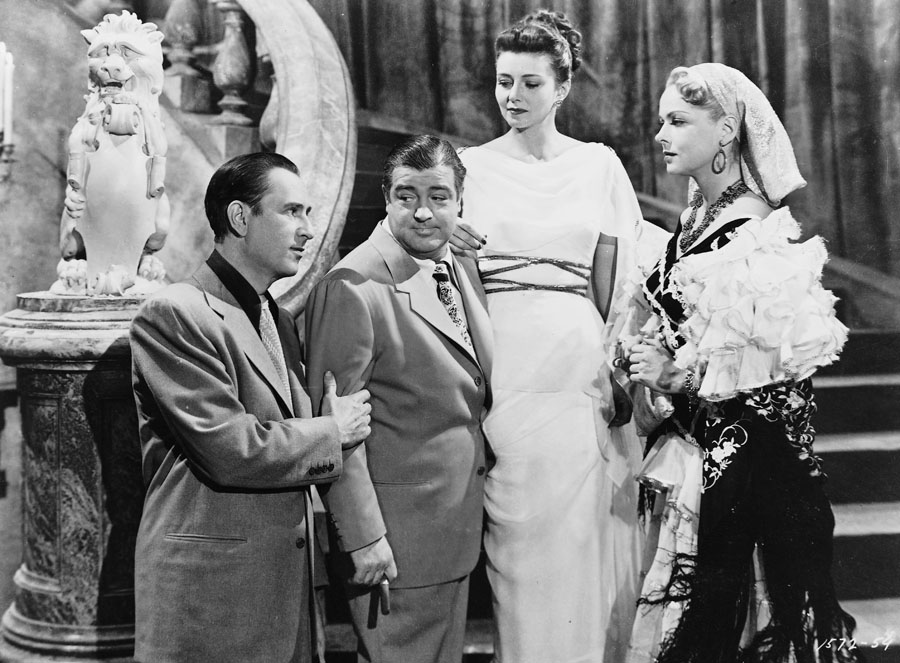
Above Bud, :Lou, Lenore Aubert and Jane Randolph. As "Chick" attempts to separate both "Dr. Mornay" and "Joan" from both being "Wilbur's" dates. Which is the underlining plot point and goes back to the original proposed title of the picture.
"Dr. Mornay" wants to put "Wilbur's" brain into the "Frankenstein" monster so that it is controllable for "Count Dracula". Who is using the name ""Dr. Lejos". Which sounds similar to John Carradine's
Baron Latos". Eventually the Count has to put the bite on "Mornay" to get her to operate on"Wilbur". "Joan", on the other hand, thinks "Wilbur" and "Chick" sold the exhibits and wants to get the shy "Wilbur" to confess.
Add to this group is 'Dr. Mornay's" assistant "Professor Stevens" portrayed by Charles Bradstreet. Bradstreet had only 10 movie roles and this was the second of three of them that he actually received screen credit. Below Bradstreet is on the far left.

Earlier "Lawrence Talbot" has arrived from England and is attempting to convince "Chick" and "Wilbur" the danger they are in, but they still don't believe him. They do agree to lock him in his bedroom at the hotel as there will be a Full Moon, but "Chick" just thinks he's crazier than "Wilbur". This leads to a little fun with Lou.

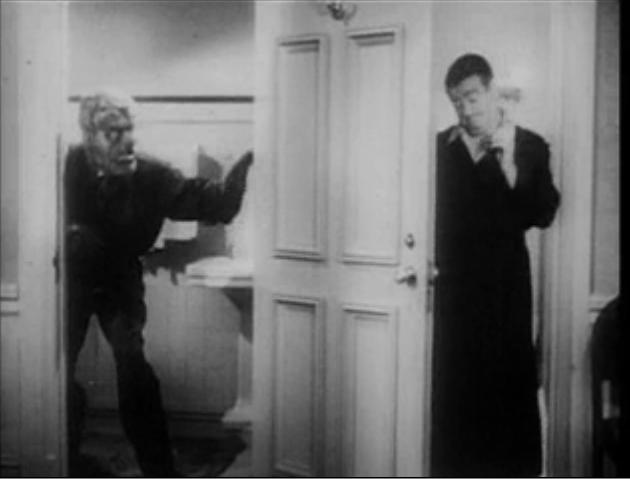
There is a difference to make-ups for both Lon and Glenn in this feature. At times more noticeable on the wolfman, because Jack Pierce was no longer at Universal. The new owners let him go and Bud Westmore was in charge and finding ways to cut cost and speed up the process.

Everything come to a head at the costume party. "McDougal" is there and is attacked by Lon, but thinks it was Bud who was wearing a wolf mask. Lou is taken prisoner and brought to "Dr Mornay's
castle in the Everglades. Don't ask how it got there. "Joan" has been hypnotized by "Dracula" and also brought there. It is now up to Lon, Bud and Charles to save Lou and Jane.
The film is full of sight gags and comic situations from this point until the ending.
In the end "Dracula" turns into a bat and "The Wolfman" catches it in flight and they tumble off a balcony to the rocks below. The audience is left to think they both died. The"Frankenstein" monster chases "Chick" and "Wilbur" out of the castle onto a boat dock. The boys get into a boat and row away. While "Professor Stevens" and "Joan Raymond" set the dock on fire burning the monster.
Cut to Bud and Lou in their boat. "Chick" tells "Wilbur" that with the monsters dead:
The United States and the World had changed at the end of World War 2. Allies such as the Soviet Union and China were now the enemy and enemies like Germany and Japan were now our friends.This era became known by two generic terms. One was the Atomic Age and the other the Cold War.
Motion picture also changed and the classic monsters of the 1930's and 1940's seem to vanish from our minds. Perhaps that's why when Universal Studio's made a deal with ZIV Television and "Shock Theatre" was born. Those films at that late hour impacted so much.
Monsters did exist in such features as 1953's "The Beast from 20,000 Fathoms", or 1954's "Gojira". However, these were prehistoric beasts affected by the atomic tests of the new world fear NUCLEAR WAR!
Most of the motion pictures for the first half of the 1950's were pure Science Fiction and invasion from Outer Space, or flights to Mars. My look at the Science Fiction of the 1950's may be read at:
http://www.bewaretheblog.com/2015/07/invaders-from-mars-except-when-they.html
The point is that it would take until 1956 for one of those classic monsters and in this case a werewolf to return to the big motion picture screen.
THE WEREWOLF (JULY 1, 1956)
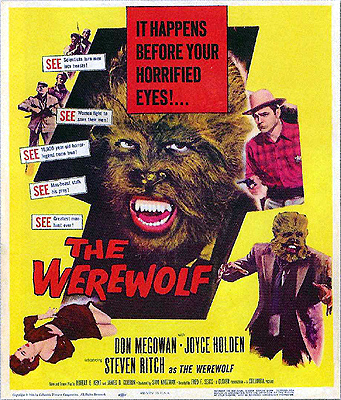
The studio was not Universal Pictures, but once again Columbia Pictures. I saw "The Werewolf" as part of a double bill at the Wiltern Theater in Los Angeles with Ray Harryhausen's the "Earth vs the Flying Saucers" back in 1956. The theater was originally built in 1931 and is today a renovated legitimate concert venue.
Harry "King" Cohn, the founder, owner and task master of Columbia had a producer that since 1933 could be given a low ball budget, bring a film in under that, and even make a profit off of the finished product. By 1956 Sam Katzman had been making Science Fictions pictures and serials off and on since the late 1940's. The titles included the first appearance of "Superman" in a 1948 serial of that name and its sequel "Atom Man vs Superman" in 1950. Between those he also produced 1949's "Batman and Robin". In 1955 the year before this picture. Katzman produced two Science Fiction films that have achieved cult status for different reasons. One was Ray Harryhausen's "It Came from Beneath the Sea" and the other was a low budget favorite of mine, starring Richard Denning, "The Creature with the Atom Brain".
The screenplay was by Robert E. Kent and a James B. Gordon. Gordon was a contract writer and did whatever he was assigned too. These included Westerns, Arabian Night stories, Detective films and adapting popular radio shows to movies. Kent had started writing back in 1937 and some of his varied titles include 1941's "Badmen of Missouri" about the Young Brothers with Dennis Morgan and Jane Wyman. 1946's "Dick Tracy vs Cueball" part of a series of "Tracy" features. 1953' s "Siren of Bagdad" starring Paul Henreid and Patricia Medina and 1956's "Rock Around the Clock" starring Bill Haley and the Comets. .
The screenplay has elements of Curt Siodmak's "The Wolfman". Especially with the character of "Duncan Marsh" as compared to "Lawrence Talbot", but instead of a transformation by either "Wolfbane" or the "Full Moon". The story deals with the Cold War/Atomic Age American fears of human annihilation.
"The Werewolf" was directed by Fred F. Sears. Sears had directed the popular musical biography "The Jolson Story". In `1955 he directed the explosive, a the time, true story of robber, kidnapper and rapist Caryl Chessman. His case garnished World wide attention and went towards abolishing the use of capital punishment over kidnapping. A crime that was the result of the Lindbergh baby kidnapping. The picture was based upon Chessman's book "Cell 2455: Death Row". Sears also directed "Earth vs the Flying Saucers" and in 1957 both "The Giant Claw" and "The Night the World Exploded".
"The Werewolf" opens with a man walking down the street of "Mountain Crest", actually Big Bear California, he enters a bar and while having a drink asks if anyone knows him? He pays with a $20 bill and starts to leave without getting his change. The man is followed by another from the bar and before an alley the other man demands his money. A fight pursues in the dark alley and the audience hears the sound of an animal. The stranger is seen leaving the alleyway by a women walking home. She screams and the stranger runs out of town. At this point the audience has not seen him, but knows he's the title character.
Later in the story the audience finds out that the man is "Duncan Marsh" portrayed by Steven Ritch. The weird thing is the opening credits stated:

Problem is Ritch had been acting in motion pictures and television since 1950. True his roles were small, but there were 15 the actor received credit for doing and only 4 non screen credited appearances.

Ritch is excellent as the tormented man trying to figure out who he is and whats happening to him. He wakes up in the snow with bare feet and sees wolf foot prints leading to the spot he was sleeping. Earlier a search party had attempted to find the stranger and the Deputy Sheriff had noticed they were following the footprints of a man wearing shoes, but then they changed to paw prints. He did not notice "Marsh's" shoes beside a dead tree stump. "Marsh" finds his shoes and heads for the small community to find a doctor. The deputy had been attacked by the werewolf and the Sheriff brings him to the doctor.
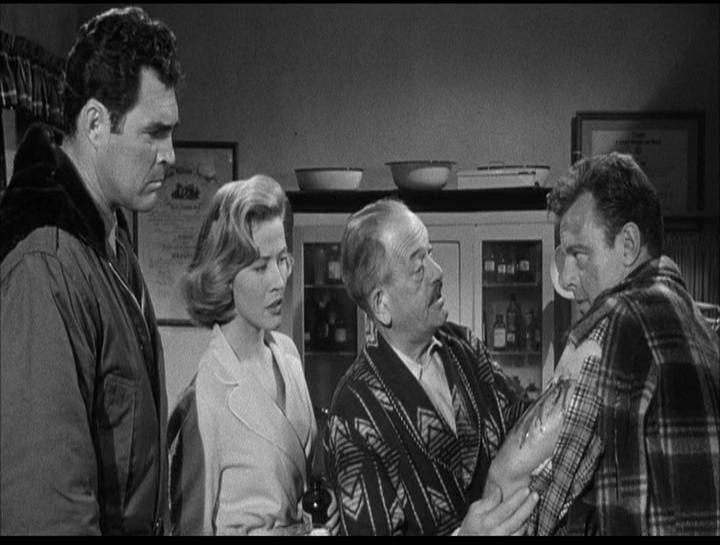
On the far right above is Harry Lauter as "Deputy Ben Clovey". Lauter's face should be familiar to "B" movie fans. The year before he was also a "Deputy Sheriff" in "It Came from Beneath the Sea". Between 1938 and 1979 Lauter portrayed 329 different characters. He was a major actor on early television Westerns such as "The Range Rider", "Annie Oakley" and "The Adeventures of Kit Carson". You can't miss Harry Lauter at the start of Robert Wise's 1951's "The Day the Earth Stood Still". He's the soldier that approaches the injured "Klaatu" and is told the item in the alien's hand was a present for the President of the United States.
"Sheriff Jack Haines" is portrayed by Don Megowan. Megowan had played "Jim Bowie" in Walt Disney's "Alamo" segment of "Davy Crockett, King of the Wild Frontier" on television. Also in 1956 Megowan was seen as the land version of "The Creature from the Black Lagoon" in the third movie "The Creature Walks Among Us". Don Megowan would be in Walt Disney's "The Great Locomotive Chase" later in 1956.
Below Ken Christy as "Dr. Jonas Gilchrist" speaks to "Sheriff Haines" about "Duncan Marsh". Who came to his office for help and the doctor believes may have a brain injury. Christy was a major radio personality in the 1930's. His most recognized movie role was as a reporter attempting to interview Gloria Swanson as "Norma Desmond" in Billy Wilder's 1950 classic "Sunset Boulevard".

The doctor's niece, nurse, and love interest for the Sheriff, "Amy Standish", is portrayed by Joyce Holden. Holden has a total movie and television appearances of 35. Besides this picture she is probably known for an extremely low budget Science Fiction feature 1958's "Terror from the Year 5,000".Below the earlier scene with Christy, Holden and Ritch.

While all of this is taking place the audience sees "Dr. Emery Forrest" and "Dr. Morgan Chambers" discussing the killings in "Mountain Crest". "Chambers" has been experimenting with radiation on animals attempting to create mutations that could survive in a future world after a nuclear holocaust. When the Earth's population is too large for the food supply. He injected a full dose of his experimental serum in to minor automobile accident victim, "Duncan Marsh", and created the werewolf. Which can remain in its wolf form during the daylight hours. Adding to the possibility of killing innocent people and further tormenting "Marsh".

Actor S. John Launer is seen on the left as "Dr. Forrest". Launer was mainly a television actor, but also had been seen in 1955's "The Creature with the Atomic Brain" and would be in 1957's "I Was a Teenage Werewolf". On the right is George Lynn as "Dr. Morgan Chambers". Lynn had been acting since 1936 and had been seen in Charlie Chaplin's 1940 classic "The Great Dictator", the serial "The Adventures of Captain Marvel" in 1941 and the hard hitting movie version of the radio detective series "The Naked City" in 1948 among 143 roles.
The two doctors go to "Mountain Crest" to kill, if the Sheriff doesn't, "Duncan Marsh" before their secret is revealed. They don't tell the Sheriff that at first and track "Marsh" on their own. The two find a trail into a cave like structure and "Chambers" talks "Forrest" into entering. There he finds "Duncan" who now remembers who the doctor is and what they did to him. "Duncan Marsh" shows "Dr. Emery Forrest" what they have created by transforming and going after him.
I WAS A TEENAGE WEREWOLF (JULY 19, 1957)
I'll explain later the poster's tag line:
Looking back today I could subtitle this Teen Horror flick as "The Revenge of Jack Pierce". Herman Cohen's story idea and Aben Kandel's screenplay is about a make-up artist for a major studio who had been designing monsters for decades. The picture was shot on the American International Lot. New owners purchase the studio and immediately fire him as being out of touch with modern make-up ideas. Sounds like somebody familiar with Pierce's life, because in 1958 for "Teenage Monster", "Giant from the Unknown" and the only one of the three worth a look. "I Bury the Living" starring Richard Boone and Theodore Bikel.
In this film make-up artist "Pete Dumond", portrayed by character actor Robert H. Harris, has developed a hypnotic make-up. At this time Harris was a regular guest star on television's "Alfred Hitchcock Presents" and was seen mostly on 1950's television, but had been in both 1957's "The Invisible Boy" and "Peyton Place".
Below "Pete Drumond" has applied his hypnotic make-up on the "Teenage Werewolf" to go out and kill the one of the executives that fired him. The werewolf was now played by Gary Clarke. He would play the character of "Steve Hill" for 63 episodes of television's "The Virginian" between 1962 and 1964. He was "Captain Richards" on television's "Hondo" in 1967 for 17 episodes.

Below Harris is fixing the make-up on the "Teenage Frankenstein" portrayed by Gary Conway. Conway did the role in the original 1957 feature also. From 1963 into 1965 he appeared in 64 episodes of Gene Barry's television program "Burke's Law" and co-starred from 1968 into 1970 for 51 episodes of "Land of the Giants".

"Dumond's" assistant "Rivero" was portrayed by Paul Brineger. Probably best known as the cook "Wishbone" on 216 episodes of television's "Rawhide".
Eventually the police catch on to what "Pete Dumond" is doing and head to his home to arrest the make-up artist. "Peter" had invited the two boys "Tony Mantell" and "Larry Drake" over to his home for a party. In reality it is to kill the boys and commit suicide.
This is were I explain that tag line as this black and white motion picture switches to color as fire engulf's "Pete's" home.
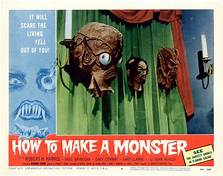

Note the monster heads on the curtains in the two lobby cards. American International Pictures wanted to get rid of items they no longer needed. So in the case of "How To Make A Monster" they destroyed in the fire sequence many of Make-up Artist and Monster Creator Paul Blaisdell's works. I cried when I first watched the film's ending in 1958.
Like the "The Cat People" the month after "How To Make A Monster" another variation of the werewolf tale created by Curt Siodmak was released reversing the concept slightly.
THE HIDEOUS SUN DEMON (AUGUST 29, 1958)
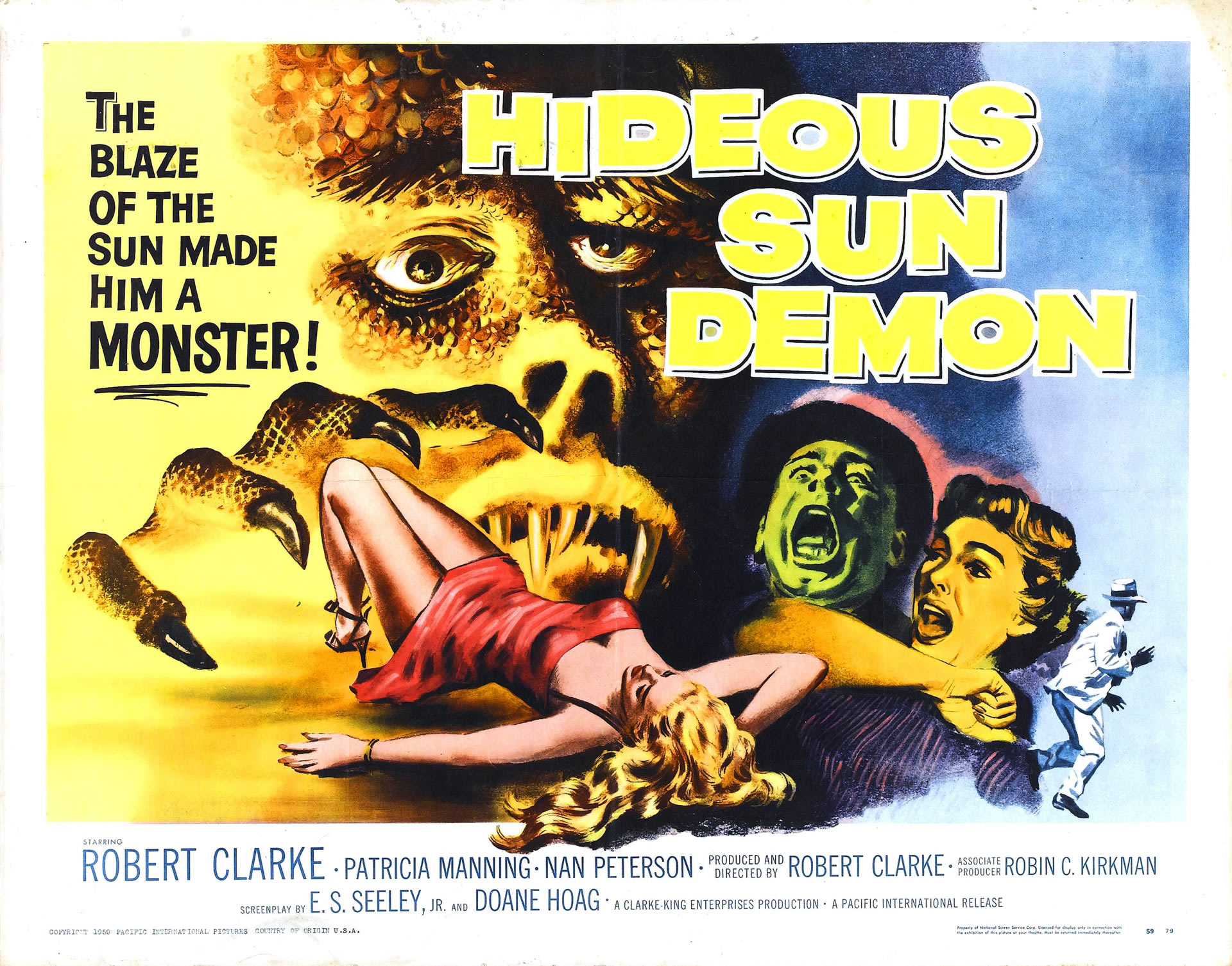
This story idea by the film's star and director has the "Sun" and not the "Moon" trigger a transformation from human into a lizard like animal.
Robert Clarke portrays "Dr. Gilbert McKenna" a research scientist experimenting with a new radioactive isotope when something goes terribly wrong with a large explosion destroying his lab..

Clarke had small roles in two Val Lewton productions. They were 1945's "The Body Snatcher" and as the inmate covered in gold paint in 1946's "Bedlam". Any true fan of early 1950's Science Fiction would recognize Robert Clarke for 1951's "The Man From Planet X".
I did a full biography of Clarke's career and films. You will find it at:
http://www.bewaretheblog.com/2017/05/robert-clarke-b-actor-or-hideous-sun.html
"Dr. McKenna's" attending physician is surprised that he shows no signs of radiation burns from the accident and has him taken to a solarium to receive the healing rays of the sun. Bad mistake as he turns into a Lizard like creature.

The story follows the tormented "Dr.Gil McKenna" as he kills, but seeks the night and darkness during the day to prevent the transformation. We're still in solid 1950's territory as with "I Was A Teenage Werewolf" and "The She Creature". It is thought that somehow the exposure to the isotope has created a reverse evolution.
The climax of the pictures takes place with a confrontation between the "Sun Demon" and the Los Angeles Police Department at a natural gas plant. A police officer will shoot the creature and it will fall from a tower to the ground returning to the form of "Dr. McKenna" after death. This low budget picture is also considered a cult classic.
On my 12th Birthday a Mexican comedy monster movie was released containing a werewolf.
EL CASTILLO DE LOS MONSTRUOS AKA: THE CASTLE OF THE MONSTERS (OCTOBER 16, 1958)
This was Mexico's answer to the two Universal Studios "House" features. The picture starred comedian "Clavillazo". Whose name translates as :Great Little Nail" and was really Jose Antonio Hipolito Espino Mora. He was very popular during the 1940's and 1950's and no matter what the role had a catch phase:
Basically "Beatrice" is hypnotized to lure her to the castle of a mad scientist and our hero goes to rescue her. Although the name is not used in the original Spanish language version of the picture. The mad scientist in the English language dub is called "Dr. Sputnik". The Russian satellite had been lunched on October 4, 1957.
The film features many rip off's of Universal Studios monsters in comic situations. The "Frankenstein" monster is the butler.

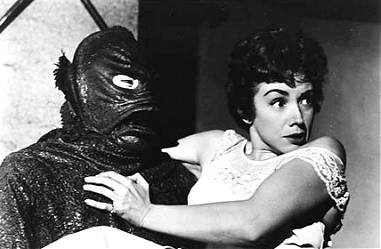
Below is the excellent Germain Robles who portrayed many vampire roles staring with "El Vampiro" in 1957. Robles portrayal in that film influenced Christoper Lee's portrayal in Hammer's "Dracula" aka: "The Horror of Dracula" according to several interviews with Lee.

Below is the film's version of a werewolf.

The monster throws "Daniel" through a window killing him and then takes "Niemann" in its arms and heads for the village.

The two are chased into the swamps. The monster walks with the now conscious and screaming "Dr. Niemann" into quicksand were they sink. End of film.
At the time of the picture's release A.H. Wheeler in his review for "The New York Times" wrote comparing all the monsters in the line up to:
a baseball team with nine Babe Ruth's, only this grisly congress doesn't hit hard; it merely has speed and a change of pace. As such, then, it is bound to garner as many chuckles as it does chills. However, lampoon or no, put this item down as a bargain for the bogie hunters.
HOUSE OF DRACULA (DECEMBER 7, 1945)

Erle C. Kenton was back directing and Paul Malvern producing the next Universal Monster Fest. The screenplay was by Edward T. Lowe, Jr. once again, but not from a Curt Siodmak story. The story was apparently created by two non screen credited writers. One was Dwight V. Babcock who had developed the story for 1944's "The Mummy's Ghost" and the other George Bricker who developed the story for 1940's "The Devil Bat".
There is no explanation as to why "Baron Latos" aka: "Count Dracula", again portrayed by John Carradine, is now alive after being destroyed in the previous film. One night he shows up at "Dr. Franz Edlemann:s" house seeking help from the doctor to cure his vampirism. Portraying "Dr. Edlemann" is Onslow Stevens. Among his roles was "Aramis" in the 1935 "The Three Musketeers", in 1941 he appeared in "The Monster and the Girl" about a man's brain being put in a gorilla's and in 1954 was seen as "Brigadier General Robert O'Brien" in the Science Fiction classic "THEM!".
Above Onslow Stevens with Glenn Strange.
"Dr. Edlemann" has two female assistants. One is "Milizia Morette" portrayed by Martha O'Droscoll. She portrayed "Daisy Mae Scraggs" in the 1940 "Li'l Abner" based upon the comic strip and starring Pre-Walt Disney Jeff York in the title role. She was also in Cecil B. DeMille's "Reap the Wild Wind" starring John Wayne and Paulette Goddard.

The other assistant was "Nina" portrayed by Jane "Poni" Adams. "Nina" is the picture's hunchback. She was also the screens first "Vicki Vale" in the 1949 Columbia serial "Batman and Robin" and appeared back in 1946 in the serial "Lost City of the Jungle". That same year she appeared in the thriller "The Brute Man" starring Rondo Hatton.
_01.jpg)
So who also should be in the neighborhood and come knocking at the doctor's door, but "Lawrence Talbot". Once more looking for a cure from being turned into a werewolf and wearing a mustache as a disguise. As with the "Baron Latos" how he is still alive is never explained.
Actually,"Larry" realizes the Full Moon is coming and has the police incarcerate him to protect the village. The police call the Doctor and he arrives in time to see the jailed "Talbot" turn into the Wolfman.

However, "Dr. Edlemann" believes that it is not the Full Moon that causes the transformation, but pressure on "Talbot's" brain. He is transferred to 'Edelmann's" castle. It seems everyone in these movies owns at least one castle.
"Talbot" though is despondent over the possibility of turning into the Wolfman again. He admits wanting to kill himself and jumps out of a window into the ocean. Which makes no sense as "Larry" knows he can't be killed. However for plot purposes he ends up in a cave under the castle. "Dr. Edlemann" goes in search of "Larry" and finds him along with the "Frankenstein" monster, Glenn Strange, still clutching the skeleton of " Dr.Niemann".
_NRFPT_01.jpg)
As with how "Dracula" and "Talbot" are still alive after the end of the "House of Frankenstein". This screenplay presents another hole as to how after sinking in quicksand in swamp near the village. The monster and "Niemann" ended up in an cave under "Edlemann's" castle by the ocean.
Meanwhile, "Dr. Edlemann" has been giving "Baron Latos" transfusions of blood and now makes a discovery of certain weird antibodies in "Dracula's" blood that are causing the vampirism. "Edlemann" believes he can now cure the Count, or Baron. However, "Latos" has been attempting to put the bite on "Milizia". Who on one occasion was saved by a crucifix. "Nina" follows "Baron Latos" and finds him again with "Milizia", but not casting a reflection in the mirror.

"Nina" informs "Dr. Edlemann" who prepares a blood mixture that will kill the vampire. While "Baron Latos" is being transfused. He hypnotizes both the doctor and "Nina" putting them to sleep and reverses the flow of the blood into "Dr. Edlemann". Who now becomes two personalities. At times he is the good doctor and at others an evil madman. Can you say "Dr. Jekyll and Mr. Hyde" revised?
When they come out of the spell "Edlemann" and "Nina" see "Dracula" carrying away "Milizia". The two get "Talbot" and go after "Baron Latos". Locating him the trio force him away from the girl by using a crucifix. "Dracula" heads for his coffin as the sun is rising, but is followed by the doctor. With "Dracula" in an open coffin "Dr. Edlemann" drags it into the sunlight killing the vampire for the second time by the same means as in "House of Frankenstein"..
The good doctor becomes his evil self and kills his gardener.
Back as his normal self the doctor performs the promised operation on "Lawrence Talbot" with success. "Larry" can go out in the Full Moon and there is no transformation. After all this time the curse has been lifted.

Meanwhile the townspeople think the Wolfman killed the gardener, but one of the villagers believes it is "Dr. Edlemann" and convinces them otherwise. A mob starts for the castle and the doctor transforms into his evil self and revives the monster.

"Edlemann" is surprised by how weak the monster is and "Nina' is shocked to see the kind doctor's transformation into his evil self. The doctor attacks "Nina" and breaks her neck. The police arrive and the weaken monster attacks them. While "Lawrence Talbot" shoots the evil "Dr. Edlemann" killing him and he reverts to the kindly doctor. A fire breaks out in the lab and "Larry" dumps over some shelving trapping "Frankenstein's" creation there. Everyone gets out of the castle as the roof collapses upon the monster.
The actual working title for the picture was "Dracula vs the Wolfman", but another possibility was the reverse "The Wolfman vs Dracula" considered for the pictures actual release.
Also in the adds, see the poster, and the trailers for the film. "Nina" was portrayed as a monster, because she portrayed the "HUNCHBACK". However, even more than "Lawrence Talbot", "Nina" was a very sympathetic character and not like the evil "Daniel" of the previous motion picture.
THE SHE-WOLF OF LONDON (MAY 17, 1946)

A great poster, but maybe a little bait and switch by Universal Studios and the screenplay by George Bicker. The obvious title is a play on 1935's "The Werewolf of London". The director of the picture was Jean Yarbrough and among his many assigned films were several Abbott and Costello comedies. 1940 saw Yarbrough's first feature length film "The Devil Bat" starring Bela Lugosi. The following year it was the horror/comedy "King of the Zombies" but in March of 1946 he wrote the low keyed thriller "House of Horrors" This very effective low budget film. in the style of Val Lewton. introduced Rondo Hatton as "The Creeper". Both Hatton and Jean Yarbrough would be back in fine form in both October 1946's "The Brute Man" and 1948's "The Creeper".
Between "House of Horrors" and "The Brute Man" was "The She-Wolf of London". "Phyllis Allenby" lives in "Allenby Mansion" with her "Aunt Martha" and "Cousin Carol". "Phyllis" was portrayed by June Lockhart. Lockhart had been in 1941's "Sergeant York" and 1944's "Meet Me In St. Louis", but it was her television work that she is remembered for mostly. She portrayed "Ruth Martin", mother of "Timmy", on "Lassie" from 1958 through 1964 for 200 episodes. Then opposite Guy Williams became "Maureen Robinson" on "Lost in Space" from 1956 to 1968 for 84 episodes. Followed by "Dr. Janet Craig" on "Petticoat Junction" 1968 to 1970 for 45 episodes.
Portraying her future husband "Barry Lanfield" was Don Porter. Porter like Lockhart was a solid film actor, but is also best remembered for three television roles. First he was Ann Southern's boss "Peter Sands" on "Private Secretary" from 1953 to 1957 for 103 episodes. Next "James Devery" on "The Ann Southern Show" from 1959 to 1961 for 45 episodes and "Professor Russel Lawrence" on the Sally Field show "Gidget" 1965 to 1966 for 32 episodes.

The role of "Aunt Martha Winthrop" is portrayed by Sara Haden. Character actress Haden was seen in Peter Lorre's 1935 "Mad Love", she appeared in Mickey Rooney's "Andy Hardy" film series as his "Aunt Milly Forest" and was "Lula Mae McManamee" in the 1953 James Cagney classic "A Lion in the Streets". Which was loosely based upon the life of Louisiana Politician Huey Long.
As the opening title card states:

As "Phyllis" and "Barry's" wedding date approaches. London is shocked by a series of murders with the throats of the victims ripped out as by an animal. A "Wolf-Women" has been seen prowling the local park in which the murders are taking place.


"Phyllis" starts believing that the "Curse" is real and she is turning into the "Wolf Women".

Is "Phyllis" turning into a werewolf in answer to the "Allenby Curse", or is she just going insane and having blackouts? The movie is very moody, well written and acted. As some reviewers have written. My reader might consider this feature as "Werewolf Legend Meets Alfred Hitchcock", but in the effective hands of director Jean Yarbrough.

When a suspicious detective visits the "Allenby Mansion" and is murdered almost immediately after that visit by the "Wolf Women". "Barry Lanfield" thinks something else is going on and will discover the truth. There is no female werewolf, but "Aunt Martha" fearing she and her daughter will be thrown out of the house once "Barry" marries "Phyllis". "Martha" brings the "Allenby Curse" to life in the hope of driving her niece insane. So she and "Carol" can live in the mansion.

The last werewolf movie of the 1940's is also considered the "swan song" for the "Classic" monsters of Universal Studios.
ABBOTT AND COSTELLO MEET FRANKENSTEIN (JUNE 15, 1948)

66 Year Old Bela Lugosi was back as "Dracula", Lon Chaney was back as "Lawrence Talbott" aka" "The Wolfman" and Glenn Strange made his third appearance as the "Frankenstein" monster. It seemed like we have the third "House" film, but these three classic monsters were now the fall guys of comedians Bud Abbott and Lou Costello.
The actual on screen title, that never changed, is "Bud Abbott and Lou Costello Meet Frankenstein". Check that out the next time you watch the picture. The movie was their 22nd motion picture together. From the writing of the original screenplay by Robert Lees, Fredric J. Rinaldo and John Grant until the shooting was completed. The title for the motion picture was to have been "The Brain of Frankenstein", but some shrewd person made the point that sounded like a Horror movie and would keep fans of the duo and families away.
Both Lees and Rinaldo wrote the screenplay for the Curt Siodmak comedy treatment of H.G. Wells 1940's "The Invisible Women" and both had Horror experience with the second Universal film based on Edgar Allan Poe's "The Raven" in 1941 starring Basil Rathbone, Broderick Crawford, Bela Lugosi and a young actor named Alan Ladd,
While John Grant had written 3 Abbott and Costello films prior to this and would write another 8 afterwards including "Abbott and Costello Meet the Killer, Boris Karloff", "Abbott and Costello Meet the Invisible Man" and "Abbott and Costello Meet the Mummy".
For those of my readers interested in all the Bud Abbott and Lou Costello monster films including a television appearance with "The Creature from the Black Lagoon" may article on these pictures can be read at:
http://www.bewaretheblog.com/2015/04/abbott-and-costello-meet-universal.html
The comedic tone for the audience of the film is set with the opening animated titles as they introduce the actors. Bud and Lou were a thin tall skeleton and a short fat one. For publicity purposes the following poster with the actors photo's were released. Note that Bud and Lou are on the bottom with the small photo of Glenn Strange, The photo at the top is actress Lenore Aubert who portrays "Dr. Sandra Mornay".

Lenore Aubert was a model and actress known for playing "Exotic" roles. Two of her films in 1946 were "The Catman of Paris" and "The Wife of Monte Cristo". After this film she appeared in "Abbott and Costello Meet the Killer, Boris Karloff".
The plot is very simple as the boys work at a railway station in Florida in the baggage department. While inspecting two newly arrived large crates the phone rings and Lou answers it. It is "Lawrence Talbot" calling from London, England, warning the boys that the two crates for "McDougal's House of Horrors" contains the actual bodies of "Dracula" and the "Frankenstein Monster", but before he can finish. "Larry" turns into the wolfman having Lou's "Wilbur Grey" telling him to keep his dog away from the phone.
"McDougal" arrives to claim his crates, but "Wilbur" mishandles one of them. The "House of Horrors" owner demands that "Wilbur" and "Chick Young", Abbott, deliver them to his business.
It is there the fun really kicks in as "Chick" starts reading the descriptions "McDougal" has for "Dracula" and the "Frankenstein" monster.
Of course "Dracula" leaves his coffin and with a ring, that has an electrical charge, reactivates the monster.

"Dracula" hypnotizes "Wilbur" so that along with the monster they can leave the "House of Horrors".

This leads to "Chck" not believing "Wilbur" that the two exhibits are alive and just "Walked Away", "McDougal" accuses Bud and Lou of stealing his exhibits and next the audience sees the arrival of an insurance investigator "Joan Raymond" portrayed by Jane Randolph. Her name should be familiar with my reader as Randolph was "Alice Moore" in Val Lewton's "Cat People" and "Alice Moore Reed in "The Curse of the Cat People".

Above Bud, :Lou, Lenore Aubert and Jane Randolph. As "Chick" attempts to separate both "Dr. Mornay" and "Joan" from both being "Wilbur's" dates. Which is the underlining plot point and goes back to the original proposed title of the picture.
"Dr. Mornay" wants to put "Wilbur's" brain into the "Frankenstein" monster so that it is controllable for "Count Dracula". Who is using the name ""Dr. Lejos". Which sounds similar to John Carradine's
Baron Latos". Eventually the Count has to put the bite on "Mornay" to get her to operate on"Wilbur". "Joan", on the other hand, thinks "Wilbur" and "Chick" sold the exhibits and wants to get the shy "Wilbur" to confess.
Add to this group is 'Dr. Mornay's" assistant "Professor Stevens" portrayed by Charles Bradstreet. Bradstreet had only 10 movie roles and this was the second of three of them that he actually received screen credit. Below Bradstreet is on the far left.

Earlier "Lawrence Talbot" has arrived from England and is attempting to convince "Chick" and "Wilbur" the danger they are in, but they still don't believe him. They do agree to lock him in his bedroom at the hotel as there will be a Full Moon, but "Chick" just thinks he's crazier than "Wilbur". This leads to a little fun with Lou.


There is a difference to make-ups for both Lon and Glenn in this feature. At times more noticeable on the wolfman, because Jack Pierce was no longer at Universal. The new owners let him go and Bud Westmore was in charge and finding ways to cut cost and speed up the process.

Everything come to a head at the costume party. "McDougal" is there and is attacked by Lon, but thinks it was Bud who was wearing a wolf mask. Lou is taken prisoner and brought to "Dr Mornay's
castle in the Everglades. Don't ask how it got there. "Joan" has been hypnotized by "Dracula" and also brought there. It is now up to Lon, Bud and Charles to save Lou and Jane.
The film is full of sight gags and comic situations from this point until the ending.
In the end "Dracula" turns into a bat and "The Wolfman" catches it in flight and they tumble off a balcony to the rocks below. The audience is left to think they both died. The"Frankenstein" monster chases "Chick" and "Wilbur" out of the castle onto a boat dock. The boys get into a boat and row away. While "Professor Stevens" and "Joan Raymond" set the dock on fire burning the monster.
Cut to Bud and Lou in their boat. "Chick" tells "Wilbur" that with the monsters dead:
there's nobody to scare us anymoreWhen a cigarette is lighted and Vincent Price's voice is heard:
Oh, that's too bad. I was hoping to get in on the excitement. Allow me to introduce myself—I'm the Invisible Man!
The United States and the World had changed at the end of World War 2. Allies such as the Soviet Union and China were now the enemy and enemies like Germany and Japan were now our friends.This era became known by two generic terms. One was the Atomic Age and the other the Cold War.
Motion picture also changed and the classic monsters of the 1930's and 1940's seem to vanish from our minds. Perhaps that's why when Universal Studio's made a deal with ZIV Television and "Shock Theatre" was born. Those films at that late hour impacted so much.
Monsters did exist in such features as 1953's "The Beast from 20,000 Fathoms", or 1954's "Gojira". However, these were prehistoric beasts affected by the atomic tests of the new world fear NUCLEAR WAR!
Most of the motion pictures for the first half of the 1950's were pure Science Fiction and invasion from Outer Space, or flights to Mars. My look at the Science Fiction of the 1950's may be read at:
http://www.bewaretheblog.com/2015/07/invaders-from-mars-except-when-they.html
The point is that it would take until 1956 for one of those classic monsters and in this case a werewolf to return to the big motion picture screen.
THE WEREWOLF (JULY 1, 1956)

The studio was not Universal Pictures, but once again Columbia Pictures. I saw "The Werewolf" as part of a double bill at the Wiltern Theater in Los Angeles with Ray Harryhausen's the "Earth vs the Flying Saucers" back in 1956. The theater was originally built in 1931 and is today a renovated legitimate concert venue.
Harry "King" Cohn, the founder, owner and task master of Columbia had a producer that since 1933 could be given a low ball budget, bring a film in under that, and even make a profit off of the finished product. By 1956 Sam Katzman had been making Science Fictions pictures and serials off and on since the late 1940's. The titles included the first appearance of "Superman" in a 1948 serial of that name and its sequel "Atom Man vs Superman" in 1950. Between those he also produced 1949's "Batman and Robin". In 1955 the year before this picture. Katzman produced two Science Fiction films that have achieved cult status for different reasons. One was Ray Harryhausen's "It Came from Beneath the Sea" and the other was a low budget favorite of mine, starring Richard Denning, "The Creature with the Atom Brain".
The screenplay was by Robert E. Kent and a James B. Gordon. Gordon was a contract writer and did whatever he was assigned too. These included Westerns, Arabian Night stories, Detective films and adapting popular radio shows to movies. Kent had started writing back in 1937 and some of his varied titles include 1941's "Badmen of Missouri" about the Young Brothers with Dennis Morgan and Jane Wyman. 1946's "Dick Tracy vs Cueball" part of a series of "Tracy" features. 1953' s "Siren of Bagdad" starring Paul Henreid and Patricia Medina and 1956's "Rock Around the Clock" starring Bill Haley and the Comets. .
The screenplay has elements of Curt Siodmak's "The Wolfman". Especially with the character of "Duncan Marsh" as compared to "Lawrence Talbot", but instead of a transformation by either "Wolfbane" or the "Full Moon". The story deals with the Cold War/Atomic Age American fears of human annihilation.
"The Werewolf" was directed by Fred F. Sears. Sears had directed the popular musical biography "The Jolson Story". In `1955 he directed the explosive, a the time, true story of robber, kidnapper and rapist Caryl Chessman. His case garnished World wide attention and went towards abolishing the use of capital punishment over kidnapping. A crime that was the result of the Lindbergh baby kidnapping. The picture was based upon Chessman's book "Cell 2455: Death Row". Sears also directed "Earth vs the Flying Saucers" and in 1957 both "The Giant Claw" and "The Night the World Exploded".
"The Werewolf" opens with a man walking down the street of "Mountain Crest", actually Big Bear California, he enters a bar and while having a drink asks if anyone knows him? He pays with a $20 bill and starts to leave without getting his change. The man is followed by another from the bar and before an alley the other man demands his money. A fight pursues in the dark alley and the audience hears the sound of an animal. The stranger is seen leaving the alleyway by a women walking home. She screams and the stranger runs out of town. At this point the audience has not seen him, but knows he's the title character.
Later in the story the audience finds out that the man is "Duncan Marsh" portrayed by Steven Ritch. The weird thing is the opening credits stated:
Problem is Ritch had been acting in motion pictures and television since 1950. True his roles were small, but there were 15 the actor received credit for doing and only 4 non screen credited appearances.

Ritch is excellent as the tormented man trying to figure out who he is and whats happening to him. He wakes up in the snow with bare feet and sees wolf foot prints leading to the spot he was sleeping. Earlier a search party had attempted to find the stranger and the Deputy Sheriff had noticed they were following the footprints of a man wearing shoes, but then they changed to paw prints. He did not notice "Marsh's" shoes beside a dead tree stump. "Marsh" finds his shoes and heads for the small community to find a doctor. The deputy had been attacked by the werewolf and the Sheriff brings him to the doctor.

On the far right above is Harry Lauter as "Deputy Ben Clovey". Lauter's face should be familiar to "B" movie fans. The year before he was also a "Deputy Sheriff" in "It Came from Beneath the Sea". Between 1938 and 1979 Lauter portrayed 329 different characters. He was a major actor on early television Westerns such as "The Range Rider", "Annie Oakley" and "The Adeventures of Kit Carson". You can't miss Harry Lauter at the start of Robert Wise's 1951's "The Day the Earth Stood Still". He's the soldier that approaches the injured "Klaatu" and is told the item in the alien's hand was a present for the President of the United States.
"Sheriff Jack Haines" is portrayed by Don Megowan. Megowan had played "Jim Bowie" in Walt Disney's "Alamo" segment of "Davy Crockett, King of the Wild Frontier" on television. Also in 1956 Megowan was seen as the land version of "The Creature from the Black Lagoon" in the third movie "The Creature Walks Among Us". Don Megowan would be in Walt Disney's "The Great Locomotive Chase" later in 1956.
Below Ken Christy as "Dr. Jonas Gilchrist" speaks to "Sheriff Haines" about "Duncan Marsh". Who came to his office for help and the doctor believes may have a brain injury. Christy was a major radio personality in the 1930's. His most recognized movie role was as a reporter attempting to interview Gloria Swanson as "Norma Desmond" in Billy Wilder's 1950 classic "Sunset Boulevard".

The doctor's niece, nurse, and love interest for the Sheriff, "Amy Standish", is portrayed by Joyce Holden. Holden has a total movie and television appearances of 35. Besides this picture she is probably known for an extremely low budget Science Fiction feature 1958's "Terror from the Year 5,000".Below the earlier scene with Christy, Holden and Ritch.

While all of this is taking place the audience sees "Dr. Emery Forrest" and "Dr. Morgan Chambers" discussing the killings in "Mountain Crest". "Chambers" has been experimenting with radiation on animals attempting to create mutations that could survive in a future world after a nuclear holocaust. When the Earth's population is too large for the food supply. He injected a full dose of his experimental serum in to minor automobile accident victim, "Duncan Marsh", and created the werewolf. Which can remain in its wolf form during the daylight hours. Adding to the possibility of killing innocent people and further tormenting "Marsh".

Actor S. John Launer is seen on the left as "Dr. Forrest". Launer was mainly a television actor, but also had been seen in 1955's "The Creature with the Atomic Brain" and would be in 1957's "I Was a Teenage Werewolf". On the right is George Lynn as "Dr. Morgan Chambers". Lynn had been acting since 1936 and had been seen in Charlie Chaplin's 1940 classic "The Great Dictator", the serial "The Adventures of Captain Marvel" in 1941 and the hard hitting movie version of the radio detective series "The Naked City" in 1948 among 143 roles.
The two doctors go to "Mountain Crest" to kill, if the Sheriff doesn't, "Duncan Marsh" before their secret is revealed. They don't tell the Sheriff that at first and track "Marsh" on their own. The two find a trail into a cave like structure and "Chambers" talks "Forrest" into entering. There he finds "Duncan" who now remembers who the doctor is and what they did to him. "Duncan Marsh" shows "Dr. Emery Forrest" what they have created by transforming and going after him.
"Dr. Forrest" is able to get out of the cave and "Dr. Chambers" shoots at the werewolf, misses, and "Duncan" escapes. The shot is heard by the Sheriff with a small group of men. They arrive and he asks who the two men are? Afterwards he chews them out, because the Sheriff's group was closing in on "Marsh". He order the doctor's back to town and to report to him once he returns. However, all he gets is that "Marsh" was a patient of theirs. The two doctors remain in "Mountain Crest" to figure their next move.
Meanwhile it is discovered the "Duncan" has a wife and young boy on the way to "Mountain Crest". Now the problem is does the Sheriff go after "Marsh" and kill him or perhaps as "Amy" and her Uncle suggest. Try to capture him alive? Bear traps are set with raw meat.
One works and the werewolf gets its left leg caught, but pulls the bear trap apart and falls to the ground turning back into "Duncan Marsh". His wife convinces the Sheriff to take her with him to bring "Duncan" back alive. The wife had overheard "Jack", "Amy" and her Uncle discussing the situation.
A group consisting of "Jack", "Amy", "Ben", "Mrs Marsh and her Son" go in search of "Duncan Marsh". They are able to find him and get "Duncan" back to the Sheriff's office. Where he agrees to wait in a cell for the hospital transport to arrive.
It is still believed that this condition is of the brain and can be cured. Although the Sheriff now has heard from another Police Department that Doctor's "Forrest" and "Chambers" had only treated "Marsh" for a minor car accident and is now wondering why they are still in town.
The following day convinced that everything will now be alright. "Mrs. Marsh" and her son leave "Mountain Crest". "Duncan" had pleaded with them not to stay and promised that once he's cured. He will contact the two to come and visit him, or return home to his family.
That night "Forrest" and "Chambers" trick "Ben Clovey" to come out of the Sheriff's Office and use ether on him. The two take the keys to the cells and enter the one with the apparent sleeping "Duncan Marsh". They find their werewolf instead and are both brutally killed. The werewolf escapes into the hills and this time the Sheriff has no choice but to kill him.
Searching at night is hard even by torchlight. An Aside: Have to wonder how many fire engines were on stand by, because not only do you have these men walking around in a beautiful forest with burning torches. At one point they see the werewolf and start throwing them at him between trees and on grassy areas.
It's decided to wait until morning and in the daylight "Duncan Marsh/Werewolf" is spotted heading toward a bridge over the highway. The climax comes and the werewolf is killed and returns to looking like "Duncan" before everyone's eyes.
My reader should note that Steven Ritch's make-up is similar to Matt Willis' in "The Return of the Vampire".
I WAS A TEENAGE WEREWOLF (JULY 19, 1957)
In the 1950's the new medium of television took off and entire families were watching what became known as "The Boob Tube". The impact on the major studios was almost devastating as entire families stayed home to watch "Ed Sullivan", Westerns and dramatic anthology programs. To lure people back into the theaters the major studios created 3-D, CinemaScope, Cinerama and even Smell-A-Vision.
However, a group of Independent production companies were realizing that the money now wasn't with the adults, but teens, pre-teens and the phenomena of the Drive-in Movie Theater. These small companies came together and formed American International Pictures. Smartly aiming their product at this new demographic/ That their parents were all too ready to give them their 50 to 75 cents to see a double bill on the weekends. I know I was one.
Previously in the early part of the 1950's there had been features like 1953's "Cat Women of the Moon". 1954's "GOG" from Ivan Tors and the same years big budgeted "20,000 Leagues Under the Sea" from Walt Disney. Another Science Fiction picture with a large budget was 1956's "Forbidden Planet".
However, it was 1957's "I Was A Teenage Werewolf" that truly kicked off the teen movie craze that would morph eventually in to the "Beach Party" movies with Frankie Avalon and Annette Funicello. Along with all those terribly dubbed Japanese monster films that American International Americanized for us.
The following link takes my reader to a look at the 1950's Teen Horror Classics (?) like the one I am about to discuss.
http://www.bewaretheblog.com/2016/06/i-was-teenage-werewolf-i-was-teenage.html
Two years before "I Was A Teenage Werewolf" was a movie revolving around a high school boy having trouble getting along with his parents and his peers. The 1955 motion picture was "Rebel Without A Cause". The main character's name was "Jim Stark" and was the first starring role of actor James Dean's short life.
Aben Kandel's screenplay for "I Was A Teenage Werewolf", from a story idea by producer Herman Cohn, was compared by many reviewers to that Nicolas Ray directed 1955 feature and was considered very intelligent. Kandel had written a very strong, gritty novel "City for Conquest" in 1936 that was turned into a successful 1940 James Cagney motion picture. After this screenplay Herman Cohn had him write three more Teenage Horror films I mention in my blog article. Two of them were 1957's "I Was A Teenage Frankenstein", 1958's "Blood of Dracula". The third I will discuss next.
Portraying the "Jim Stark" character "Tony Rivers" was Michael Landon. Landon had been making the television rounds in many non screen credited small roles prior to this, his first motion picture. Then it was back to television until a small role in 1958's "God's Little Acre" starring Robert Ryan and Tina Louise. Michael Landon returned to television until he starred in the 1959 feature "The Legend of Tom Dooley". The basic plot appeared to be a reworking of Elvis Presley's 1956 "Love Me Tender" with a plot revolving around elements of the very popular "Kingston Trio"song of the titles name. Once more that young actor went back to television and later in 1959 his first appearance as "Little Joe Cartwright" on "Bonanza" . The rest was television history.
Portraying the Natalie Wood role of "Judy" was Yvonne Lime as "Arlene Logan". Other than television roles she was in the 1956 Burt Lancaster and Katherine Hepburn feature "The Rainmaker". After this film Lime went back to television and would marry producer Don Fedderson, "My Three Sons" and "Family Affair", and became a major philanthropist.
Portraying psychiatrist "Dr. Alfred Brandon". Who was suppose to help "Tony" was character actor Whit Bissell. Bissell, prior to this production, was very busy and had been seen in films like 1954's "The Creature from the Black Lagoon", "Target Earth" and the Mickey Rooney comedy "The Atomic Kid". You might have missed Whit Bissell in 1956's "Invasion of the Body Snatchers", but not as "Professor Frankenstein" in "I Was A Teenage Frankenstein", or in George Pal's classic 1960 "The Time Machine".
Instead of helping the emotionally troubled "Tony". "Dr. Brandon" uses him as a test subject to regress the teen to his primitive past. In short reverse reincarnation that was also used in 1956's "The She Creature". "Dr. Brandon", like Doctors "Chambers " and "Forrest", has the same fears of what the Atomic age could bring to mankind and is looking for a way for our survival.
"Dr. Brandon" makes the mistake of wanting to see what the regressive primitive "Tony Rivers" looks like and is killed.
Look closely at Officer "Chris Stanley" who is forced to kill "Tony" in "Brandon's" office. The role is portrayed by Armando Joseph Catalano using his new name of Guy Williams.
This feature was three months prior to Williams premier episode on Walt Disney's "Zorro".HOW TO MAKE A MONSTER (JULY 1, 1958)
At the time of release "Variety" wrote:
Another in the cycle of regression themes is a combo teenager and science-fiction yarn which should do okay in the exploitation market [...] Only thing new about this Herman Cohen production is a psychiatrist's use of a problem teenager [...] but it's handled well enough to meet the requirements of this type film. [...] good performances help overcome deficiencies. Final reels, where the lad turns into a hairy-headed monster with drooling fangs, are inclined to be played too heavily
As to Michael Landon's acting the Trade Paper stated he gave:
a first-class characterization as the high school boy constantly in trouble
I'll explain later the poster's tag line:
SEE THE GHASTLY GHOULS IN FLAMING COLORThe television and movie house trailers for this feature promised the ultimate, at the time, confrontation between the "Teenage Werewolf" and the "Teenage Frankenstein".In fact the movie opens with the werewolf literally smelling out the Frankenstein monster until the director calls:
CUT!An the audience realizes we're watching the making of a motion picture.
Looking back today I could subtitle this Teen Horror flick as "The Revenge of Jack Pierce". Herman Cohen's story idea and Aben Kandel's screenplay is about a make-up artist for a major studio who had been designing monsters for decades. The picture was shot on the American International Lot. New owners purchase the studio and immediately fire him as being out of touch with modern make-up ideas. Sounds like somebody familiar with Pierce's life, because in 1958 for "Teenage Monster", "Giant from the Unknown" and the only one of the three worth a look. "I Bury the Living" starring Richard Boone and Theodore Bikel.
In this film make-up artist "Pete Dumond", portrayed by character actor Robert H. Harris, has developed a hypnotic make-up. At this time Harris was a regular guest star on television's "Alfred Hitchcock Presents" and was seen mostly on 1950's television, but had been in both 1957's "The Invisible Boy" and "Peyton Place".
Below "Pete Drumond" has applied his hypnotic make-up on the "Teenage Werewolf" to go out and kill the one of the executives that fired him. The werewolf was now played by Gary Clarke. He would play the character of "Steve Hill" for 63 episodes of television's "The Virginian" between 1962 and 1964. He was "Captain Richards" on television's "Hondo" in 1967 for 17 episodes.

Below Harris is fixing the make-up on the "Teenage Frankenstein" portrayed by Gary Conway. Conway did the role in the original 1957 feature also. From 1963 into 1965 he appeared in 64 episodes of Gene Barry's television program "Burke's Law" and co-starred from 1968 into 1970 for 51 episodes of "Land of the Giants".

"Dumond's" assistant "Rivero" was portrayed by Paul Brineger. Probably best known as the cook "Wishbone" on 216 episodes of television's "Rawhide".
Eventually the police catch on to what "Pete Dumond" is doing and head to his home to arrest the make-up artist. "Peter" had invited the two boys "Tony Mantell" and "Larry Drake" over to his home for a party. In reality it is to kill the boys and commit suicide.
This is were I explain that tag line as this black and white motion picture switches to color as fire engulf's "Pete's" home.

Note the monster heads on the curtains in the two lobby cards. American International Pictures wanted to get rid of items they no longer needed. So in the case of "How To Make A Monster" they destroyed in the fire sequence many of Make-up Artist and Monster Creator Paul Blaisdell's works. I cried when I first watched the film's ending in 1958.
Like the "The Cat People" the month after "How To Make A Monster" another variation of the werewolf tale created by Curt Siodmak was released reversing the concept slightly.
THE HIDEOUS SUN DEMON (AUGUST 29, 1958)

This story idea by the film's star and director has the "Sun" and not the "Moon" trigger a transformation from human into a lizard like animal.
Robert Clarke portrays "Dr. Gilbert McKenna" a research scientist experimenting with a new radioactive isotope when something goes terribly wrong with a large explosion destroying his lab..

Clarke had small roles in two Val Lewton productions. They were 1945's "The Body Snatcher" and as the inmate covered in gold paint in 1946's "Bedlam". Any true fan of early 1950's Science Fiction would recognize Robert Clarke for 1951's "The Man From Planet X".
I did a full biography of Clarke's career and films. You will find it at:
http://www.bewaretheblog.com/2017/05/robert-clarke-b-actor-or-hideous-sun.html
"Dr. McKenna's" attending physician is surprised that he shows no signs of radiation burns from the accident and has him taken to a solarium to receive the healing rays of the sun. Bad mistake as he turns into a Lizard like creature.

The story follows the tormented "Dr.Gil McKenna" as he kills, but seeks the night and darkness during the day to prevent the transformation. We're still in solid 1950's territory as with "I Was A Teenage Werewolf" and "The She Creature". It is thought that somehow the exposure to the isotope has created a reverse evolution.
The climax of the pictures takes place with a confrontation between the "Sun Demon" and the Los Angeles Police Department at a natural gas plant. A police officer will shoot the creature and it will fall from a tower to the ground returning to the form of "Dr. McKenna" after death. This low budget picture is also considered a cult classic.
On my 12th Birthday a Mexican comedy monster movie was released containing a werewolf.
EL CASTILLO DE LOS MONSTRUOS AKA: THE CASTLE OF THE MONSTERS (OCTOBER 16, 1958)
This was Mexico's answer to the two Universal Studios "House" features. The picture starred comedian "Clavillazo". Whose name translates as :Great Little Nail" and was really Jose Antonio Hipolito Espino Mora. He was very popular during the 1940's and 1950's and no matter what the role had a catch phase:
me vas a oir, mendigo (you will hear me, beggar)In his films his character is always "El Clavillazo". In this film he is in love with "Beatrice" portrayed by Evangelina Elizondo. She was an extremely popular actress during what is known as "The Golden Age of Mexican Films" and also appeared on television. For those of my readers familiar with the Keanu Reeves 1995 motion picture "A Walk in the Clouds". Evangelina portrayed the mother of the young pregnant women he helps out.
Basically "Beatrice" is hypnotized to lure her to the castle of a mad scientist and our hero goes to rescue her. Although the name is not used in the original Spanish language version of the picture. The mad scientist in the English language dub is called "Dr. Sputnik". The Russian satellite had been lunched on October 4, 1957.
The film features many rip off's of Universal Studios monsters in comic situations. The "Frankenstein" monster is the butler.


Below is the excellent Germain Robles who portrayed many vampire roles staring with "El Vampiro" in 1957. Robles portrayal in that film influenced Christoper Lee's portrayal in Hammer's "Dracula" aka: "The Horror of Dracula" according to several interviews with Lee.

Below is the film's version of a werewolf.
The next film featuring a werewolf was also from Mexico and had American Lon Chaney, Jr. in a double role.
LA CASA DEL TORO AKA: HOUSE OF TERROR (MARCH 24, 1960)
Once again this movie was a comedy horror picture, but starring Mexican singer, comedian and actor "Tin Tin". Who was actually German Genaro Cipriano Gomez Valdes de Castillo. His career span 31 years from 1944 through 1975. The actor dubbed many Walt Disney animated features into Spanish. In this feature "Tin Tin" portrays "Casimiro" a night watchman at a wax museum of horrors.
The plot has the lazy "Casimiro" seeming more sleepy than usual, because his employer is actually a mad scientist. Who has been draining "Casimiro's" blood to use in his experiments. The film is unique for fans of Lon Chaney, Jr. as the 54 year old actor was cast as both "The Wolfman" and "The Mummy". At this time Lon was appearing in guest spots on television and had made the very interesting, Sweden based, television anthology "13 Demon Street" that he hosted.


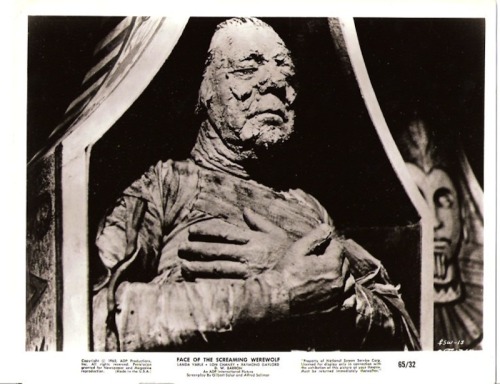
"La casa del Terror" was the only werewolf film out of 24 Horror releases in 1960..While in that year 7 motion pictures about vampires were seen including "La maschera del demonio (Mask of the Demon aka: Black Sunday" from Italy and director Mario Bava. "Et mourir de plasir (And die of pleasure aka: Blood and Roses) was from France and director Roger Vadim. While the U.K.'s Hammer Films brought us the "Brides of Dracula" with Peter Cushing, no Christopher Lee and no "Dracula". Italy had two more entries in 1960. L'ultimia preda dei vampiro (The Vampire's Last Victim aka; The Playgirls and the Vampire) and "Seddok, l'erede di Satana (Seddok, the Heir of Statan aka: Atom Age Vampire).
While the United States in 1960 gave ciewers two motion pictures from Roger Corman. The "House of Usher", starring Vincent Price, became the first of director Roger Corman's Edgar Allan Poe series and a still unknown Jack Nicholson had a small, but remembered role, in the original "The Little Shop of Horrors".
In 1961 the amount of werewolf movies increased to two. One was excellent from the House of Hammer and the other from Italy, forgotten, but kinda fun.
THE CURSE OF THE WEREWOLF (MAY 1, 1961)
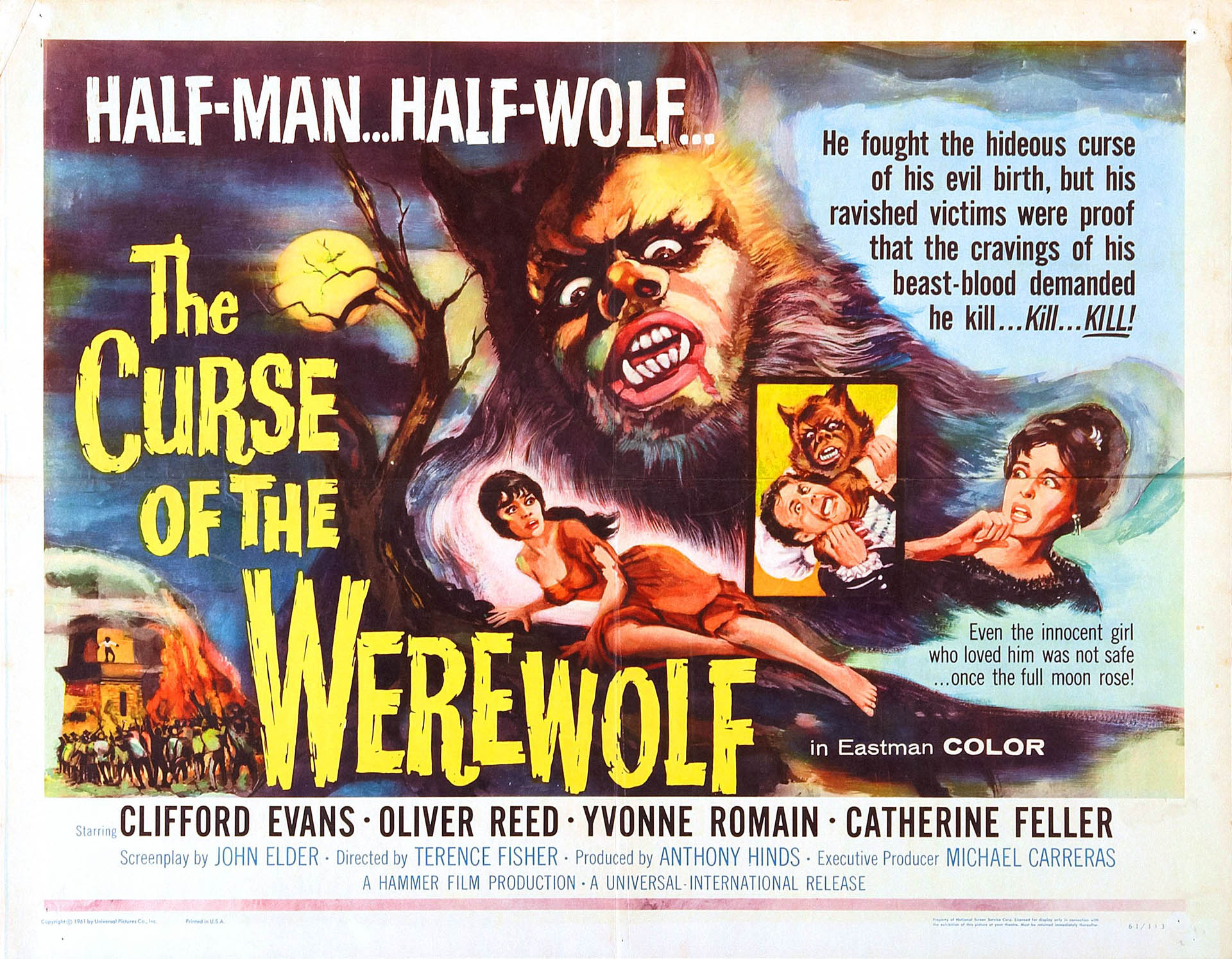
British Hammer Films had been bringing back the "Classic" Universal Monsters with their own twist and a lot of technicolor blood, but no actual gore on the screen. Peter Cushing and Christopher Lee had co-starred in 1957's "The Curse of Frankenstein", 1958's "Dracula" and 1959's "The Mummy". The team was broken up for 1960's "The Brides of Dracula" with Cushing and in the same years "The Two Faces of Dr. Jekyll (House of Fright)"with Lee in a minor role.
Now the House of Hammer turned to the werewolf and neither actor was in the motion picture. "The Curse of the Werewolf" would star Oliver Reed. Reed was seen in Hammer's "The Two Faces of Dr. Jekyll" as a bully in a pub. He was appearing in bite roles in other features and on British television. This motion picture brought him to the forefront. He would immediately follow "The Curse of the Werewolf" with 1962' "The Pirates of Blood River" with Kerwin Mathews and Christopher Lee and "Night Creatures" with Peter Cushing as "Dr. Syn". In 1968 Oliver Reed had the role of "Bill Sikes" in the movie musical "Oliver" and would portray "Athos" in both Richard Lester's 1973 "The Three Musketeers" and its sequel 1974's "The Four Musketeers" with Richard Chamberlain, Michael York, Frank Finlay, Raquel Welch and Faye Dunaway.
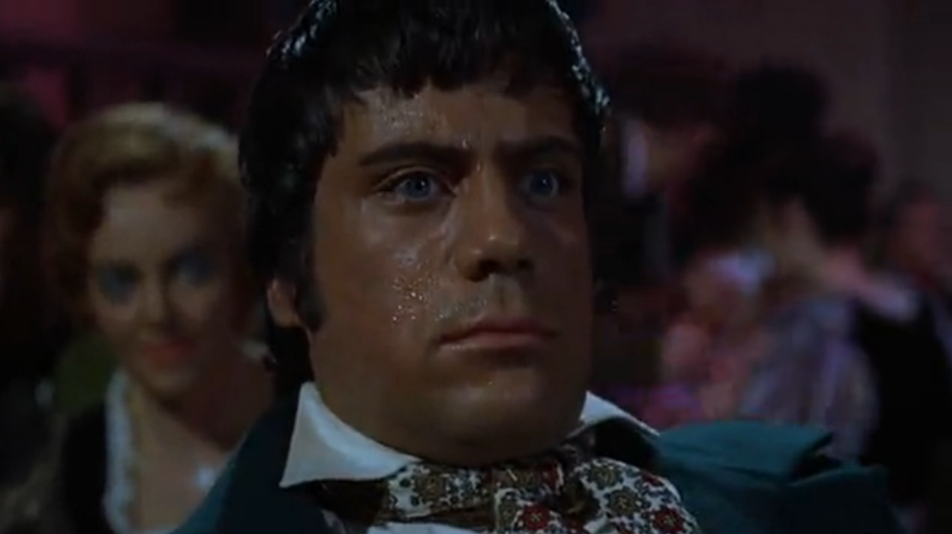


I come to a story of screen writing, Hollywood Black Listing and Communism. Guy Endore was a screenplay writer and in Horror films he is known for three 1935 pictures. They are Todd Browning's "Mark of the Vampire", the Peter Lorre film "Mad Love" and the Karloff and Lugosi feature "The Raven". Two years before these movies Guy Endore wrote the novel "The Werewolf of Paris", It is to werewolf lore as Bram Stoker's "Dracula" is to vampires. The novel has been considered lost until very recently when it was republished and turned into an E-Book.

Hammer Films acquired the rights to the novel and contracted with Guy Endore to write the screenplay. However, Endore was on the Hollywood Black List and had left the United States for England. Producer Anthony Hinds removed Endore's name from the writing credit for "The Curse of the Werewolf" and gave it to John Elder. Elder was actually Hinds and he used it 19 other times with films having been written by others.
The setting of the film was for some reason moved from France to Spain. My very interesting article on Guy Endore and how the "House Committee on Un-American Activities" destroyed many careers may be read at:
http://www.bewaretheblog.com/2015/12/guy-endore-communism-in-motion-picture.html
The story starts with an 18th Century beggar being brought before a very evil marquis on his wedding day. The beggar is made a fool of and then accidentally makes an inappropriate remark. He is tossed into a dungeon and literally forgotten except by the different jailers who feed him. He's fed on raw meat.

In comes to pass that a mute girl and daughter of the current jailer comes to the attention of the now very old marquis. He makes sexual advances at her, but she refuses. In retaliation the marquis has the girl thrown into the same dungeon cell with the forgotten beggar who rapes her. The following day the beggar is found dead and the girl is tossed out into the country to find her way.

The jailers daughter was portrayed by Yvonne Roman. Roman was in several great Horror/Thriller films starting with 1958's "Corridors of Blood" starring Boris Karloff and Christopher Lee. 1960's "Circus of Horrors" starring Anton Diffring, 1962's "Night Creatures" and 1964' s "Devil Doll" with Bryant Halliday.
The now pregnant young women comes to the home of "Don Alfredo Corledo" portrayed by Clifford Evans. He co-starred in the excellent 1940 British Mystery "House of the Arrow". Evans would follow this picture with Hammer's 1963 "Kiss of the Vampire" and the 1964 epic "The Long Ships" starring Richard Widmark, Sidney Poitier and Russ Tamblyn.

The girl gives birth on Christmas Day, an evil sign to the superstitious maid "Teresa", played by Hira Talfrey,, and dies at the same time. The boy is named "Leon" and as he grows he develops a taste for blood. When a small wolf is shot by a sheep herder. It is discovered that the boy has the bullet in him and the sheep herder makes a silver bullet.

The story skips forward 13 years and "Leon", Oliver Reed, leaves home to go to work at the "Gomez Vineyard". Where he falls in love with the owner's daughter "Christina" portrayed by Catherine Feller. This was her only feature film as Feller appeared mostly on BBC period series.
"Leon" is told by "Christina's" father that there is no way he will permit a marriage. Despondent he is taken by a co-worker to a brothel and transforms into the werewolf and kills the prostitute.

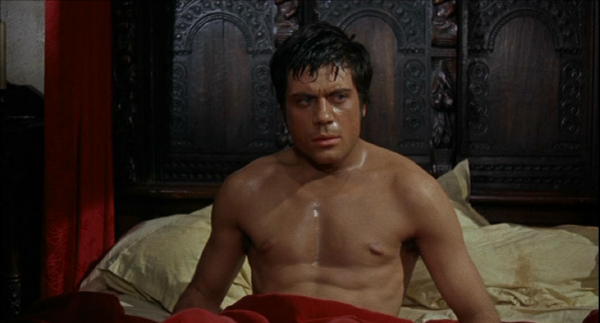
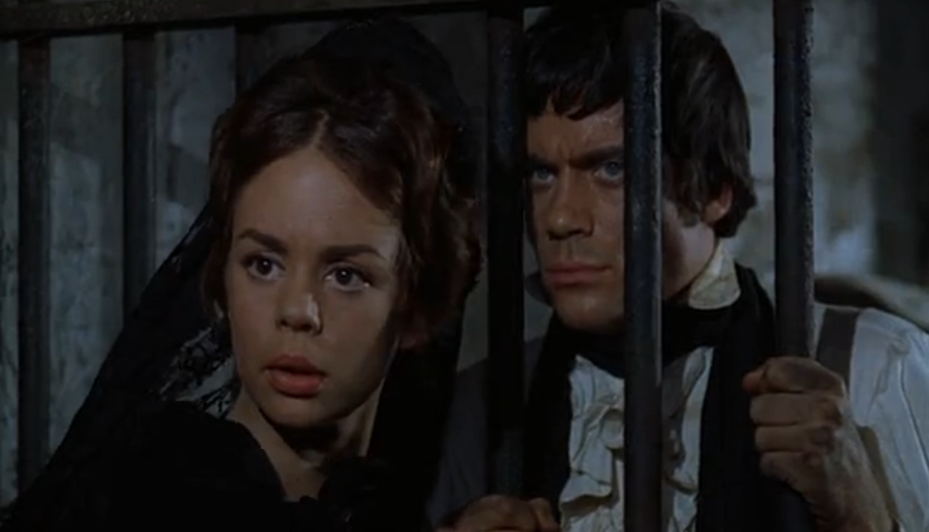
Events will follow that will lead to "Leon's" adopted father having to get the silver bullet and kill his son.


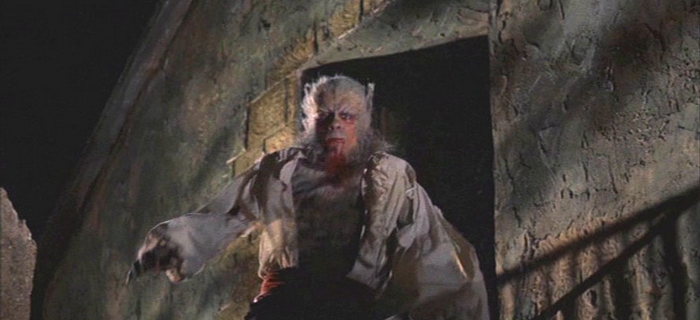

LYCANTHROPUS AKA: WEREWOLF IN A GIRL'S DORMITORY (NOVEMBER 9, 1961)
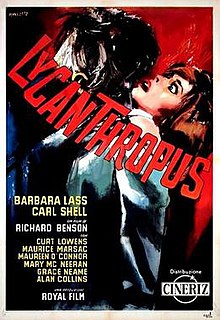

Note the added line on the English language dub's poster"
The motion picture was an Italian/ Austrian co-production.
In 1963 the motion picture was released in the U.K. under the somewhat provocative title of:
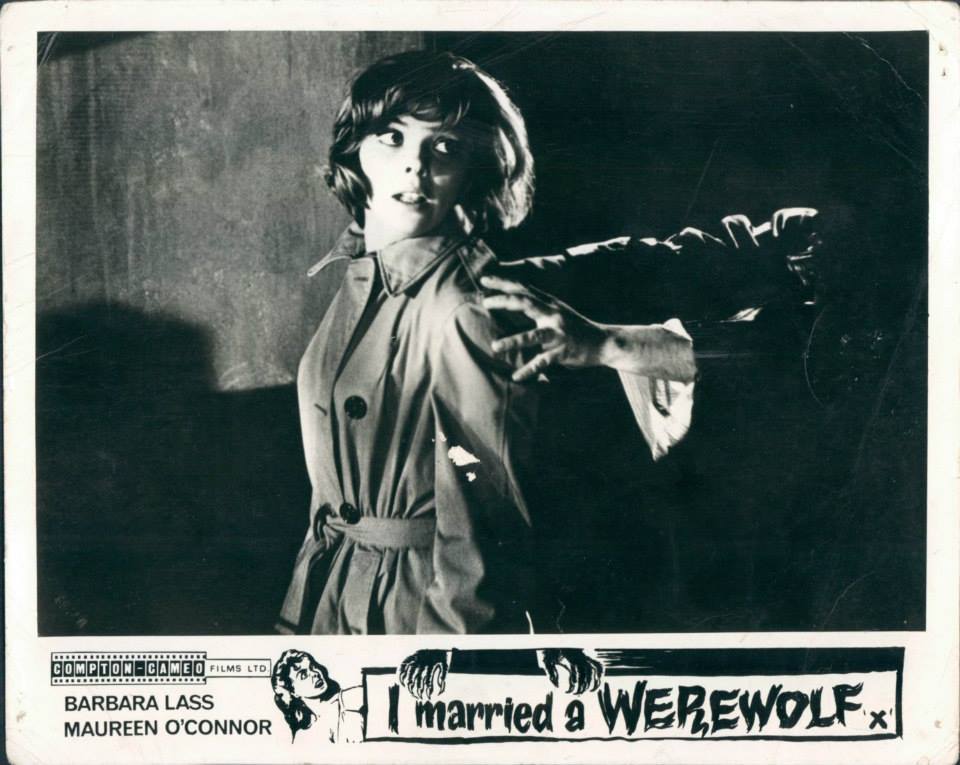
The basic story has a new male teacher arriving at an all girl's school and then werewolf attacks begin. Is it the teacher, or somebody else? The film is actually very well done and you really do not know who the werewolf is until the climax of the film. As almost everyone is presented as a possible suspect.
Another mystery is who was Maureen O'Connor seen below as "Leonore McDonald". Most reviews of the film have no information on her, but I do.
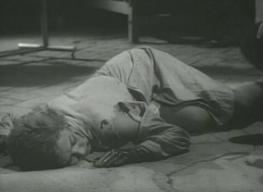
At the time, especially with Italian, Spanish and German Westerns. It was a practice of foreign actors to take on American sounding names to make the audience think the pictures came from the United States. The director of this picture Palo Heusch was made to use the name Richard Benson.
LA CASA DEL TORO AKA: HOUSE OF TERROR (MARCH 24, 1960)
Once again this movie was a comedy horror picture, but starring Mexican singer, comedian and actor "Tin Tin". Who was actually German Genaro Cipriano Gomez Valdes de Castillo. His career span 31 years from 1944 through 1975. The actor dubbed many Walt Disney animated features into Spanish. In this feature "Tin Tin" portrays "Casimiro" a night watchman at a wax museum of horrors.
The plot has the lazy "Casimiro" seeming more sleepy than usual, because his employer is actually a mad scientist. Who has been draining "Casimiro's" blood to use in his experiments. The film is unique for fans of Lon Chaney, Jr. as the 54 year old actor was cast as both "The Wolfman" and "The Mummy". At this time Lon was appearing in guest spots on television and had made the very interesting, Sweden based, television anthology "13 Demon Street" that he hosted.



"La casa del Terror" was the only werewolf film out of 24 Horror releases in 1960..While in that year 7 motion pictures about vampires were seen including "La maschera del demonio (Mask of the Demon aka: Black Sunday" from Italy and director Mario Bava. "Et mourir de plasir (And die of pleasure aka: Blood and Roses) was from France and director Roger Vadim. While the U.K.'s Hammer Films brought us the "Brides of Dracula" with Peter Cushing, no Christopher Lee and no "Dracula". Italy had two more entries in 1960. L'ultimia preda dei vampiro (The Vampire's Last Victim aka; The Playgirls and the Vampire) and "Seddok, l'erede di Satana (Seddok, the Heir of Statan aka: Atom Age Vampire).
While the United States in 1960 gave ciewers two motion pictures from Roger Corman. The "House of Usher", starring Vincent Price, became the first of director Roger Corman's Edgar Allan Poe series and a still unknown Jack Nicholson had a small, but remembered role, in the original "The Little Shop of Horrors".
In 1961 the amount of werewolf movies increased to two. One was excellent from the House of Hammer and the other from Italy, forgotten, but kinda fun.
THE CURSE OF THE WEREWOLF (MAY 1, 1961)

British Hammer Films had been bringing back the "Classic" Universal Monsters with their own twist and a lot of technicolor blood, but no actual gore on the screen. Peter Cushing and Christopher Lee had co-starred in 1957's "The Curse of Frankenstein", 1958's "Dracula" and 1959's "The Mummy". The team was broken up for 1960's "The Brides of Dracula" with Cushing and in the same years "The Two Faces of Dr. Jekyll (House of Fright)"with Lee in a minor role.
Now the House of Hammer turned to the werewolf and neither actor was in the motion picture. "The Curse of the Werewolf" would star Oliver Reed. Reed was seen in Hammer's "The Two Faces of Dr. Jekyll" as a bully in a pub. He was appearing in bite roles in other features and on British television. This motion picture brought him to the forefront. He would immediately follow "The Curse of the Werewolf" with 1962' "The Pirates of Blood River" with Kerwin Mathews and Christopher Lee and "Night Creatures" with Peter Cushing as "Dr. Syn". In 1968 Oliver Reed had the role of "Bill Sikes" in the movie musical "Oliver" and would portray "Athos" in both Richard Lester's 1973 "The Three Musketeers" and its sequel 1974's "The Four Musketeers" with Richard Chamberlain, Michael York, Frank Finlay, Raquel Welch and Faye Dunaway.



I come to a story of screen writing, Hollywood Black Listing and Communism. Guy Endore was a screenplay writer and in Horror films he is known for three 1935 pictures. They are Todd Browning's "Mark of the Vampire", the Peter Lorre film "Mad Love" and the Karloff and Lugosi feature "The Raven". Two years before these movies Guy Endore wrote the novel "The Werewolf of Paris", It is to werewolf lore as Bram Stoker's "Dracula" is to vampires. The novel has been considered lost until very recently when it was republished and turned into an E-Book.

Hammer Films acquired the rights to the novel and contracted with Guy Endore to write the screenplay. However, Endore was on the Hollywood Black List and had left the United States for England. Producer Anthony Hinds removed Endore's name from the writing credit for "The Curse of the Werewolf" and gave it to John Elder. Elder was actually Hinds and he used it 19 other times with films having been written by others.
The setting of the film was for some reason moved from France to Spain. My very interesting article on Guy Endore and how the "House Committee on Un-American Activities" destroyed many careers may be read at:
http://www.bewaretheblog.com/2015/12/guy-endore-communism-in-motion-picture.html
The story starts with an 18th Century beggar being brought before a very evil marquis on his wedding day. The beggar is made a fool of and then accidentally makes an inappropriate remark. He is tossed into a dungeon and literally forgotten except by the different jailers who feed him. He's fed on raw meat.

In comes to pass that a mute girl and daughter of the current jailer comes to the attention of the now very old marquis. He makes sexual advances at her, but she refuses. In retaliation the marquis has the girl thrown into the same dungeon cell with the forgotten beggar who rapes her. The following day the beggar is found dead and the girl is tossed out into the country to find her way.

The jailers daughter was portrayed by Yvonne Roman. Roman was in several great Horror/Thriller films starting with 1958's "Corridors of Blood" starring Boris Karloff and Christopher Lee. 1960's "Circus of Horrors" starring Anton Diffring, 1962's "Night Creatures" and 1964' s "Devil Doll" with Bryant Halliday.
The now pregnant young women comes to the home of "Don Alfredo Corledo" portrayed by Clifford Evans. He co-starred in the excellent 1940 British Mystery "House of the Arrow". Evans would follow this picture with Hammer's 1963 "Kiss of the Vampire" and the 1964 epic "The Long Ships" starring Richard Widmark, Sidney Poitier and Russ Tamblyn.

The girl gives birth on Christmas Day, an evil sign to the superstitious maid "Teresa", played by Hira Talfrey,, and dies at the same time. The boy is named "Leon" and as he grows he develops a taste for blood. When a small wolf is shot by a sheep herder. It is discovered that the boy has the bullet in him and the sheep herder makes a silver bullet.

The story skips forward 13 years and "Leon", Oliver Reed, leaves home to go to work at the "Gomez Vineyard". Where he falls in love with the owner's daughter "Christina" portrayed by Catherine Feller. This was her only feature film as Feller appeared mostly on BBC period series.
"Leon" is told by "Christina's" father that there is no way he will permit a marriage. Despondent he is taken by a co-worker to a brothel and transforms into the werewolf and kills the prostitute.



Events will follow that will lead to "Leon's" adopted father having to get the silver bullet and kill his son.




LYCANTHROPUS AKA: WEREWOLF IN A GIRL'S DORMITORY (NOVEMBER 9, 1961)


Note the added line on the English language dub's poster"
THE GHOUL IN SCHOOLThe English language trailer for the film had a rock song of that title being sung, but that song was never on any local radio programs.
The motion picture was an Italian/ Austrian co-production.
In 1963 the motion picture was released in the U.K. under the somewhat provocative title of:

The basic story has a new male teacher arriving at an all girl's school and then werewolf attacks begin. Is it the teacher, or somebody else? The film is actually very well done and you really do not know who the werewolf is until the climax of the film. As almost everyone is presented as a possible suspect.
Another mystery is who was Maureen O'Connor seen below as "Leonore McDonald". Most reviews of the film have no information on her, but I do.

At the time, especially with Italian, Spanish and German Westerns. It was a practice of foreign actors to take on American sounding names to make the audience think the pictures came from the United States. The director of this picture Palo Heusch was made to use the name Richard Benson.
Back to Maureen O'Connor, actually Italian actress Michela Roc who has a total of 7 movie credits to her name between 1960 and 1976. One of which was the non screen credited role of Elizabeth Taylor's servant in the 1963 "Cleopatra". "Maureen O'Connor" showed up on American television in 12 episodes of the series "Matt Houston" as the Millionaire Detective's Secretary in Season one 1982 to 1983. Mystery solved with a little investigation. There are two other interesting actors in this film also.
Portraying the school teacher "Julian Olcott" was actor Carl Schell. Schell was the younger brother of actors Maximilian Schell and Maria Schell. His cousin was Catherine Schell of Gerry Anderson's "Space 1999". She played the shape shifting alien "Maya".
Then there was the damsel in distress "Priscilla" portrayed by Barbara Lass. Lass was a Polish actress who from 1958 into 1962 was married to director Roman Polanski. In 1970 she co-starred with David McCullum in the made for American television motion picture "Hauser's Memory" written by Curt Siodmak.



It wouldn't be until 1964 that another werewolf movie was released and this picture really was a cheat of sorts.
THE FACE OF THE SCREAMING WEREWOLF (MARCH 3, 1964)
Portraying the school teacher "Julian Olcott" was actor Carl Schell. Schell was the younger brother of actors Maximilian Schell and Maria Schell. His cousin was Catherine Schell of Gerry Anderson's "Space 1999". She played the shape shifting alien "Maya".
Then there was the damsel in distress "Priscilla" portrayed by Barbara Lass. Lass was a Polish actress who from 1958 into 1962 was married to director Roman Polanski. In 1970 she co-starred with David McCullum in the made for American television motion picture "Hauser's Memory" written by Curt Siodmak.



It wouldn't be until 1964 that another werewolf movie was released and this picture really was a cheat of sorts.
THE FACE OF THE SCREAMING WEREWOLF (MARCH 3, 1964)
The second name on the above poster catches the potential audience LON CHANEY. What that audience didn't know was this new movie was actually two old Mexican productions re-edited with some additional footage into a story about, ready (?), a MUMMIFIED WEREWOLF brought back to life.
The film was a product of film producer, writer, editor, director, cinematographer and actor Jerry Warren. His work includes such titles as 1957's "The Incredible Petrified World", 1961`'s "Teenage Zombies" and my favorite title 1966's "The Wild World of Batwomen".
The two Mexican movies Warren used were 1957's "La Monia Azteca (The Aztec Mummy)" and the entirely unrelated 1960 "La Casa del Terror (House of Terror)". Most of the additional footage was from Jerry Warren's other 1964 horror film "Attack of the Mayan Mummy". Which also used footage from the original Mexican picture "La Momia Azteca". Are you still with me.
I'll let Rich Wannen on the webite IMDb describe this convoluted plot:
Experimenting in hypnotic regression to past lives, Dr. Edmund Redding of the Cowan Institute in Pasadena has discovered that Ann Taylor is a reincarnated Aztec woman. Via her recovered memories, she is able to lead Redding and his associates to a hidden chamber in the Great Pyramid of Yucatan, where they hope to find the lost treasure of the Aztecs. Instead, they find two mummified bodies - one of a modern man, quite dead, and the other of an ancient Aztec, quite alive. They are able to return safely to Pasadena with both finds, but a rival professor, Janney, kills Redding and steals the body of the modern man-mummy. This he subjects to a resurrection experiment, which works - only the mummy proves to be a werewolf. This creature breaks free of Janney's lab. Meanwhile, a hired thief sent by Janney to steal the other, living mummy, is overcome and that creature escapes also. Two supernatural menaces roam the city that night...https://www.imdb.com/title/tt0058079/plotsummary?ref_=tt_ov_pl

How about a little name changing from Spanish to English? Designed to fool Warren's viewers in the dubbed scenes from the two original Mexican features. Ramon Gay now becomes Raymond Gaylord portraying "Dr Edmund Redding". Alfredo W. Barron is simply changed to Donald Barron portraying "Redding's Henchman". Yolanda Varela becomes Landa Varle as "The Girl carried off by the werewolf". While Rosita Arenas becomes the character "Ann Taylor". One has to wonder did Jerry Warren pay any of these actors including Lon Chaney, Jr. royalties, at least, for using their previous motion pictures and did any of them discover this turkey?
As to that new footage. One of the actors was a George Mitchell who had 6 feature films to his credit and they were all Warren's productions. He was also Warren's make-up department. Fred Hoffman had 5 Jerry Warren pictures for his film acting career and Chuck Niles had the most at 11.
In 1965 out of 31 Horror motion pictures released. Only one and one-fifth were about werewolves. Two were still about vampires, but one was the classic prototype for the look of Ridley Scott's "Alien", "Planet of the Vampires" by Mario Bava.
DR. TERROR'S HOUSE OF HORRORS (FEBRUARY 25, 1965)

Five strangers meet in a train car and are joined by a sixth "Dr. Schreck" and a deck of Tarot cards. As the above poster indicates "Dr. Schreck", at his low keyed best, was portrayed by Peter Cushing. Peter would follow this film with the first color version of H. Rider Haggard's novel "SHE". He portrayed "Holly" a role Nigel Bruce did in the 1936. That version was by Merian C. Cooper the man who brought the world "King Kong". "SHE" would be followed by the first of his two controversial portrayals of "The Doctor" in "Dr. Who and the Daleks".
The first of the five episodes is titled "Werewolf" and finds architect "Jim Dawson" portrayed by Neil McCallum returning to his old family home on the Scottish moors. Canadian-British actor McCallum is known more for not being seen, but providing voices in Gerry Anderson's "Thunderbirds Are Go!" and "Captain Scarlet and the Mysterons".

"Jim Dawson" has arrived to renovate the ancestral home for its new owner "Mrs. Biddulph" portrayed by Ursula Howells. A British character actress known for her elegant roles. While looking over the house in the lower levels. "Dawson" discovers the tomb of the house's original owner "Count Cosmo Valdemar". "Mrs. Biddulph" believes the local legend that "Count Valdemar" will roam the halls as a werewolf and take revenge on the current owner. Believing "Mrs. Biddulph", "Jim Dawson", makes silver bullets to protect her. However, what he doesn't know are three things.
The first is that the legend says "Count Cosmo Valdemar" will return to life after he takes revenge on the last member of the "Dawson" family. Who killed the evil Count and that was how the house actually went to "Jim's" ancestors. The other unknown is that "Jim Dawson" is the last member of his family and "Mrs. Biddulph" is actually the reincarnation of the Count's wife.
The other stories have as cast members Christopher Lee, Bernard Lee the original "M" in the "James Bond" movies, Jeremy Kemp, Michael Gough and Donald Sutherland.

LA LOBA AKA: THE SHE-WOLF (JULY 1, 1965)

This Mexican made feature film has a simple, but interesting plot. Actress Kitty de Hoyos portrays "Clarisa Fernandez" a young women cursed as a werewolf. She has been seeing a "Dr. Alejandro Bernstein" portrayed by Joaquin Cordero for help in breaking her curse.

The twist is that "Dr. Bernstein" is also a werewolf. The two fall in love and go on a killing spree. Her father "Professor Fernandez" portrayed by Jose Elias Moreno has been studying metamorphosis to attempt to also cure and understand what has happened to his daughter. However, in the end both werewolves lives are ended by a trained werewolf killing dog.
MUNSTER GO HOME (JUNE 15, 1966)
As this article is about every werewolf movie. I have to include the feature film based upon the popular television series "The Munsters". Seeing that "Herman", Fred Gwynne, and "Lily's", Yvonne DeCarlo, little boy "Eddie Munster", Butch Patrick, is supposed to be a werewolf. There was one change to the cast for the feature film. Instead of Pat Priest as "Marilyn", she already had replaced Beverly Own starting in episode 14 of the television show, we have Debbie Watson. Watson had played "Tammy" on the television series. She would make one "Tammy" movie 1967's "Tammy and the Millionaire". The character was first seen in 1958's "Tammy and the Bachelor" starring Debbie Reynolds and then a series of films in the early 1960's starring Sandra Dee.
Anyhow, "Herman", "Lily", "Grandpa", Al Lewis, "Eddie" and "Marilyn" inherit an old English Mansion. There they run afoul of "Cousin Freddie Munster" portrayed by Terry-Thomas and "Lady Effigie Munster", Hermione Gingold, in some funny bits including a drag race using the "DRAG-U-LA".



For those of my readers who remember both "The Munsters" and "The Addams Family". My article on both television programs can be read at:
http://www.bewaretheblog.com/2017/09/the-addams-family-and-munsters.html
How about a another variation of the werewolf motif?
THE BLOOD BEAST TERROR AKA: THE VAMPIRE-BEAST CRAVES BLOOD (JANUARY 1968)
It's 19th Century England and strange murders are occurring. "Inspector Quennell" portrayed by Peter Cushing starts to investigate. This will lead to "Dr. Carl Mallinger", portrayed by Robert Flemyng, an entomologist with a beautiful daughter. Flemyng started acting in 1937 and appeared in a variety of American and British television programs. In films he was in the 1957 musical "Funny Face" starring Audrey Hepburn and Fred Astaire, the 1962 Italian Horror film "The Horrible Dr. Hitchcock" co-starring British actress Barbara Steele, 1966's "The Quiller Memorandum" starring George Segal and Alec Guinness and 1969's "The Body Stealers" starring George Sanders and Maurice Evans.
Portraying "Dr, Mallinger's" daughter "Clare" was Wanda Ventham. The actress is known mainly for her role of "Colonel Virginia Lake" in Gerry Anderson's classic British Science Fiction television show "UFO". In this film she portrays, are you ready (?), a "Were-Moth". At night "Clare" turns into a human moth created by her father and drains the fluids out of her victims. Her Father is searching for the right male to be turned into her mate to keep the species alive.

VARGTIMMEN (THE WOLF'S HOUR) AKA: HOUR OF THE WOLF (FEBRUARY 19, 1968)

You have to have a taste for Swedish filmmaker Ingmar Bergman. I do and enjoyed such classics as 1957's "The Seventh Seal", the same years "Wild Strawberries" and 1966's "Personna". The first two films star the main actor of this film Max von Sydow. Who wouldn't be known to the average American film goer until he portrayed "Jesus" in George Stevens' monumental flop. 1965's "The Greatest Story Ever Told" with John Wayne as a Roman Centurian looking like he's wearing a dress at the cruxification. In the film I'm discussing Max von Sydow is a Painter named "Johan Borg".
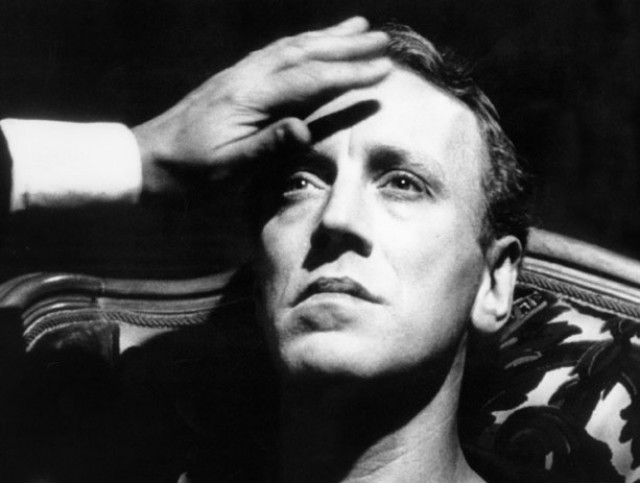
Starring in "Personna" was one of Bergman's two leading actresses Liv Ullmann. She would not become familiar to American audiences until the two part story by director Jan Troell was dubbed into English as 1971's "The Emigrants" and 1972's "The New Land". The story about 19th Century Swedish emigrants to Minnesota. Portraying her husband was Max von Sydow. In this motion picture Ullmann portrays "Alma Borg" the pregnant wife of "Johan".
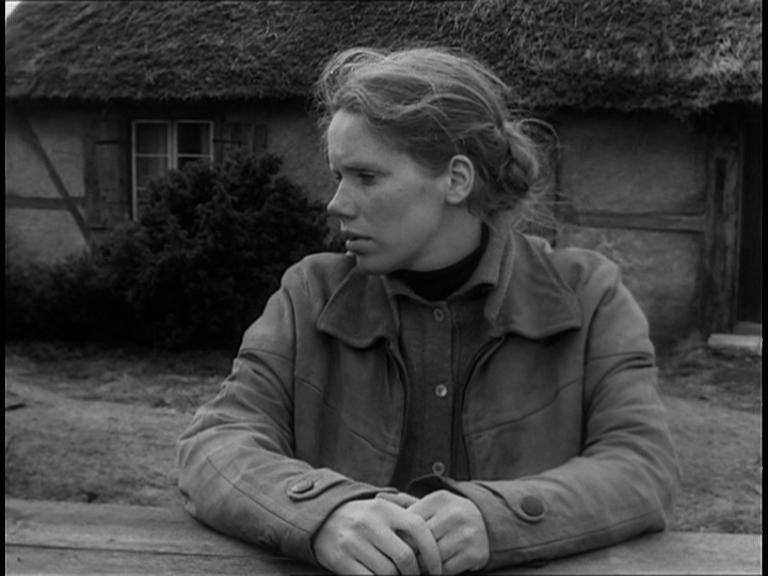
The third main character the former lover of "Johan", "Veronica Vogler" is portrayed by Swedish actress Ingrid Thulin. She had previously been in Ingmar Bergman's "Wild Strawberries", 1958's "The Magician" with Max von Sydow, the American 1962 film "The Four Horsemen of the Apocalypse" starring Glenn Ford, and the American 1965 motion picture "Return from the Ashes" starring Maximilian Schell and Samantha Eggar.
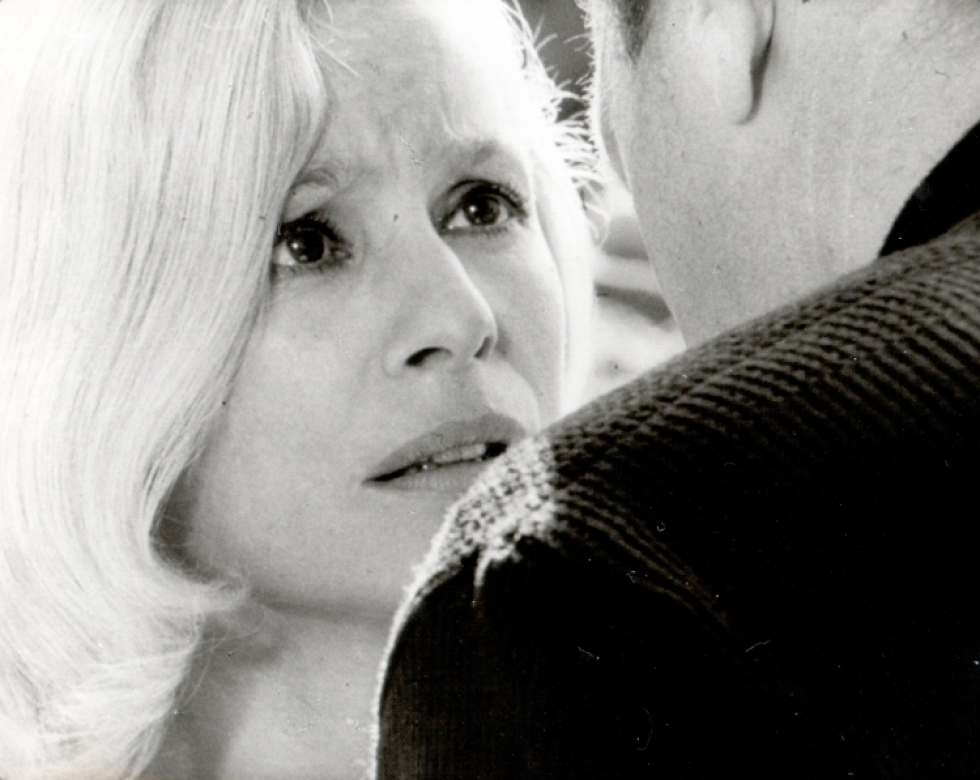
Is there a true werewolf in this film? No, but there are interesting demons and variations such as "The Bird-Man", "The Insects", "The Meat Eaters" and others. Are they real, or just imaginary creations of "Johan's" mind? Just as the story he tells "Alma" about being locked in a closet by his mother and told inside was a man who ate little boy's toes. Then finding a little boy one day and killing him. Truth, fiction, or ? No one can say Ingmar Bergman's films are straight narratives, or not at times very weird and strange.
Take "Persona" basically a two person film. About a Nurse assigned to care for a mentally ill women in her home. Over the course of the story, the nurse becomes a slave to the women's every whim. However, as the audience watches by the film's conclusion the mentally ill women becomes the nurse and the nurse the mentally ill women. They have switched their personas.


The website "Mountain Express" has a very good description of this feature's premise and its influence:
The 87 minute long film is broken into two parts and the second part starts with the superimposed title "Hour of the Wolf". Husband and wife are invited back to "Baron von Merkens", portrayed by Erland Josephson, castle for another dinner party, Earlier in the first part the audience finds out that the "Baron" has a painting made by "Johan" of "Veronica". In this part it is revealed that she is not only alive, but will be at the party.However, the person who arrived to invite them to the castle places a gun on their table telling them it is to protect the two from:
As the party will progress it is revealed that the demons of "Johan's" mind are real and the "Baron's" party guests. In the end "Alma" will witness the attack of the demons on her husband and as a reflection in a mirror he vanishes. She turns to the audience, breaks the fourth wall of the theater and says:
LA MARCA DEL HOMBRE LOBO AKA: THE MARK OF THE WEREWOLF (JULY 29, 1968)
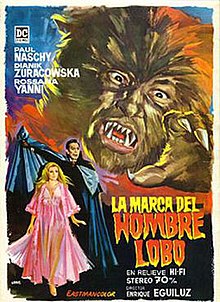
This is the first of 12 motion pictures made in Spain starring actor Paul Naschy, actually Jacinto Molina Alvarez, as "Count Waldemar Danisky". The picture was filmed in 3-D and as the poster shows had vampires also.
The basic story has the good Polish "Count Danisky" bitten by the revived werewolf "Imre Wolfstein". After a drunken gypsy accidentally brings "Wolfstein" back to life. What should sound familiar is the "Wolfstein" was bitten by a werewolf in Tibet. He returned to his home in Germany and began a killing spree. He was eventually stopped by having a silver dagger pierce his heart.
Below Paul Naschy as "Count Danisky".


"Count Waldemar Daninsky" seeks help from "Dr. Janos de Mikhelov" and his wife. Actually they are vampires. The films climax rather than helping "Danisky" has the vampires bring both werewolves together for a fight. "Daninsky" kills "Wolfstein" and then the two vampires. Only to be killed, himself, by "Janice":
EL NOCHES DEL LOBO HOMBRE AKA: NIGHTS OF THE WEREWOLF (1968)
According to Paul Naschy, he wrote the screenplay and filmed this motion picture for two weeks in Paris, France. It is listed as the second in his series about "Count Danisky". The problems here start with the fact there is no record of the picture, or a copy of the screenplay Naschy claimed to have written. Also there is no documented release of a 1968 film of this title anywhere including Spain. Adding to the mystery. The movie was supposedly filmed by director Rene Govar, but he died in a car accident before completing the feature. I leave my reader to decide on this considered "Lost Film".
LOS MONSTRUOS DEL TERROR AKA: DRACULA VS FRANKENSTEIN AKA: ASSIGNMENT TERROR (FEBRUARY 24, 1970)

.
This may not be the best final film for British Actor Michael Rennie, "Klaatu" in the classic 1951 Science Fiction "The Day the Earth Stood", "Peter" in the first CinemaScope motion picture 1953's "The Robe" and its sequel 1954's "Demetrius and the Gladiators" and as "Lord John Roxton" in Irwin Allen's 1960 "The Lost World". In this film he is one of two dead Earth Scientists brought back to life by evil Aliens. Who plan to bring monsters back to life to conqueror the Earth with her own fears.
.jpg)
Above "Dr. Odo Warnoff", Rennie, removes the silver bullets that killed "Count Walermar Daninsky", Paul Naschy, bringing the werewolf back to life.
The other reanimated Scientist is "Maleva Kerstein" portrayed by Karin Dor. Dor is to the left of the film's version of Universal Studio's "Frankenstein Monster".
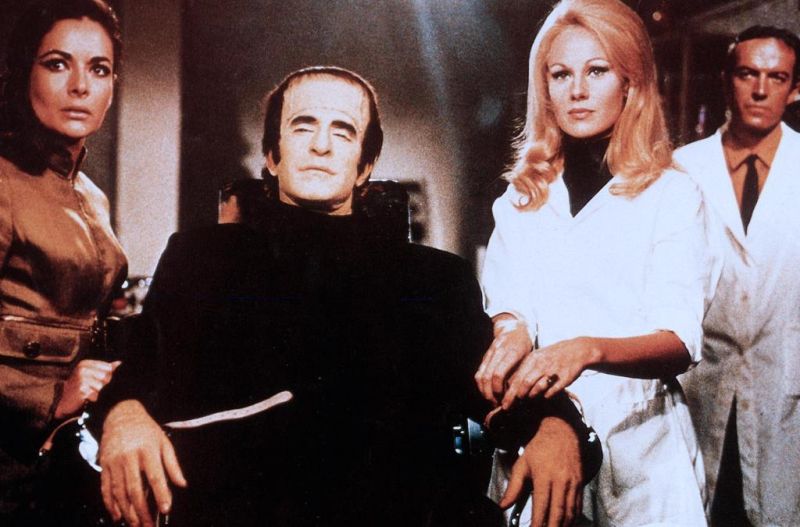
Dor is known for 1962's "The Invisible Dr. Mabuse", 1965's "The Face of Fu Manchu" starring Christopher Lee, 1967's "You Only Live Twice" starring Sean Connery as "James Bond" and Alfred Hitchcock's 1969 "Topaz".
The Frankenstein monster seems to have a sauve Italian look to him and was portrayed by Italian actor Ferinando Murolo, Although some sites claim it was Paul Naschy.
The actress on "Frankie's" right is South Carolina born Patty Shepard as "Ilsa". She moved to Spain at 18, became a model and appeared in many Spanish/Italian Westerns kicking butt. Then moved into Horror movies.
In this screenplay Naschy's werewolf goes up against the Frankenstein monster, a Mummy and the revived vampire from the first film. "Waldemar" destroys all three and is once again killed with silver bullets by the women who loves him enough to end his torment.
LA FURIA DEL HOMBRE LOBO AKA: THE FURY OF THE WEREWOLF (FILMED IN 1970 AND NOT RELEASED UNTIL 1972)
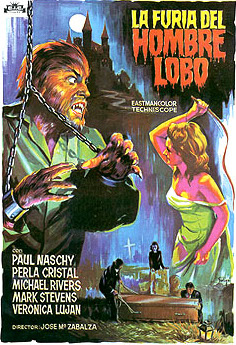
This motion picture was filmed in 1970, but not released until February 7, 1972, because a distributor could not be found. As a result it did have an impact on the next film in Paul Naschy's werewolf series. That problem is made more important as "Fury of the Werewolf" is actually a reboot of the story of "Waldemar Daninsky".
In this reboot "Daninsky" is no longer a Polish Count, but a College Professor. In this version he travels to Tibet to be bitten not by another werewolf named "Wolfstein", but a YETI. Please don't even ask.
"Professor Daninsky" is destroyed after killing his cheating wife and her lover. Then is revived by a women Scientist named "Dr Ilona Ellman". Who is really "Eva Wolfstein". She is played by Perla Cristal an Argentine actress.


"Eva Wolfstein" brings back "Waldemar's" dead wife as another werewolf.

Eventually husband and wife fight each other and "Waldemar" kills her a second time along with "Eva". Then we have the exact ending of all the previous films, but as in each a different women. When "Eva's" loves "Waldemar Daninsky" enough to end his torment. Also shooting him, once again, with a silver bullet.
LA NOCHE DE WALPURGIS AKA: WALPURGIS NIGHT AKA: THE WEREWOLF VS THE VAMPIRE WOMEN (MAY 17, 1971)
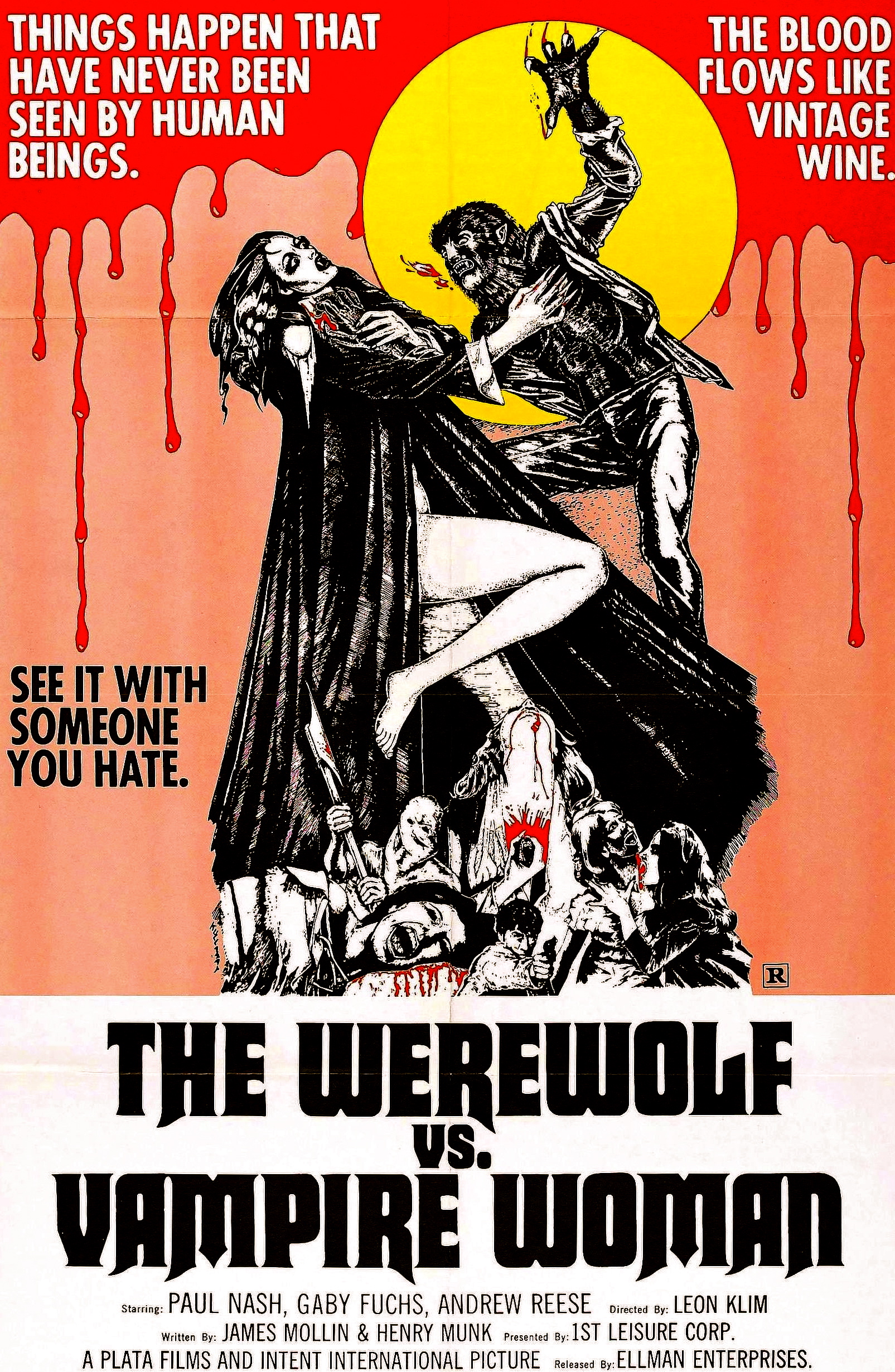
Two doctors at the morgue are examining the body of "Waldemar Daninsky". After it was brought there following the ending of "Fury of the Werewolf". Which as I mentioned wasn't released until nine months after this picture premiered.
This feature would be the most successful of all of Paul Naschy's werewolf films.
Returning to the two doctors. They remove the silver bullets from the body. "Daninsky" returns to life, turns into a werewolf, kills the doctors and leaves the morgue. Two students named "Elvira", Gaby Fuchs, and "Genevieve", Barbara Capell, go in search of the tomb of the medieval murderess "Countess Wandesa Darvula de Nadasdy". They are searching for the tomb in a graveyard near "Waldermar Daninsky's" castle. He is now once again a Polish "Count" and how that happened to a College Professor is never explained. "Waldemar" offers the girls help in locating the grave site.
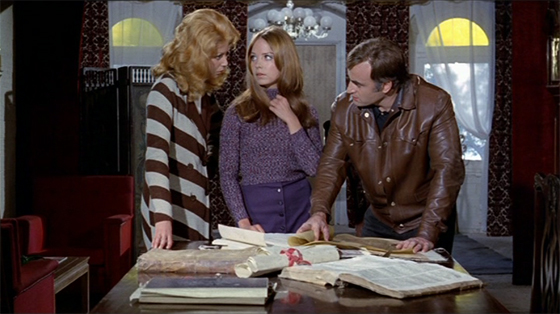
Above Gaby Fuchs, Barbara Capell and Paul Naschy. Other than this film I could find no information on either Fuchs, or Capell.
The tomb is discovered and "Elvira" cuts herself and bleeds on it reviving the "Countess". Who is portrayed by Patty Shepard.
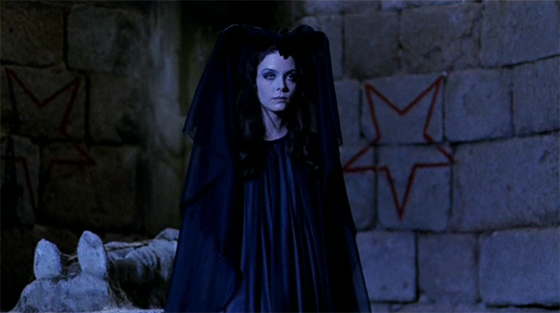
At the time this picture was released. American Patty Shepard became such a major Horror actress that it was believed she would replace British actress Barbara Steele. As the number one female European Horror star, but Steele remained at the top of her game.

The "Countess" changes both "Elvira" and "Genevieve" into vampires.
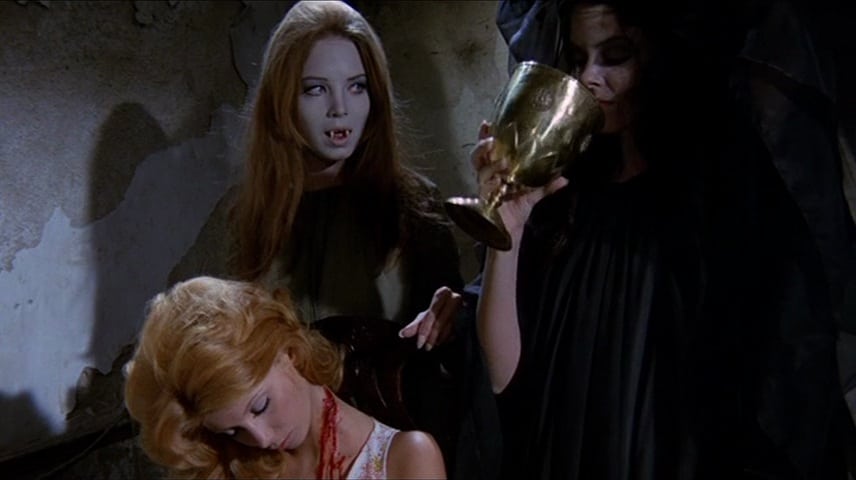
The three go out at night killing and it is up to "Waldemar" to destroy the "Countess" after turning back into a werewolf. He will be killed by "Elvira" a women who loves him enough to end his torment. Vampire "Elvira" is left at the film's conclusion and is never seen again in any of the remaining entries in Naschy's series..
Taking a break from the film's of Paul Naschy we come to an fun werewolf movie.
WEREWOLVES ON WHEELS (NOVEMBER 19, 1971)

The perfect blending of "Hell's Angels" and the "Lawrence Talbot/Count Daninsky" Fan Clubs.
A group of bikers are out in the desert and come across an old church that has become the base for a Satanic cult whose monks wear dark brown and black robes..

The leader of the bikers "Adam" is played by Stephen Oliver. He appeared between 1966 and 1968 on the television prime time soap "Peyton Place" and appeared on other television shows. Then he was in two biker films 1965's "Motopsycho" and 1968's "Angels from Hell". Later he would be seen in 1973's "Cycle Psycho".
The role of "Helen" was portrayed by actress Donna Anderson as D.J. Anderson. She had appeared as "Mary Holmes", the wife of Anthony Perkins, in 1959's Atomic War film "On the Beach" starring Gregory Peck and Ava Gardner. Donna was also "Rachel Brown" in the 1960 motion picture "Inherit the Wind" starring Spencer Tracy and Frederick March. Both features were directed and produced by Stanley Kramer.

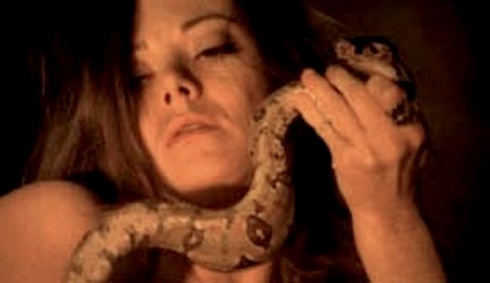
The cult attempts to convince "Helen" to be a sacrifice and the bikers destroy the church. What they do not know is "Helen" is under a spell cast upon her. She turns into a werewolf biting the other members of the group.
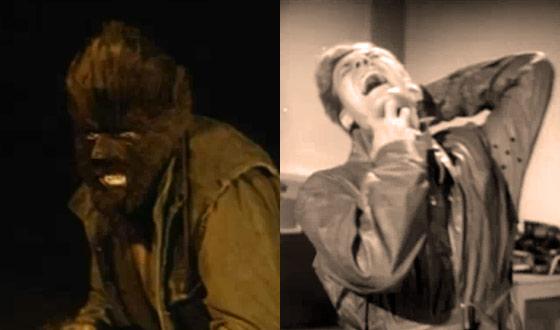


"Werewolves on Wheels" is a lot better than it sounds.
DR. JEKYLL Y EL HOMBRE LOBO AKA: DR. JEKYLL AND THE WOLFMAN AKA: DR. JEKYLL AND THE WEREWOLF (MAY 6, 1972)

Paul Naschy turned to Robert Lewis Stevenson for his sixth, or is that really his fifth (?), screenplay, like many others, under his own actual name of Jacinto Molina.
"Count Waldemar Daninsky" seeks out the grandson of "Dr. Jekyll" to cure him of being a werewolf. The son also named "Dr. Henry Jekyll" was portrayed by American actor Jack Taylor. Actually George Brown Randall. Taylor found work in both Mexican and European Horror and Thriller movies. Along with many Spaghetti Westerns.. In 1961 he portrayed "Igor" using the stage name of "Grek Martin" in "La maldicion de Nostradamus". "Igor" is the assistant to Germain Robles' vampire. In 1962 he was back in the role in "Nostradamus y el destructor de monstrous". Taylor starred in the Western "Fall of the Mohicans" in 1965, besides this Paul Naschy feature. He was also in one of the actors non-werewolf features "La venganza de la momia" aka: "The Mummy's Revenge" in 1975.

Above Jack Taylor and Mirta Miller as his assistant "Sandra". Miller was an Argentine actress who appeared in 65 pictures,

Instead of completely curing the "Count". "Dr. Jekyll" turns him into a more horrific creature "Mr. Hyde:.


The movie has what is considered a classic sequence. In it "Count Waldemar" is in an elevator with a young women who watches in horror as he transforms into a werewolf. The "Mr. Hyde" character roaming the streets of London enters a disco and transforms into a werewolf in one other sequence.
Portraying "Justine" the women that loves "Waldemar" just enough to end his torment was Shirley Corrigan.

MOON OF THE WOLF (SEPTEMBER 26, 1972)
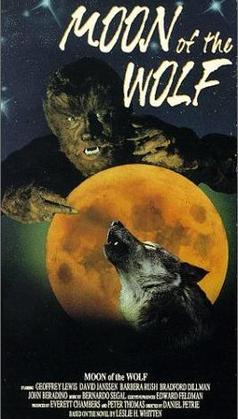
This was actually a made for television's "ABC Movie of the Week". The picture was based upon a novel by Leslie H. Whitten of the same title and the book's cover artist had a more interesting werewolf than this picture.
As with most made for television movies it wasted a solid cast that included David Janssen as "Sheriff Aaron Whitaker", Barbara Rush as "Louise Rodanthe", Bradford Dillman as "Andrew Rodanthe" and character actors Geoffrey Lewis as "Lawrence" and the under appreciated, in my opinion, John David Chandler as "Tom, Jr" and Royal Dano as "Tom, Sr.",

Above David Janssen on the right and below Barbara Rush.


Above Bradford Dillman and below Geoffrey Lewis,

Below John David Chandler and Royal Dano.

Murders in a small Louisiana Bayou community seem to point to a vicious dog. However, the Sheriff is told by a dying girl's father that it was no dog, but a "Loug Garog" that attacked his daughter. "Sheriff Whitaker" can't figure out what the man was talking about, or find any reference to a "Loug Garog".
"Sheriff Whitaker's" investigation takes him to the plantation house of the wealthy, but last members of an old dynasty "Louise" and "Andrew Rodanthe". "Andrew" claims to have had a malaria attack the night of the girl's attack. Meanwhile, suspicion falls on the girl's brother "Lawrence". Who attacks the town doctor, because he was his sister's secret lover and "Lawrence" thought he killed her.
"Lawrence" is arrested, but when "Whitaker" returns to the jail. He finds the bars of the cell ripped out and both "Lawrence: and his Deputy murdered by an animal. "Louise" speaks French and realizes that that "Loug Garog" is actually the French "Loup-Garou" which translates as "werewolf".
Who the werewolf is, as in "The Undying Monster", is pretty predictable and turns out to be "Andrew".


THE BOY WHO CRIED WEREWOLF (AUGUST 1, 1973)
.jpg)
This is a fun variation on the fable of the "Boy Who Cried Wolf" directed by the great Nathan Juran. Juran directed such classics as Ray Harryhausen's 1958 "The 7th Voyage of Sinbad" and 1964 "First Men in the Moon". Along with great 1950's low budget Science Fiction like "The Deadly Mantis" and "The Attack of the 50 Foot Women"/ Nathan Juran's life and film work may be found on my blog at:
http://www.bewaretheblog.com/2017/05/nathan-h-juran-look-at-work-of-man-who.html
A boy "Richie Bridgestone", Scott Sealey, goes to the family mountain cabin with his divorced father.
His father "Robert Bridgestone" is portrayed by Kerwin Mathews. Mathews was "Sinbad" in "The 7th Voyage of Sinbad" and also appeared in 1960's "The 3 Worlds of Gulliver" and 1962's "Jack the Giant Killer". In this picture he is attacks and kills a werewolf and becomes one himself.
No one and especially "Richie's" divorced mother "Sandy Bridgestone", portrayed by Elaine Devry, believes her son about the werewolf, or as the story progresses that his father is one also. Elaine Devry was in the Mickey Rooney 1954 comedy "The Atomic Kid", but was billed as Elaine Davis. She was also, among other roles, in 1963's "Diary of a Madman" starring Vincent Price.
There will be murders, but one thing I really like about this very good motion picture. Is the look of Kerwin Mathews as the werewolf compared to all the previous films I have mentioned.



There will be a group of hippies who witness the werewolf become "Robert" again. "Sandy" will realize that "Richie" has been telling the truth. There is a double ending as the werewolf is being pursued by a mob and looses its balance falling on a wooden stake with a silver cross on it piercing his heart. The werewolf turns back into "Robert", but then "Sandy" notices that "Richie" was bitten.
EL RETORNO DE WALPURGIS AKA: RETURN OF THE WALPURGIA AKA: CURSE OF THE DEVIL AKA: THE BLACK HARVEST OF COUNTESS DRACULA (SEPTEMBER 26, 1973)


"Count Waldemar Daninsky" is back again. This is now the second reboot of Paul Naschy's original werewolf movie. "Daninsky" kills a wolf on his Castle grounds and it turns into a gypsy. A gypsy witch angered by the killing of one of her band. Orders a beautiful young girl to seduce the "Count". As he is sleeping in bed with her. The girl takes the skull of a wolf she has smuggled into the castle and presses its fangs into "Waldemar's" neck and he becomes a werewolf.
Naschy's screenplay goes even farther by bringing up an ancient curse of the "Daninsky" family by a medieval sorceress the legendary "Countess Bathory" portrayed by Maria Silva. Who his ancestor put to death. The "Countess" will be brought to life to fight the werewolf at the film's climax.


Below Maria SIlva as "Countess Bathory".


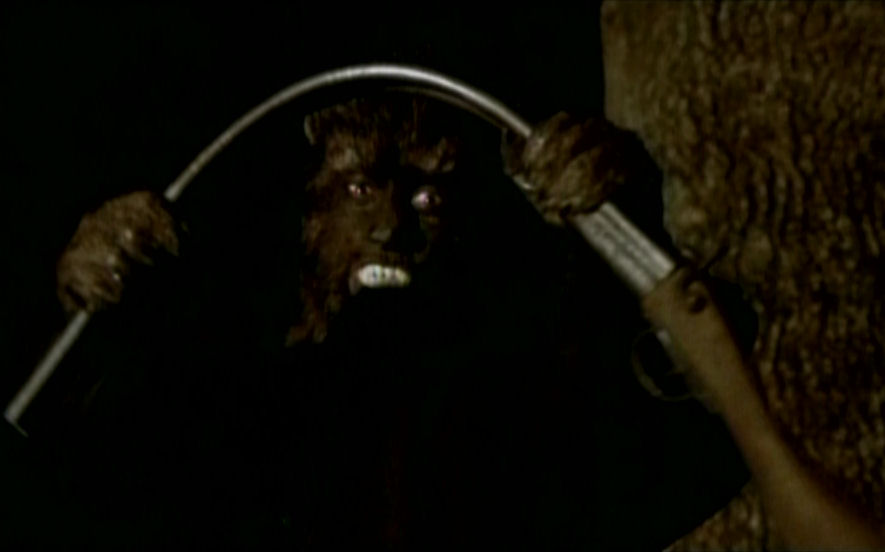
If my reader is tired of violent werewolf movies. How about one satirizing Richard Nixon's Administration?
THE WEREWOLF OF WASHINGTON (OCTOBER 1973).jpg)
The timing of the film was right in the mists of the Watergate Scandal.
Dean Stockwell portrays "Jack Whittier" who is on assignment for the President in Hungary. The entire
opening is lifted completely from Universal Studios 1941 "The Wolfman". We have "Jack" fend off a wolf with a silver wolf headed cane. He kills the wolf, but is bitten and discovers not the wolf, but a man who is the son of a women fortune teller. She gives him a pendant to wear to avoid turning into a werewolf. Then explains that he will see the sign of the PENTAGRAM on his victims hands. "Jack" wants to know what the PENTAGON has to do with him killing a wolf? Which will become a running gag. "Jack" doesn't believe the gypsy women's tale and thinks it's all a Communist plot against the United States and designed to make the President look bad.
At this time Stockwell was mainly appearing on television shows in guest spots. In 1959 he and Bradford Dillman had appeared in the movie "Compulsion" The fictional story based upon the real "Leopold and Loeb" murder case. In 1984 Stockwell portrayed "Doctor Wellington Yueh" in David Lynch's version of "Dune" and of course in 1989 he co-starred with Scott Bakula in the television show "Quantum Leap".
"Jack" is also the President's daughter, "Marion's", Jane House's, boyfriend. House is known for the 1973 Robert Mitchum crime drama "The Friends of Eddie Coyle"

Back in the United States, while attending a Presidential party, "Jack" flushes the pendant down the toilet. He's asked to meet with the President portrayed by Biff McGuire. McGuire was mainly a musical stage actor. He won Tony's for rivals of both "Finian's Rainbow" and "Camelot". In this film at times it is obvious he is Richard Nixon.

It is the night of a full moon and talking with a women at the party. "Jack" discovers he can see a Pentagram on her hand. She will die after he first becomes a werewolf.
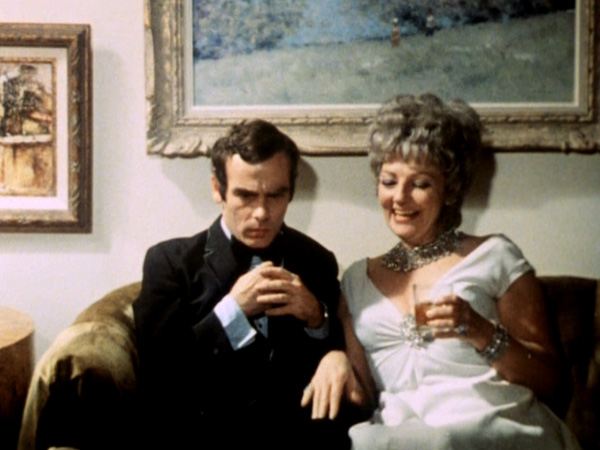
There will be another killing while "Jack" becomes the President's speech writer and assigned as the Vice Presidents writer as well. One scene was shot with the Watergate behind Sean Stockwell at night.
You have to know President Nixon and the times to pick up on a lot of the subtle satire of the picture. However, a meeting of the Joint Chiefs over pulling out of South East Asia is over the top. As one Army General gets tongue tied trying to decide what to call the last bombing mission and how large it should be.



The look of "Jack" as the werewolf running around Washington, D.C. in a suit and tie also adds to the satire of the story. Another great bit has the werewolf act as a dog to Michael Dunn's "Dr. Kiss" and Stockwell is just plain hilarious.
Near the end of the picture. "Jack" will change from human to werewolf while on Marine One as the President is speaking to the Chinese Leader. He attacks the President as the helicopter starts to land. After the werewolf runs away. Everyone is happy that the President only had a small bite on the neck.
After the werewolf is killed by "Marion". Who fires "Jack's" own gun containing one silver bullet. She is in hysterics over discovering she just killed him. It is agreed the gun will be buried and the press will be informed that the President's Press Secretary took a bullet from a sniper protecting the President's daughter.
Over the ending credits writer and directer Milton Moses Ginsberg has Bill McGuire's Nixon like President speaking to the American people in a perfectly sounding Nixsonian speech. Explaining how as he roams the lonely Halls of the White House at night. He thinks of how his administration protected the country and avoided a major killing spree, but the President starts to fight off howling at the moon during the speech.
LA MALDICION DE LA BESTIA AKA: THE CURSE OF THE BEAST AKA: NIGHT OF THE HOWLING BEAST AKA: THE WEREWOLF VS THE YETI (JANUARY 9, 1975)

This is another reboot by Paul Naschy. In this picture "Waldemar Daninsky" travels to Tibet to prove the Yeti exists.

He finds the Yeti, but also two vampire women living in the same cave.

It will be the vampire women who bite "Waldemar" turning him into a werewolf, never saw that one before, to fight the Yeti in the climatic sequence were he also destroys the two vampires. Below the girls are having a lunch break on the set.

THE WEREWOLF OF WOODSTOCK (JANUARY 24, 1975)

This is another made for television motion picture, but from Dick Clark's production company that was also shown on ABC. It was filmed directly on to video tape.
One night shortly after Woodstock has ended. A drunken local farmer named "Bert". Goes to one of the huge rubbish heaps still being cleaned up. Even while Woodstock was in progress he hated the noise and especially what the crowds were doing to his farm. While looking at all the trash yet to be cleared off the property. "Bert", portrayed by Tige Andrews, goes over to one of the stages still being dismantled. Suddenly, from one of the still active power lines, he is hit by a massive jolt of electricity. Apparently "Bert's" chromosomes get affected and he becomes the title character. Andrews is probably best known for being the Detective that formed television's original "The Mod Squad".


Two Police Officer's, "Moody", Michael Parks, and "Kendy", Meredith MacRae, chase down the werewolf to a power plant. Where he is killed by a silver bullet in one of the officer's guns.
LEGEND OF THE WEREWOLF (APRIL 1975)

This picture was released in the U.K., but went straight to VHS video in the United States. The screenplay is credited to Anthony Hinds, once again, and it is a remake of "The Curse of the Werewolf" without credit to Guy Endore. However, unlike the previous motion picture the setting is Paris, France as in Endore's "Werewolf of Paris".
The story starts on Christmas Eve as two immigrants are fleeing persecution. On a roadside the women delivers her baby boy and dies. While the man is killed by wolves that adopt the boy and raise him. Next a traveling circus finds the "Wolf Boy" and gives him the name "Etolie". The grown "Etolie" was portrayed by David Rintouil a Scottish stage and motion picture actor. He is known in the U.K. mainly for his stage roles.
At one point "Etolie" kills somebody after turning into a werewolf and runs away. He is next found by a kindly "Zookeeper" portrayed by Ron Moody. Moody is best known for his portrayal of "Fagin" in the filmed version of the musical "Oliver".
Later a group of Paris Prostitutes are having lunch together and "Etolie" falls for one of them named "Christine" portrayed by Lynn Dalby. She keeps her profession hidden from the young man. Killings will continue and this brings to Paris Peter Cushing as "Professor Paul". "Paul" is a skilled forensic surgeon who will create the theory of a werewolf.
The ending of the picture will have "Christine" discover "Etolie"is the werewolf, "Professor Paul" attempting to save the boy and another man using a silver bullet to end the young man's tragic life.
Of note is that the look of David Rintouil's werewolf is almost an exact double of Oliver Reed from the previous film.



LA LUPA MANNARA AKA: WOLFHOUND AKA: THE LEGEND OF THE WOLFWOMEN AKA: WEREWOLF WOMEN (MARCH 18, 1976)

Where the idea that this was a "True Story" came from I have no idea. There is nothing I could locate that supports the above second posters tag line for this Italian motion picture.
French actress Annik Borei portrayed the title character "Daniella Nesen". Borei was known for playing in films that Italian film critic Roberto Cuti described in 2017 as:

DEATHMOON (MAY 31, 1978)
Another made for television werewolf movie. A young executive, "Jason Palmer", Robert Foxsworth, is under a lot of stress and his doctor suggests he take a vacation by his doctor. "Jason" decides to go to Hawaii were his grandfather was a missionary. Big mistake as he does not know that his grandfather and all his male descendants are under a Voodoo curse and becomes a werewolf slaying beautiful young women.
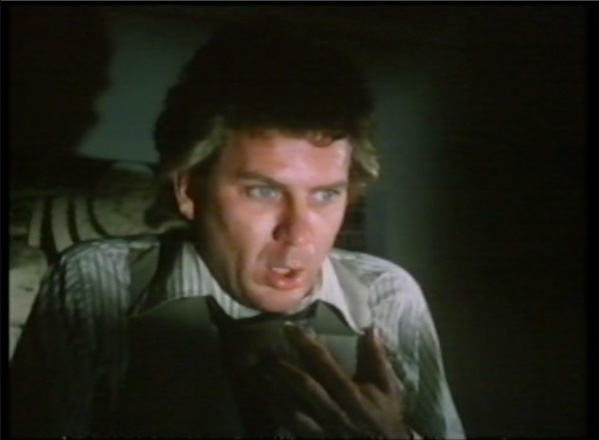

The last year I am speaking too had only one werewolf motion picture. 1980 was the year of John Carpenter's original "The Fog", Sean S. Cunningham's original "Friday the 13th", Paul Lynch's "Prom Night", a little Stephen King from Stanley Kubrick entitled "The Shinning" and Bette Davis in an overlooked "The Watcher in the Woods".
As for that one werewolf feature it would be Paul Naschy's 9th, or again maybe only his 8th..
EL RETORNO DEL HOMBRE LOBO AKA: THE RETURN OF THE WOLFMAN AKA: NIGHT OF THE WEREWOLF AKA: THE CRAVING (APRIL 10, 1981)


Naschy considered this a remake of his 1970 film "Walpurgis Night".
"Waldermar Daninsky" is sentence to death along with "Elizabeth Bathory" and several witches. As you can not kill a werewolf a silver dagger is placed in his heart and an iron mask around his face. Centuries later "Bathory" is brought back to life causing major problems. To stop the witch the dagger is removed from "Daninsky" so that he can fight and destroy her. By now an for the films that would follow. Paul Naschy had become very repetitious, but his fan base old and new loved his films in Europe.

As I mentioned at the beginning of this article. 1981 would see a change on how werewolves were shown in feature films. Beginning with Joe Dante's classic "The Howling" the tame and old fashion, like "The Wolfman", traditional looking werewolf make-ups and their transformations ended.


You have to have a taste for Swedish filmmaker Ingmar Bergman. I do and enjoyed such classics as 1957's "The Seventh Seal", the same years "Wild Strawberries" and 1966's "Personna". The first two films star the main actor of this film Max von Sydow. Who wouldn't be known to the average American film goer until he portrayed "Jesus" in George Stevens' monumental flop. 1965's "The Greatest Story Ever Told" with John Wayne as a Roman Centurian looking like he's wearing a dress at the cruxification. In the film I'm discussing Max von Sydow is a Painter named "Johan Borg".

Starring in "Personna" was one of Bergman's two leading actresses Liv Ullmann. She would not become familiar to American audiences until the two part story by director Jan Troell was dubbed into English as 1971's "The Emigrants" and 1972's "The New Land". The story about 19th Century Swedish emigrants to Minnesota. Portraying her husband was Max von Sydow. In this motion picture Ullmann portrays "Alma Borg" the pregnant wife of "Johan".

The third main character the former lover of "Johan", "Veronica Vogler" is portrayed by Swedish actress Ingrid Thulin. She had previously been in Ingmar Bergman's "Wild Strawberries", 1958's "The Magician" with Max von Sydow, the American 1962 film "The Four Horsemen of the Apocalypse" starring Glenn Ford, and the American 1965 motion picture "Return from the Ashes" starring Maximilian Schell and Samantha Eggar.

Is there a true werewolf in this film? No, but there are interesting demons and variations such as "The Bird-Man", "The Insects", "The Meat Eaters" and others. Are they real, or just imaginary creations of "Johan's" mind? Just as the story he tells "Alma" about being locked in a closet by his mother and told inside was a man who ate little boy's toes. Then finding a little boy one day and killing him. Truth, fiction, or ? No one can say Ingmar Bergman's films are straight narratives, or not at times very weird and strange.
Take "Persona" basically a two person film. About a Nurse assigned to care for a mentally ill women in her home. Over the course of the story, the nurse becomes a slave to the women's every whim. However, as the audience watches by the film's conclusion the mentally ill women becomes the nurse and the nurse the mentally ill women. They have switched their personas.


The website "Mountain Express" has a very good description of this feature's premise and its influence:
Ingmar Bergman’s Hour of the Wolf (1968) is often referred to as the director’s only horror picture. Actually, that seems a bit wide of the mark to me. It would not be inapt to call The Seventh Seal (1957) and The Magician (1958) horror films, while The Devil’s Eye (1960) is a playful one. The Virgin Spring (1959) might qualify, too — and not just because it was the inspiration for Wes Craven’s 1972 shocker The Last House on the Left. (Whether or not Bergman appreciated this is, so far as I know, unknown.) For that matter there are nightmarish qualities in Wild Strawberries (1958) and Persona (1966). While Hour of the Wolf is perhaps the closest Bergman ever came to a straightforward horror movie, the genre has always hovered around his work. Hour of the Wolf basically tells the story of an artist’s (Max von Sydow) descent into madness while stuck on an island with only his wife (Liv Ullman) and a group of degenerate — or at least very decadent — upper-class neighbors, whose exact reality is often open to question. (Kubrick’s film of The Shining perhaps owes nearly as much to this film as it does the Stephen King novel on which it’s based.)https://mountainx.com/movies/reviews/hour-of-the-wolf/
The 87 minute long film is broken into two parts and the second part starts with the superimposed title "Hour of the Wolf". Husband and wife are invited back to "Baron von Merkens", portrayed by Erland Josephson, castle for another dinner party, Earlier in the first part the audience finds out that the "Baron" has a painting made by "Johan" of "Veronica". In this part it is revealed that she is not only alive, but will be at the party.However, the person who arrived to invite them to the castle places a gun on their table telling them it is to protect the two from:
SMALL ANIMALSWhatever that means!
As the party will progress it is revealed that the demons of "Johan's" mind are real and the "Baron's" party guests. In the end "Alma" will witness the attack of the demons on her husband and as a reflection in a mirror he vanishes. She turns to the audience, breaks the fourth wall of the theater and says:
Is it true that a woman who lives a long time with a man eventually winds up being like that man? I mean, she loves him, and tries to think like him, and see like him? They say it can change a person. I mean to say, if I had loved him much less, and not bothered so of everything about him, could I have protected him better?If you think Lon Chaney, Jr. was a productive motion picture werewolf? You probably don't know Paul Naschy!
LA MARCA DEL HOMBRE LOBO AKA: THE MARK OF THE WEREWOLF (JULY 29, 1968)

This is the first of 12 motion pictures made in Spain starring actor Paul Naschy, actually Jacinto Molina Alvarez, as "Count Waldemar Danisky". The picture was filmed in 3-D and as the poster shows had vampires also.
The basic story has the good Polish "Count Danisky" bitten by the revived werewolf "Imre Wolfstein". After a drunken gypsy accidentally brings "Wolfstein" back to life. What should sound familiar is the "Wolfstein" was bitten by a werewolf in Tibet. He returned to his home in Germany and began a killing spree. He was eventually stopped by having a silver dagger pierce his heart.
Below Paul Naschy as "Count Danisky".


"Count Waldemar Daninsky" seeks help from "Dr. Janos de Mikhelov" and his wife. Actually they are vampires. The films climax rather than helping "Danisky" has the vampires bring both werewolves together for a fight. "Daninsky" kills "Wolfstein" and then the two vampires. Only to be killed, himself, by "Janice":
the women who loved him enough to end his torment.This line will be used to describe "Count Danisky's" death in all 12 motion pictures.
EL NOCHES DEL LOBO HOMBRE AKA: NIGHTS OF THE WEREWOLF (1968)
According to Paul Naschy, he wrote the screenplay and filmed this motion picture for two weeks in Paris, France. It is listed as the second in his series about "Count Danisky". The problems here start with the fact there is no record of the picture, or a copy of the screenplay Naschy claimed to have written. Also there is no documented release of a 1968 film of this title anywhere including Spain. Adding to the mystery. The movie was supposedly filmed by director Rene Govar, but he died in a car accident before completing the feature. I leave my reader to decide on this considered "Lost Film".
LOS MONSTRUOS DEL TERROR AKA: DRACULA VS FRANKENSTEIN AKA: ASSIGNMENT TERROR (FEBRUARY 24, 1970)

.
This may not be the best final film for British Actor Michael Rennie, "Klaatu" in the classic 1951 Science Fiction "The Day the Earth Stood", "Peter" in the first CinemaScope motion picture 1953's "The Robe" and its sequel 1954's "Demetrius and the Gladiators" and as "Lord John Roxton" in Irwin Allen's 1960 "The Lost World". In this film he is one of two dead Earth Scientists brought back to life by evil Aliens. Who plan to bring monsters back to life to conqueror the Earth with her own fears.
.jpg)
Above "Dr. Odo Warnoff", Rennie, removes the silver bullets that killed "Count Walermar Daninsky", Paul Naschy, bringing the werewolf back to life.
The other reanimated Scientist is "Maleva Kerstein" portrayed by Karin Dor. Dor is to the left of the film's version of Universal Studio's "Frankenstein Monster".

Dor is known for 1962's "The Invisible Dr. Mabuse", 1965's "The Face of Fu Manchu" starring Christopher Lee, 1967's "You Only Live Twice" starring Sean Connery as "James Bond" and Alfred Hitchcock's 1969 "Topaz".
The Frankenstein monster seems to have a sauve Italian look to him and was portrayed by Italian actor Ferinando Murolo, Although some sites claim it was Paul Naschy.
The actress on "Frankie's" right is South Carolina born Patty Shepard as "Ilsa". She moved to Spain at 18, became a model and appeared in many Spanish/Italian Westerns kicking butt. Then moved into Horror movies.
In this screenplay Naschy's werewolf goes up against the Frankenstein monster, a Mummy and the revived vampire from the first film. "Waldemar" destroys all three and is once again killed with silver bullets by the women who loves him enough to end his torment.
LA FURIA DEL HOMBRE LOBO AKA: THE FURY OF THE WEREWOLF (FILMED IN 1970 AND NOT RELEASED UNTIL 1972)

This motion picture was filmed in 1970, but not released until February 7, 1972, because a distributor could not be found. As a result it did have an impact on the next film in Paul Naschy's werewolf series. That problem is made more important as "Fury of the Werewolf" is actually a reboot of the story of "Waldemar Daninsky".
In this reboot "Daninsky" is no longer a Polish Count, but a College Professor. In this version he travels to Tibet to be bitten not by another werewolf named "Wolfstein", but a YETI. Please don't even ask.
"Professor Daninsky" is destroyed after killing his cheating wife and her lover. Then is revived by a women Scientist named "Dr Ilona Ellman". Who is really "Eva Wolfstein". She is played by Perla Cristal an Argentine actress.


"Eva Wolfstein" brings back "Waldemar's" dead wife as another werewolf.

Eventually husband and wife fight each other and "Waldemar" kills her a second time along with "Eva". Then we have the exact ending of all the previous films, but as in each a different women. When "Eva's" loves "Waldemar Daninsky" enough to end his torment. Also shooting him, once again, with a silver bullet.
LA NOCHE DE WALPURGIS AKA: WALPURGIS NIGHT AKA: THE WEREWOLF VS THE VAMPIRE WOMEN (MAY 17, 1971)


Two doctors at the morgue are examining the body of "Waldemar Daninsky". After it was brought there following the ending of "Fury of the Werewolf". Which as I mentioned wasn't released until nine months after this picture premiered.
This feature would be the most successful of all of Paul Naschy's werewolf films.
Returning to the two doctors. They remove the silver bullets from the body. "Daninsky" returns to life, turns into a werewolf, kills the doctors and leaves the morgue. Two students named "Elvira", Gaby Fuchs, and "Genevieve", Barbara Capell, go in search of the tomb of the medieval murderess "Countess Wandesa Darvula de Nadasdy". They are searching for the tomb in a graveyard near "Waldermar Daninsky's" castle. He is now once again a Polish "Count" and how that happened to a College Professor is never explained. "Waldemar" offers the girls help in locating the grave site.

Above Gaby Fuchs, Barbara Capell and Paul Naschy. Other than this film I could find no information on either Fuchs, or Capell.
The tomb is discovered and "Elvira" cuts herself and bleeds on it reviving the "Countess". Who is portrayed by Patty Shepard.

At the time this picture was released. American Patty Shepard became such a major Horror actress that it was believed she would replace British actress Barbara Steele. As the number one female European Horror star, but Steele remained at the top of her game.

The "Countess" changes both "Elvira" and "Genevieve" into vampires.

The three go out at night killing and it is up to "Waldemar" to destroy the "Countess" after turning back into a werewolf. He will be killed by "Elvira" a women who loves him enough to end his torment. Vampire "Elvira" is left at the film's conclusion and is never seen again in any of the remaining entries in Naschy's series..
Taking a break from the film's of Paul Naschy we come to an fun werewolf movie.
WEREWOLVES ON WHEELS (NOVEMBER 19, 1971)

The perfect blending of "Hell's Angels" and the "Lawrence Talbot/Count Daninsky" Fan Clubs.
A group of bikers are out in the desert and come across an old church that has become the base for a Satanic cult whose monks wear dark brown and black robes..

The leader of the bikers "Adam" is played by Stephen Oliver. He appeared between 1966 and 1968 on the television prime time soap "Peyton Place" and appeared on other television shows. Then he was in two biker films 1965's "Motopsycho" and 1968's "Angels from Hell". Later he would be seen in 1973's "Cycle Psycho".
The role of "Helen" was portrayed by actress Donna Anderson as D.J. Anderson. She had appeared as "Mary Holmes", the wife of Anthony Perkins, in 1959's Atomic War film "On the Beach" starring Gregory Peck and Ava Gardner. Donna was also "Rachel Brown" in the 1960 motion picture "Inherit the Wind" starring Spencer Tracy and Frederick March. Both features were directed and produced by Stanley Kramer.


The cult attempts to convince "Helen" to be a sacrifice and the bikers destroy the church. What they do not know is "Helen" is under a spell cast upon her. She turns into a werewolf biting the other members of the group.



"Werewolves on Wheels" is a lot better than it sounds.
DR. JEKYLL Y EL HOMBRE LOBO AKA: DR. JEKYLL AND THE WOLFMAN AKA: DR. JEKYLL AND THE WEREWOLF (MAY 6, 1972)

Paul Naschy turned to Robert Lewis Stevenson for his sixth, or is that really his fifth (?), screenplay, like many others, under his own actual name of Jacinto Molina.
"Count Waldemar Daninsky" seeks out the grandson of "Dr. Jekyll" to cure him of being a werewolf. The son also named "Dr. Henry Jekyll" was portrayed by American actor Jack Taylor. Actually George Brown Randall. Taylor found work in both Mexican and European Horror and Thriller movies. Along with many Spaghetti Westerns.. In 1961 he portrayed "Igor" using the stage name of "Grek Martin" in "La maldicion de Nostradamus". "Igor" is the assistant to Germain Robles' vampire. In 1962 he was back in the role in "Nostradamus y el destructor de monstrous". Taylor starred in the Western "Fall of the Mohicans" in 1965, besides this Paul Naschy feature. He was also in one of the actors non-werewolf features "La venganza de la momia" aka: "The Mummy's Revenge" in 1975.

Above Jack Taylor and Mirta Miller as his assistant "Sandra". Miller was an Argentine actress who appeared in 65 pictures,

Instead of completely curing the "Count". "Dr. Jekyll" turns him into a more horrific creature "Mr. Hyde:.


The movie has what is considered a classic sequence. In it "Count Waldemar" is in an elevator with a young women who watches in horror as he transforms into a werewolf. The "Mr. Hyde" character roaming the streets of London enters a disco and transforms into a werewolf in one other sequence.
Portraying "Justine" the women that loves "Waldemar" just enough to end his torment was Shirley Corrigan.

MOON OF THE WOLF (SEPTEMBER 26, 1972)

This was actually a made for television's "ABC Movie of the Week". The picture was based upon a novel by Leslie H. Whitten of the same title and the book's cover artist had a more interesting werewolf than this picture.
As with most made for television movies it wasted a solid cast that included David Janssen as "Sheriff Aaron Whitaker", Barbara Rush as "Louise Rodanthe", Bradford Dillman as "Andrew Rodanthe" and character actors Geoffrey Lewis as "Lawrence" and the under appreciated, in my opinion, John David Chandler as "Tom, Jr" and Royal Dano as "Tom, Sr.",

Above David Janssen on the right and below Barbara Rush.

Above Bradford Dillman and below Geoffrey Lewis,

Below John David Chandler and Royal Dano.

Murders in a small Louisiana Bayou community seem to point to a vicious dog. However, the Sheriff is told by a dying girl's father that it was no dog, but a "Loug Garog" that attacked his daughter. "Sheriff Whitaker" can't figure out what the man was talking about, or find any reference to a "Loug Garog".
"Sheriff Whitaker's" investigation takes him to the plantation house of the wealthy, but last members of an old dynasty "Louise" and "Andrew Rodanthe". "Andrew" claims to have had a malaria attack the night of the girl's attack. Meanwhile, suspicion falls on the girl's brother "Lawrence". Who attacks the town doctor, because he was his sister's secret lover and "Lawrence" thought he killed her.
"Lawrence" is arrested, but when "Whitaker" returns to the jail. He finds the bars of the cell ripped out and both "Lawrence: and his Deputy murdered by an animal. "Louise" speaks French and realizes that that "Loug Garog" is actually the French "Loup-Garou" which translates as "werewolf".
Who the werewolf is, as in "The Undying Monster", is pretty predictable and turns out to be "Andrew".


THE BOY WHO CRIED WEREWOLF (AUGUST 1, 1973)
.jpg)
This is a fun variation on the fable of the "Boy Who Cried Wolf" directed by the great Nathan Juran. Juran directed such classics as Ray Harryhausen's 1958 "The 7th Voyage of Sinbad" and 1964 "First Men in the Moon". Along with great 1950's low budget Science Fiction like "The Deadly Mantis" and "The Attack of the 50 Foot Women"/ Nathan Juran's life and film work may be found on my blog at:
http://www.bewaretheblog.com/2017/05/nathan-h-juran-look-at-work-of-man-who.html
A boy "Richie Bridgestone", Scott Sealey, goes to the family mountain cabin with his divorced father.
His father "Robert Bridgestone" is portrayed by Kerwin Mathews. Mathews was "Sinbad" in "The 7th Voyage of Sinbad" and also appeared in 1960's "The 3 Worlds of Gulliver" and 1962's "Jack the Giant Killer". In this picture he is attacks and kills a werewolf and becomes one himself.
No one and especially "Richie's" divorced mother "Sandy Bridgestone", portrayed by Elaine Devry, believes her son about the werewolf, or as the story progresses that his father is one also. Elaine Devry was in the Mickey Rooney 1954 comedy "The Atomic Kid", but was billed as Elaine Davis. She was also, among other roles, in 1963's "Diary of a Madman" starring Vincent Price.
There will be murders, but one thing I really like about this very good motion picture. Is the look of Kerwin Mathews as the werewolf compared to all the previous films I have mentioned.



There will be a group of hippies who witness the werewolf become "Robert" again. "Sandy" will realize that "Richie" has been telling the truth. There is a double ending as the werewolf is being pursued by a mob and looses its balance falling on a wooden stake with a silver cross on it piercing his heart. The werewolf turns back into "Robert", but then "Sandy" notices that "Richie" was bitten.
EL RETORNO DE WALPURGIS AKA: RETURN OF THE WALPURGIA AKA: CURSE OF THE DEVIL AKA: THE BLACK HARVEST OF COUNTESS DRACULA (SEPTEMBER 26, 1973)


"Count Waldemar Daninsky" is back again. This is now the second reboot of Paul Naschy's original werewolf movie. "Daninsky" kills a wolf on his Castle grounds and it turns into a gypsy. A gypsy witch angered by the killing of one of her band. Orders a beautiful young girl to seduce the "Count". As he is sleeping in bed with her. The girl takes the skull of a wolf she has smuggled into the castle and presses its fangs into "Waldemar's" neck and he becomes a werewolf.
Naschy's screenplay goes even farther by bringing up an ancient curse of the "Daninsky" family by a medieval sorceress the legendary "Countess Bathory" portrayed by Maria Silva. Who his ancestor put to death. The "Countess" will be brought to life to fight the werewolf at the film's climax.


Below Maria SIlva as "Countess Bathory".



If my reader is tired of violent werewolf movies. How about one satirizing Richard Nixon's Administration?
THE WEREWOLF OF WASHINGTON (OCTOBER 1973)
.jpg)
The timing of the film was right in the mists of the Watergate Scandal.
Dean Stockwell portrays "Jack Whittier" who is on assignment for the President in Hungary. The entire
opening is lifted completely from Universal Studios 1941 "The Wolfman". We have "Jack" fend off a wolf with a silver wolf headed cane. He kills the wolf, but is bitten and discovers not the wolf, but a man who is the son of a women fortune teller. She gives him a pendant to wear to avoid turning into a werewolf. Then explains that he will see the sign of the PENTAGRAM on his victims hands. "Jack" wants to know what the PENTAGON has to do with him killing a wolf? Which will become a running gag. "Jack" doesn't believe the gypsy women's tale and thinks it's all a Communist plot against the United States and designed to make the President look bad.
At this time Stockwell was mainly appearing on television shows in guest spots. In 1959 he and Bradford Dillman had appeared in the movie "Compulsion" The fictional story based upon the real "Leopold and Loeb" murder case. In 1984 Stockwell portrayed "Doctor Wellington Yueh" in David Lynch's version of "Dune" and of course in 1989 he co-starred with Scott Bakula in the television show "Quantum Leap".
"Jack" is also the President's daughter, "Marion's", Jane House's, boyfriend. House is known for the 1973 Robert Mitchum crime drama "The Friends of Eddie Coyle"

Back in the United States, while attending a Presidential party, "Jack" flushes the pendant down the toilet. He's asked to meet with the President portrayed by Biff McGuire. McGuire was mainly a musical stage actor. He won Tony's for rivals of both "Finian's Rainbow" and "Camelot". In this film at times it is obvious he is Richard Nixon.

It is the night of a full moon and talking with a women at the party. "Jack" discovers he can see a Pentagram on her hand. She will die after he first becomes a werewolf.

There will be another killing while "Jack" becomes the President's speech writer and assigned as the Vice Presidents writer as well. One scene was shot with the Watergate behind Sean Stockwell at night.
You have to know President Nixon and the times to pick up on a lot of the subtle satire of the picture. However, a meeting of the Joint Chiefs over pulling out of South East Asia is over the top. As one Army General gets tongue tied trying to decide what to call the last bombing mission and how large it should be.



The look of "Jack" as the werewolf running around Washington, D.C. in a suit and tie also adds to the satire of the story. Another great bit has the werewolf act as a dog to Michael Dunn's "Dr. Kiss" and Stockwell is just plain hilarious.
Near the end of the picture. "Jack" will change from human to werewolf while on Marine One as the President is speaking to the Chinese Leader. He attacks the President as the helicopter starts to land. After the werewolf runs away. Everyone is happy that the President only had a small bite on the neck.
After the werewolf is killed by "Marion". Who fires "Jack's" own gun containing one silver bullet. She is in hysterics over discovering she just killed him. It is agreed the gun will be buried and the press will be informed that the President's Press Secretary took a bullet from a sniper protecting the President's daughter.
Over the ending credits writer and directer Milton Moses Ginsberg has Bill McGuire's Nixon like President speaking to the American people in a perfectly sounding Nixsonian speech. Explaining how as he roams the lonely Halls of the White House at night. He thinks of how his administration protected the country and avoided a major killing spree, but the President starts to fight off howling at the moon during the speech.
LA MALDICION DE LA BESTIA AKA: THE CURSE OF THE BEAST AKA: NIGHT OF THE HOWLING BEAST AKA: THE WEREWOLF VS THE YETI (JANUARY 9, 1975)

This is another reboot by Paul Naschy. In this picture "Waldemar Daninsky" travels to Tibet to prove the Yeti exists.

He finds the Yeti, but also two vampire women living in the same cave.

It will be the vampire women who bite "Waldemar" turning him into a werewolf, never saw that one before, to fight the Yeti in the climatic sequence were he also destroys the two vampires. Below the girls are having a lunch break on the set.

THE WEREWOLF OF WOODSTOCK (JANUARY 24, 1975)

This is another made for television motion picture, but from Dick Clark's production company that was also shown on ABC. It was filmed directly on to video tape.
One night shortly after Woodstock has ended. A drunken local farmer named "Bert". Goes to one of the huge rubbish heaps still being cleaned up. Even while Woodstock was in progress he hated the noise and especially what the crowds were doing to his farm. While looking at all the trash yet to be cleared off the property. "Bert", portrayed by Tige Andrews, goes over to one of the stages still being dismantled. Suddenly, from one of the still active power lines, he is hit by a massive jolt of electricity. Apparently "Bert's" chromosomes get affected and he becomes the title character. Andrews is probably best known for being the Detective that formed television's original "The Mod Squad".


Two Police Officer's, "Moody", Michael Parks, and "Kendy", Meredith MacRae, chase down the werewolf to a power plant. Where he is killed by a silver bullet in one of the officer's guns.
LEGEND OF THE WEREWOLF (APRIL 1975)

This picture was released in the U.K., but went straight to VHS video in the United States. The screenplay is credited to Anthony Hinds, once again, and it is a remake of "The Curse of the Werewolf" without credit to Guy Endore. However, unlike the previous motion picture the setting is Paris, France as in Endore's "Werewolf of Paris".
The story starts on Christmas Eve as two immigrants are fleeing persecution. On a roadside the women delivers her baby boy and dies. While the man is killed by wolves that adopt the boy and raise him. Next a traveling circus finds the "Wolf Boy" and gives him the name "Etolie". The grown "Etolie" was portrayed by David Rintouil a Scottish stage and motion picture actor. He is known in the U.K. mainly for his stage roles.
At one point "Etolie" kills somebody after turning into a werewolf and runs away. He is next found by a kindly "Zookeeper" portrayed by Ron Moody. Moody is best known for his portrayal of "Fagin" in the filmed version of the musical "Oliver".
Later a group of Paris Prostitutes are having lunch together and "Etolie" falls for one of them named "Christine" portrayed by Lynn Dalby. She keeps her profession hidden from the young man. Killings will continue and this brings to Paris Peter Cushing as "Professor Paul". "Paul" is a skilled forensic surgeon who will create the theory of a werewolf.
The ending of the picture will have "Christine" discover "Etolie"is the werewolf, "Professor Paul" attempting to save the boy and another man using a silver bullet to end the young man's tragic life.
Of note is that the look of David Rintouil's werewolf is almost an exact double of Oliver Reed from the previous film.



LA LUPA MANNARA AKA: WOLFHOUND AKA: THE LEGEND OF THE WOLFWOMEN AKA: WEREWOLF WOMEN (MARCH 18, 1976)

Where the idea that this was a "True Story" came from I have no idea. There is nothing I could locate that supports the above second posters tag line for this Italian motion picture.
French actress Annik Borei portrayed the title character "Daniella Nesen". Borei was known for playing in films that Italian film critic Roberto Cuti described in 2017 as:
over-the-top sexploitation potboiler---not technically poor as those by some of his peers" and Di Silvestro's work as naive and with heavy-handed symbolism with an too many close-ups, zooms and camera angles resulting in the film looking "unintentionally ridiculous.The plot is about a young child who experiences childhood rape growing up with visions of being a wolf. Apparently her ancestors were sledged to have been werewolves. Then "Daniella" as an adult is raped again and goes after the rapists as a werewolf.

DEATHMOON (MAY 31, 1978)
Another made for television werewolf movie. A young executive, "Jason Palmer", Robert Foxsworth, is under a lot of stress and his doctor suggests he take a vacation by his doctor. "Jason" decides to go to Hawaii were his grandfather was a missionary. Big mistake as he does not know that his grandfather and all his male descendants are under a Voodoo curse and becomes a werewolf slaying beautiful young women.


The last year I am speaking too had only one werewolf motion picture. 1980 was the year of John Carpenter's original "The Fog", Sean S. Cunningham's original "Friday the 13th", Paul Lynch's "Prom Night", a little Stephen King from Stanley Kubrick entitled "The Shinning" and Bette Davis in an overlooked "The Watcher in the Woods".
As for that one werewolf feature it would be Paul Naschy's 9th, or again maybe only his 8th..
EL RETORNO DEL HOMBRE LOBO AKA: THE RETURN OF THE WOLFMAN AKA: NIGHT OF THE WEREWOLF AKA: THE CRAVING (APRIL 10, 1981)


Naschy considered this a remake of his 1970 film "Walpurgis Night".
"Waldermar Daninsky" is sentence to death along with "Elizabeth Bathory" and several witches. As you can not kill a werewolf a silver dagger is placed in his heart and an iron mask around his face. Centuries later "Bathory" is brought back to life causing major problems. To stop the witch the dagger is removed from "Daninsky" so that he can fight and destroy her. By now an for the films that would follow. Paul Naschy had become very repetitious, but his fan base old and new loved his films in Europe.

As I mentioned at the beginning of this article. 1981 would see a change on how werewolves were shown in feature films. Beginning with Joe Dante's classic "The Howling" the tame and old fashion, like "The Wolfman", traditional looking werewolf make-ups and their transformations ended.





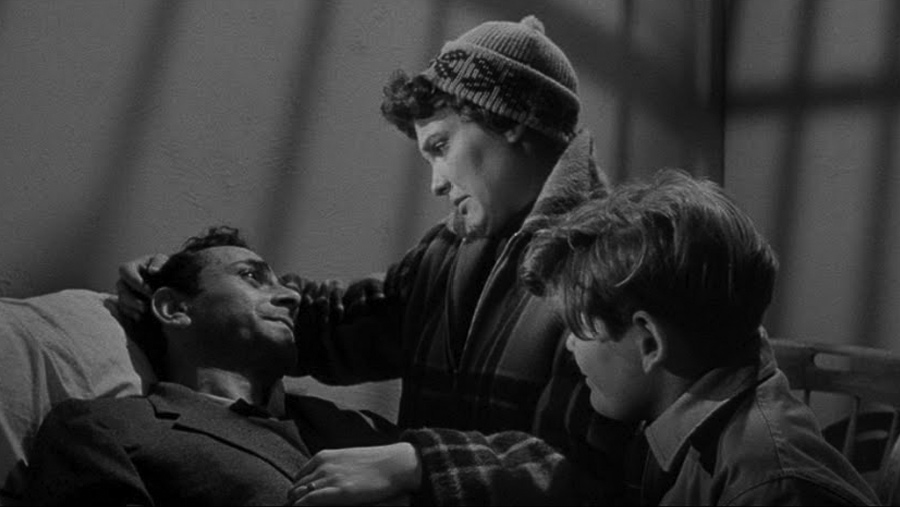








_010.jpg)
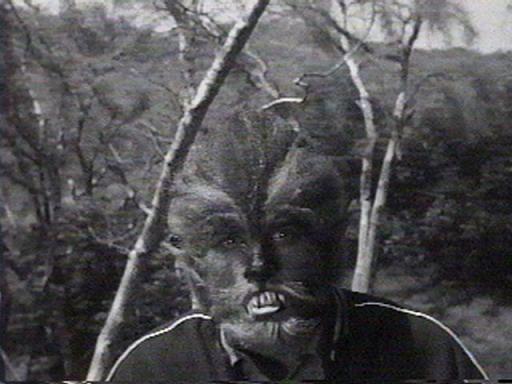









No comments:
Post a Comment